

Realizing Resilience
TOWARD A FAIRER, GREENER FUTURE
A Report from Island Press and The Kresge Foundation
By Laurie Mazur
June 2025
Design by Kelley Lynch/kelleyslynch.com

Island Press has been stimulating, shaping, and communicating ideas that are essential for solving environmental problems worldwide since 1984. With more than 1,000 titles in print and some 30 new releases each year, Island Press is the nation’s leading publisher on environmental issues. As a nonprofit organization, Island Press identifies innovative thinkers and emerging trends in the environmental field and works with scientists, activists, and others to develop cross-disciplinary solutions to environmental challenges.
The Kresge Foundation was founded in 1924 to promote human progress. Today, Kresge fulfills that mission by building and strengthening pathways to equity and opportunity for low-income people in America’s cities, seeking to dismantle structural and systemic barriers to equality and justice. Using a full array of grants, loans, and other investment tools, Kresge invests more than $160 million annually to foster economic and social change. For more information, visit kresge.org.
Sources for uncredited photos are available on request.
Realizing Resilience
TOWARD A FAIRER, GREENER FUTURE
A Report from Island Press and The Kresge Foundation
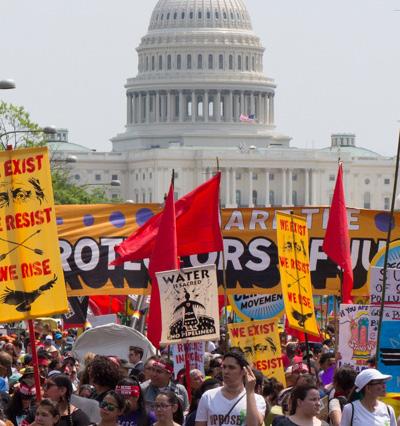
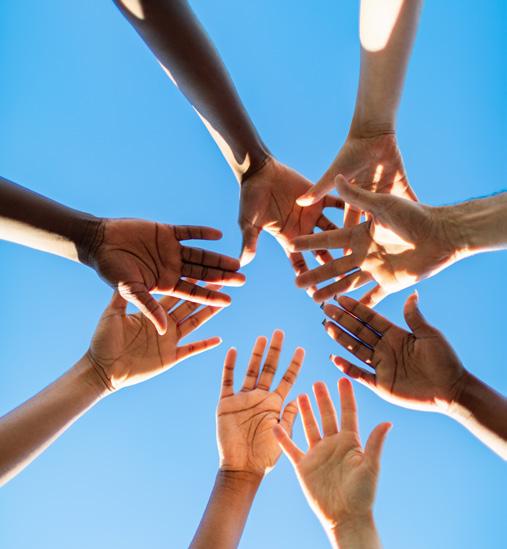

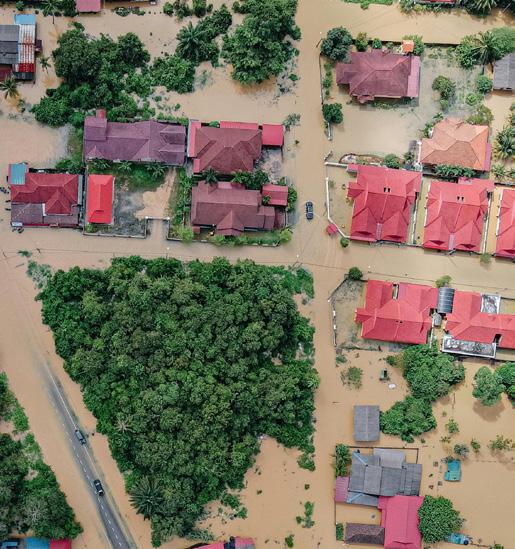




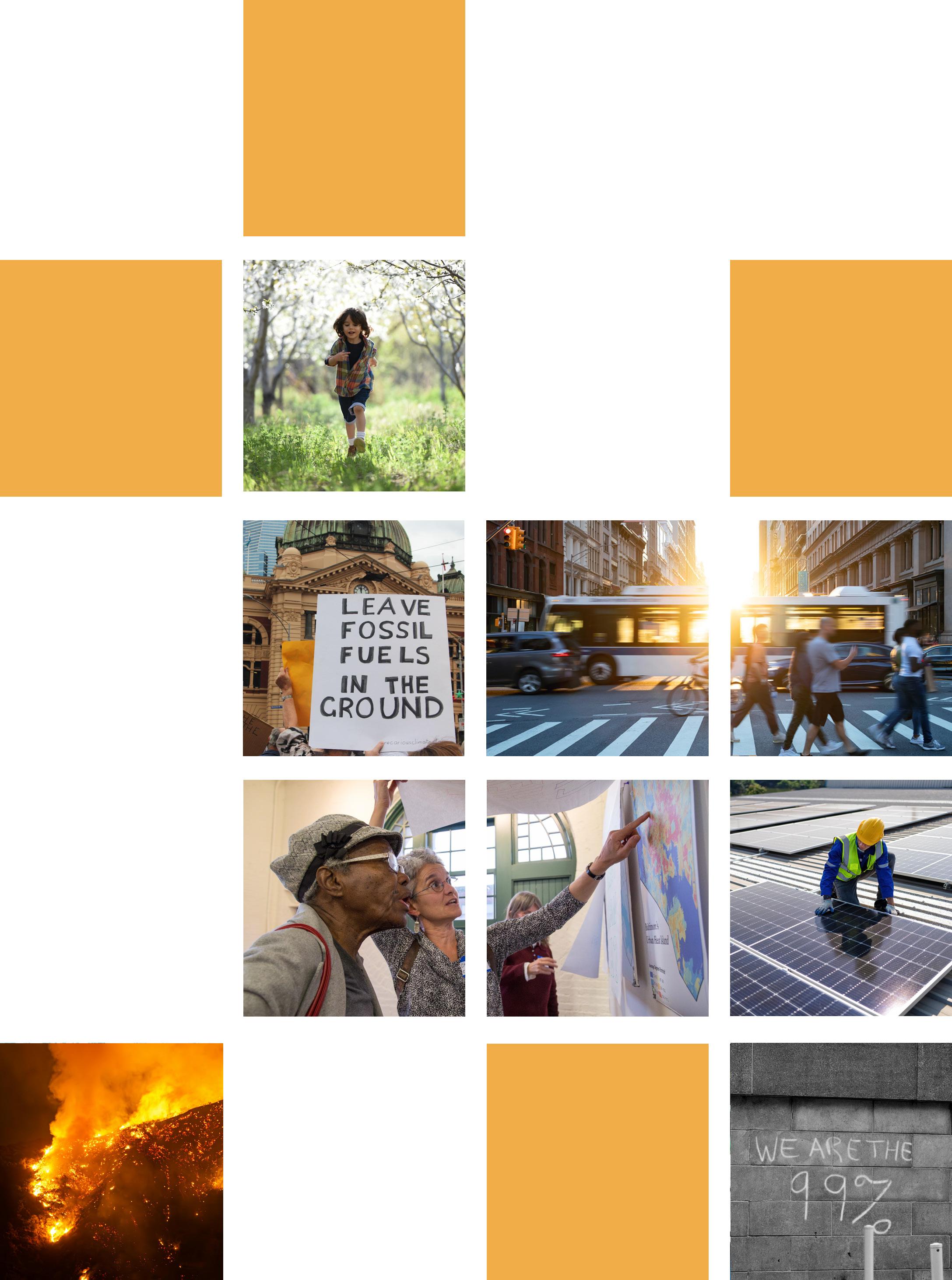
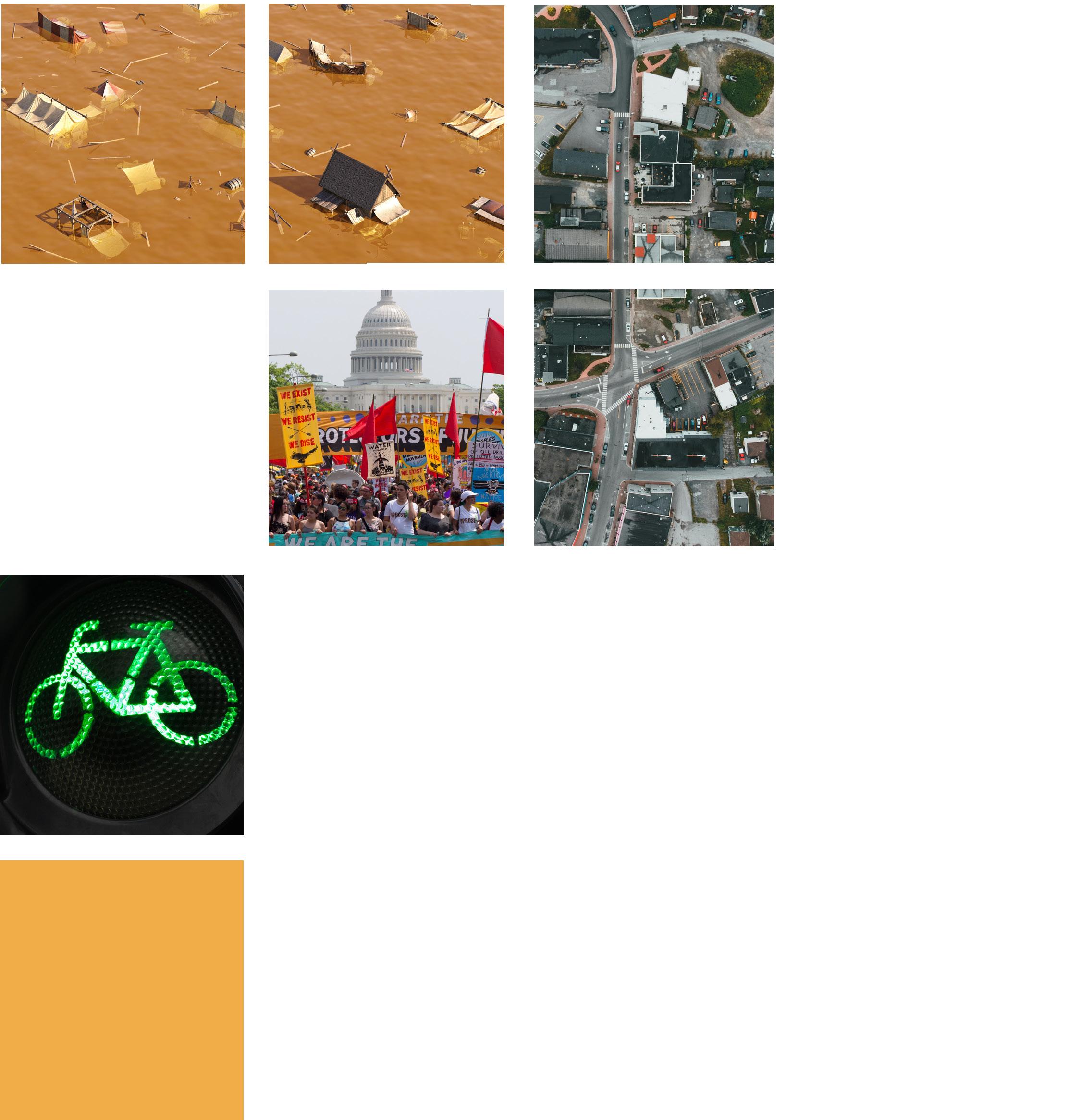
FOREWORD FOREWORD
At Kresge, we imagine a future where people living in U.S. cities are protected from the short- and long-term impacts of climate change because their communities have transitioned to renewable energy, prepared for climate impacts, and prioritized equity to ensure that everyone benefits.

Climate change is an everything and everyone issue. It affects everything we care about as a society: safe and affordable housing, food availability and cost, access to education, physical and mental health, employment opportunities, and national security. Any organization seeking to promote equity and opportunity cannot ignore its impact.
For more than 16 years, The Kresge Foundation has focused its environmental work on equitably reducing carbon emissions and helping communities disproportionately harmed by climate change. Our work seeks to mitigate warming while providing communities with resources to prepare, respond, and recover from storms, floods, fires, heat waves, and other impacts.
At the core of our work is the understanding that policies and practices put in place over generations—and choices still being made today—have resulted in uneven environmental protections, causing people of color, people with low incomes, and other marginalized groups to disproportionately bear the impacts of climate change, adversely affecting their health, well-being, and ability to thrive. Through our deep partnerships in communities across the country, we are keenly aware that climate change is a threat multiplier, exacerbating existing social, economic, and health inequities.
But we have seen in so many communities that progress is possible, and we all have a role to play in finding equitable solutions. And while climate change affects us all, cities, where more than 80 percent of the U.S. population lives, play an essential role in providing critical protection in the face of climate change. At Kresge, we imagine a future where people living in U.S. cities are protected from the short- and long-term impacts of climate change because their communities have transitioned to renewable energy, prepared for climate impacts, and prioritized equity to ensure that everyone benefits.
Cities, where more than 80 percent of the U.S. population lives, play an essential role in providing critical protection in the face of climate change.

To achieve that vision, we must strengthen communities—especially those that have been historically marginalized—by making sure they have the power, resources, and leadership needed to drive climate solutions.
We must invest in community-based organizations, government leaders, community development practitioners, and community financial institutions to create sustainable solutions. And we must strengthen local leadership and publicsector capacity while ensuring racial and economic justice are embedded into decision making and governance.
To help cities combat and adapt to climate change requires the collective action of a broad range of local leaders—across sectors and disciplines—thinking creatively and holistically about how to reimagine and redesign the crucial systems we all rely on to stay safe and healthy.
As we mark 10 years since this paper was first published, our commitment to supporting equitable, holistic, and integrated approaches to climate change adaptation and mitigation has not wavered. Today, our work at the intersection of cities, climate change, and justice couldn’t be more important.
Shamar Bibbins Managing Director, Environment, The Kresge Foundation
Rip Rapson President and CEO, The Kresge Foundation
We must strengthen communities —especially those that have been historically marginalized—by making sure they have the power, resources, and leadership needed to drive climate solutions.
Mark Dixon
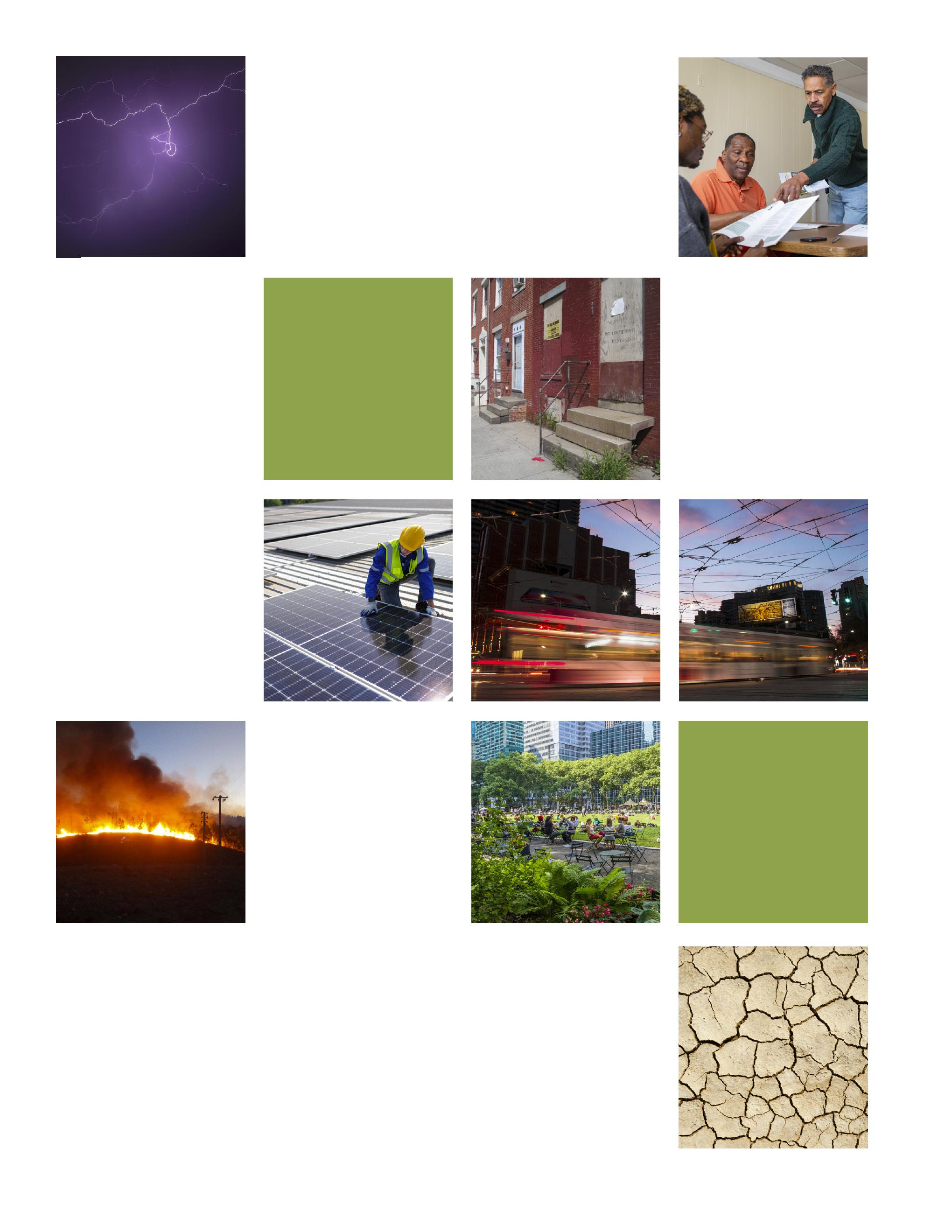

Resilience is the capacity to anticipate, plan for, and mitigate the dangers—and seize the opportunities—associated with environmental and social change.
ABOUT THIS REPORT
How can we make our communities more resilient in the era of climate change and other large-scale disruptions?
Ten years ago, Island Press set out to answer that question. With support from The Kresge Foundation, we did a deep dive on urban climate resilience to help inform the emerging field. We began with a review of the existing literature in various disciplines, then convened an advisory committee and interviewed 40 activists, academics, and others at the vanguard of climate resilience.
The result of that work, Bounce Forward: Urban Resilience in the Era of Climate Change, was published in 2015. The report defined resilience as “the capacity to anticipate, plan for, and mitigate the dangers—and seize the opportunities— associated with environmental and social change.” It emphasized the need to think critically about resilience, to ask what is being made resilient, to what changes or threats, and for whose benefit.
Much has happened in the decade since Bounce Forward was published. So, in 2024, The Kresge Foundation commissioned Island Press to produce an updated report. Our goal was to revisit the framework we developed in 2015, assess progress toward making that vision a reality, and—especially after the 2024 presidential election— consider prospects for advancing resilience in the current political climate. To that end, we interviewed 30 individuals working on diverse aspects of resilience, including several who were consulted for the original report.
We found that the framework presented in Bounce Forward remains an aspirational guide to community resilience. We documented progress, setbacks, and opportunities in several key areas—climate resilience, equity and climate, energy, climate and health, and cities and the built environment. We found that the current moment poses unprecedented challenges as well as promising pathways to resilience. And finally, we uncovered welcome glimmers of hope, even in these dark and uncertain times.
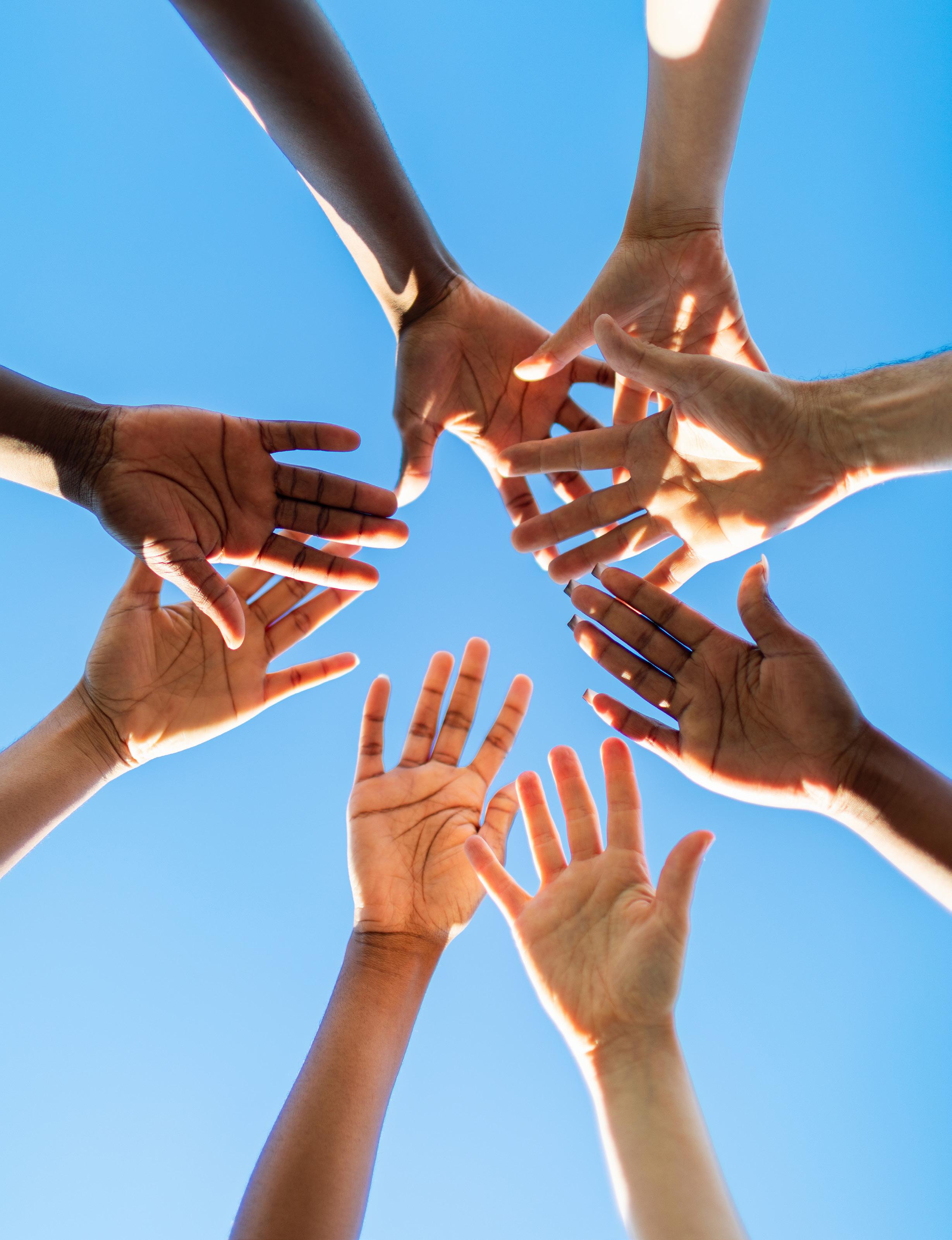
INTERVIEWEES
Zelalem Adefris
CEO, Catalyst Miami
Danielle Arigoni
Director, EPA Region 8 Environmental Justice Division
Shalanda Baker
Professor, Environment and Sustainability, University of Michigan
Shamar Bibbins
Managing Director, Environment Program, The Kresge Foundation
Laurel Blatchford
Senior Fellow, Delivery Associates
Heather Boyer
Editorial Director, Island Press
Lois DeBacker
Former Managing Director, Environment Program, The Kresge Foundation
Anne Evens
CEO, Elevate
Denise Fairchild
Founder, Ubuntu Climate Initiative
Stephen Flynn
Founding Director, Global Resilience Institute, Northeastern University
Lara Hansen
Executive Director, EcoAdapt
Mami Hara
CEO, US Water Alliance
Jeremy Hays
Managing Partner, Upright Consulting Services
Dr. Cheryl Holder
Executive Director, Florida Clinicians for Climate Action
Ayana Elizabeth Johnson
Co-founder, Urban Ocean Lab
Ann Kinzig
Emeritus Professor, Arizona State University School of Life Sciences
Nicole Lampe
Managing Director, Water Hub
Cate Mingoya-LaFortune
Chief Officer of Community Adaptation and Land Use, Groundwork USA
Susanne Moser
Principal, Susanne Moser Research and Consulting
Seth Mullendore
President and Executive Director, Clean Energy Group
Liz Ogbu
Principal, Studio O
Johanna Partin
Principal, Transformative Strategies Consulting
Jacqueline Patterson
Founder, The Chisholm Legacy Project
Michelle Roos
Executive Director, Environmental Protection Network
Linda Rudolph
Principal Investigator, Center for Climate Change and Health, Public Health Institute
Elizabeth Sawin
Director, Multisolving Institute
Nathaniel Smith
Chief Equity Officer, Partnership for Southern Equity
Christof Spieler
Director of Planning, Huitt-Zollars; Lecturer, Rice University

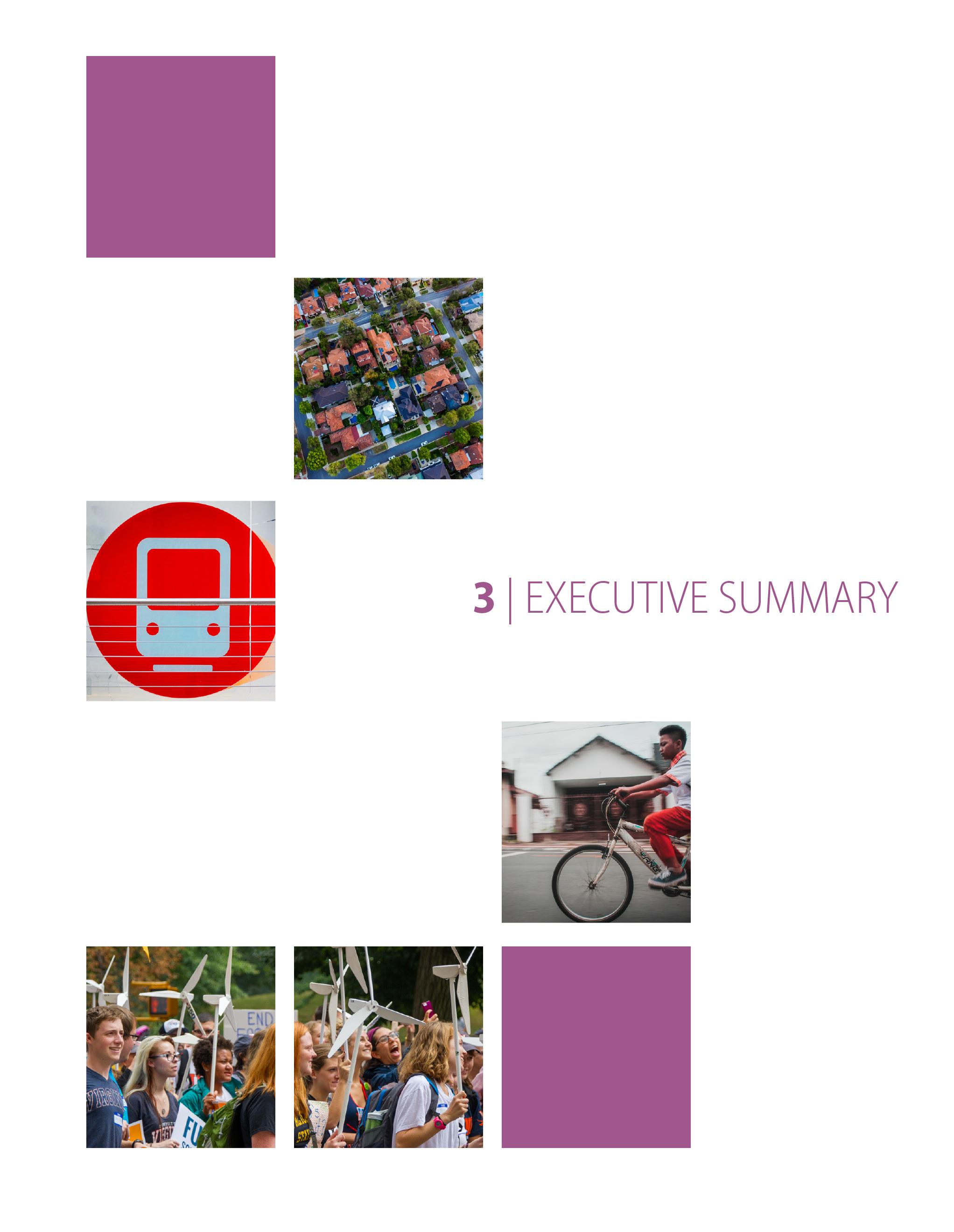
3 | EXECUTIVE SUMMARY
EXECUTIVE SUMMARY
In an era rocked by climate change and other disruptions, our communities must be resilient to survive and thrive. But what does that mean, exactly? In these pages, we offer a vision of resilience that goes beyond simple technical solutions—one that is holistic, intersectional, and rooted in systems change. Through interviews with 30 leaders in climate, energy, health, urban planning, and social justice, we present strategies for advancing equitable resilience in this time of urgent need. Here’s what we learned:

DEFINING RESILIENCE
Resilience is about coping with change. Change is a constant in human and natural history. But today, we have entered an era in which the pace, scale, and impact of change may be greater than anything we have previously confronted. Human beings have destabilized the climate and other natural systems, catalyzing deadly floods, fires, heatwaves, and more. Global networks of commerce and information metastasize disruptions—from financial crises to pandemics. New technologies, including artificial intelligence, could transform our economy and society in ways we are just beginning to imagine. In this context, resilience can be defined as the capacity to anticipate, plan for, and mitigate the dangers—and seize the opportunities—associated with environmental and social change.
There is no “techno-fix” for resilience. Technical solutions—for example, a seawall to prevent flooding—cannot build resilience on their own. That’s because policy reflects deeply entrenched values and power structures. Which community gets the seawall, and what happens to those left unprotected? Who gets to decide, and who benefits from those decisions? Building resilience begins with deep understanding of the social and environmental dynamics that shape our communities—and a willingness to confront the inequities that threaten our safety and well-being.
Human beings have destabilized the climate and other natural systems, catalyzing deadly floods, fires, heatwaves, and more.
Pexels

Resilience requires transformation. Because so many of the systems we rely on are unsustainable and inequitable, resilience is not about “bouncing back” to the status quo. Instead, it calls us to reimagine and remake the systems that supply our energy, transportation, water, and more. It calls us to live within planetary limits, to avoid further destabilizing natural systems. And—importantly—it calls us to eradicate the inequities that magnify vulnerability to disaster, while distributing opportunities more fairly.
It's bigger than climate. Resilience encompasses climate change mitigation and adaptation. But the qualities that promote resilience—including social cohesion and equity—can help communities weather a wide range of disruptions and challenges.
Resilience has its discontents. The term “resilience” has become a popular buzzword, whose meaning is often unclear. Marginalized communities and those reeling from disaster can hear exhortations to be resilient as code for “you’re on your own.” Resilience can be coopted or offered as a substitute for addressing the root causes of environmental and social problems.
Done right, resilience can generate broad support. Community-led resilience efforts, which meet people where they are and align with local values and concerns, have been embraced by many communities, including those that are marginalized and impacted by climate disruption. And, in a moment when “climate change” has become intensely politicized, the term “resilience” retains widespread support.
Resilience is under attack. Polarization, misinformation, and authoritarian leadership at the federal level undercut resilience in myriad ways—at a time when we need to be at the top of our problem-solving game. The Biden administration made historic investments in climate, environmental protection, and environmental justice. But now, the Trump administration has cut funding for climate mitigation,
Because so many of the systems we rely on are unsustainable and inequitable, resilience is not about “bouncing back” to the status quo.
EXECUTIVE SUMMARY
adaptation, and science, leaving communities unprepared as impacts worsen. And other administration policies—including its assault on diversity, equity, and inclusion—erode the social foundations of resilience.
BUILDING RESILIENCE
In addition to the issue-specific recommendations offered in Chapter 5, here are general recommendations for funders, activists, and others seeking a more-resilient future:

Build community capacity. Community-based organizations are the backbone of a resilient society. Groups that have earned trust by responding to local concerns are uniquely prepared to identify and solve community problems. They are also the first line of defense in any disruption—often pivoting to respond to urgent needs (as during the pandemic) before public and private entities can respond. Foundations can sustain and grow these organizations by providing stable, long-term, general support. They can augment community groups’ capacities by networking them with similar groups, and by connecting them to national organizations that provide technical assistance, including legal, communications, and scientific expertise.
Stay the course. This extraordinary political moment is a test of our collective resolve, as many advocates and funders question their strategy and commitments. But evidence shows that recent investments in community-led, equity-centered climate resilience have produced outsized gains. Now, as the Trump administration claws back federal funding, and some foundations pivot from this work, it is vitally important that others redouble their commitment to preserve gains and continue forward momentum.
Keep equity at the center. Working-class communities, people of color, and other vulnerable groups are hit first and worst by climate impacts. For example, neighborhoods that were subject to racist redlining policies received less investment in parks and infrastructure; as a result, they are more prone to flooding and extreme heat. Since inequity is deeply embedded in the problem, equity must be part of solution. That means advocates must continue to educate policymakers and the public about the disproportionate impacts of climate change on marginalized communities. And they must continue to advance community-driven solutions that benefit those most at risk.
Support change at the subnational level. In the vacuum left by federal support, funders and others can scale up local resilience efforts by supporting cooperation among stakeholders: community groups, advocacy organizations, local government, and the private sector. They can focus on policy change in municipal governments, state legislatures, and public utility commissions. And they can build powerful partnerships that span localities and regions, including those with shared geography and resources.
Build connections across issues and movements. In our complex, interconnected world, problems are often linked; for example, people living in poverty are
Children participate in a performance for Catalyst Miami's Community Leadership on the Environment, Advocacy, and Resilience (CLEAR) youth cohort graduation.
Catalyst Miami
disproportionately harmed by climate impacts, and those impacts further exacerbate poverty. But solutions are connected as well, and a “multisolving” approach, which addresses linked problems simultaneously, can also amplify impact. Weatherizing homes, for example, can reduce cost burdens and create jobs while lowering carbon emissions. Multisolving has political benefits as well, by forging new constituencies across sectors and movements.
Support and protect leaders. Leaders catalyze movements; they are nurturers of relationships, holders of institutional memory, and invaluable sources of wisdom and perspective. Funders can back them up by mentoring emerging leaders and convening veteran leaders to regroup and think creatively. It is especially important to support leaders of frontline organizations, who often carry unsustainable burdens. And, amid a rising tide of hate and political violence in the U.S., funders have a special responsibility to help keep leaders safe—online and in person.
Change the narrative. Too often, advocates have failed to connect climate action with top-of-mind issues like health and the cost of living. Funders and advocates can invest in communications that emphasize these tangible benefits. For example, subsidized solar energy can relieve cost burdens for low- and moderate-income homeowners while bending the curve of greenhouse gas emissions. More broadly, narratives have a unique power to capture attention, influence emotions, and shape beliefs and values. Investments in cultural and narrative change can shift power, building durable support for equity-centered resilience strategies.
Amplify the message—and multiply the messengers. Fossil fuel interests have bankrolled a multi-decade effort to discredit climate change and build support for their interests. Advocates of equitable climate resilience will need to mount a comparable effort, utilizing legacy media as well as podcasts, influencers, social media, and arts and culture. Importantly, advocates must amplify the voices of community leaders and others who have earned the public’s trust.
Step in, speak up, and spend down. This moment, shaped by escalating climate disaster and political upheaval, is a full-on emergency. Funders can step in to help by filling some of the gaps left by the federal government and retreating foundations. They can speak up—in unison—for the values they hold and the work they support. And they can increase their grantmaking to levels commensurate with current challenges.
Envision (and create) the world we want. Many of those interviewed for this report predict dark times ahead: climate disasters, political upheaval, a profoundly weakened democracy. But even in this moment, there are opportunities for transformative change. Disruption drives innovation, and communities continue to engage creative problem-solving at the local and regional levels. It is critically important to build on that innovation and craft a comprehensive vision of the world we want. That vision must include resonant values, as well as practical strategies to build resilience and improve human well-being. Amid—and beyond—today’s chaos and disruption, there are opportunities to make that vision a reality.

It is critically important to craft a comprehensive vision of the world we want. Amid—and beyond— today’s chaos and disruption, there are opportunities to make that vision a reality.
Brandon
Black, Drawnversation

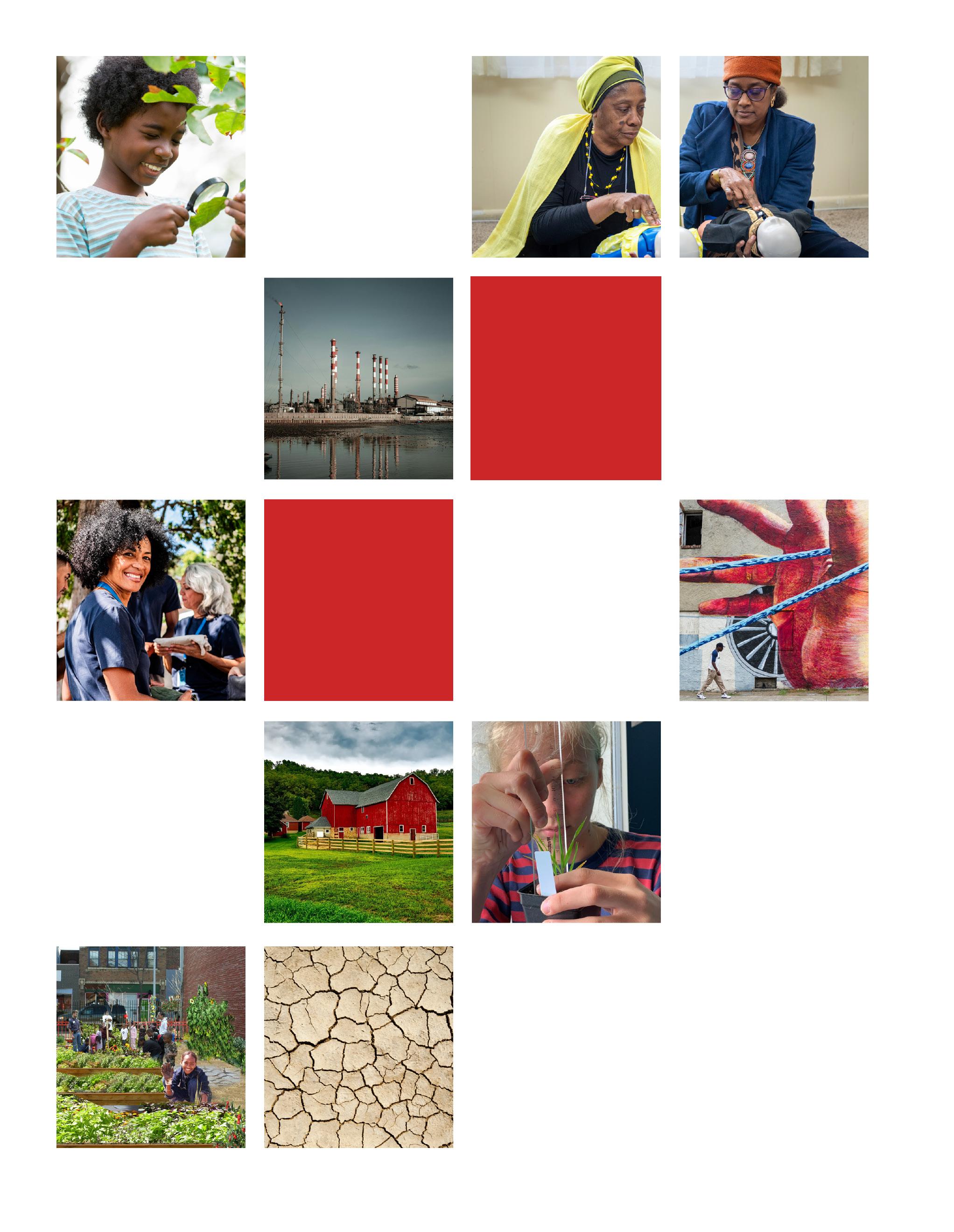
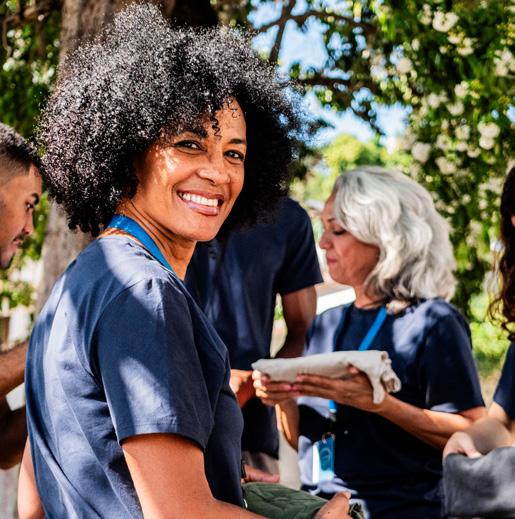








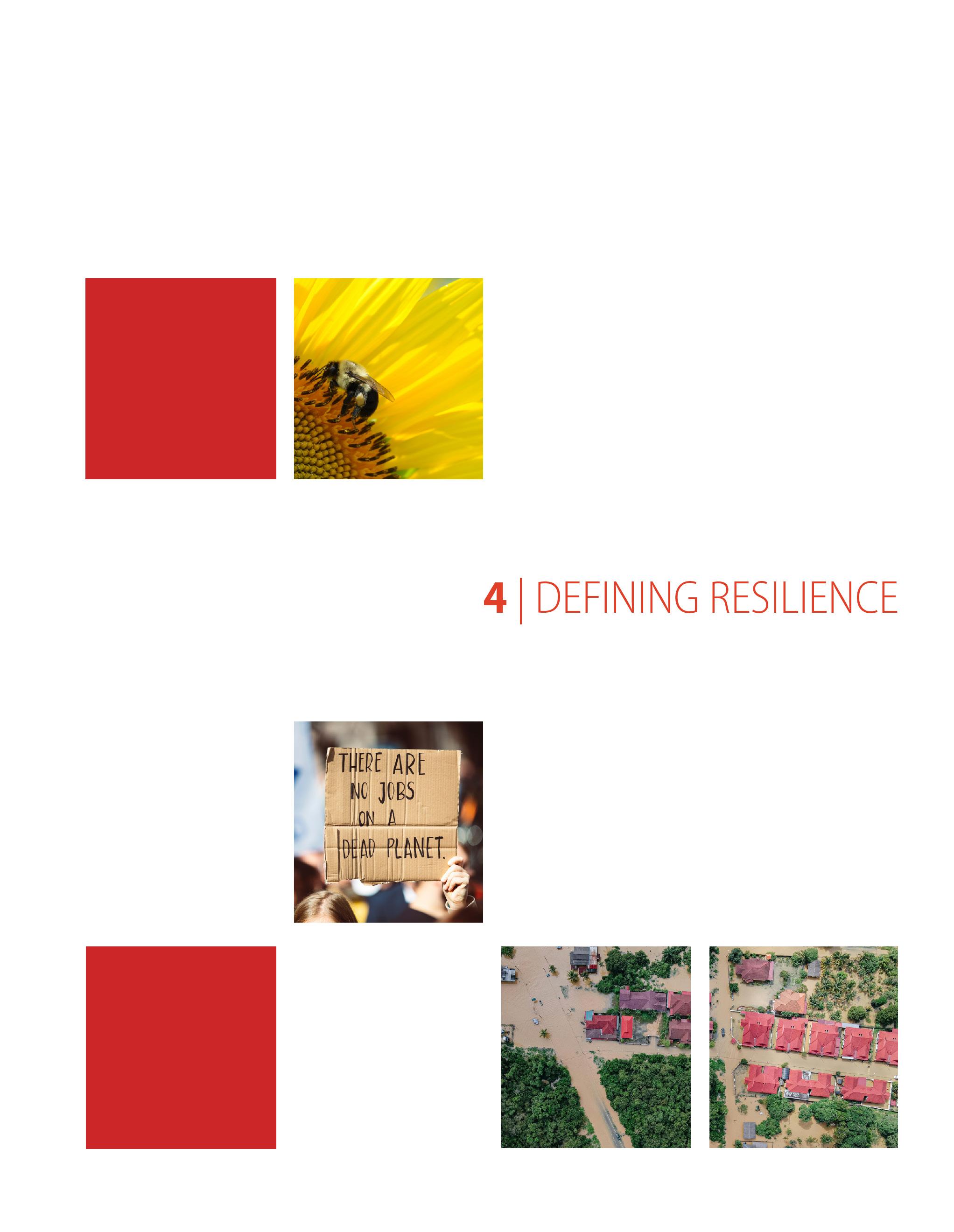
4 | DEFINING RESILIENCE
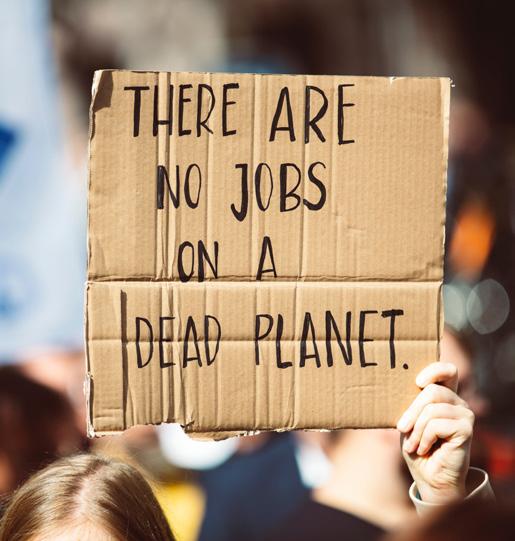
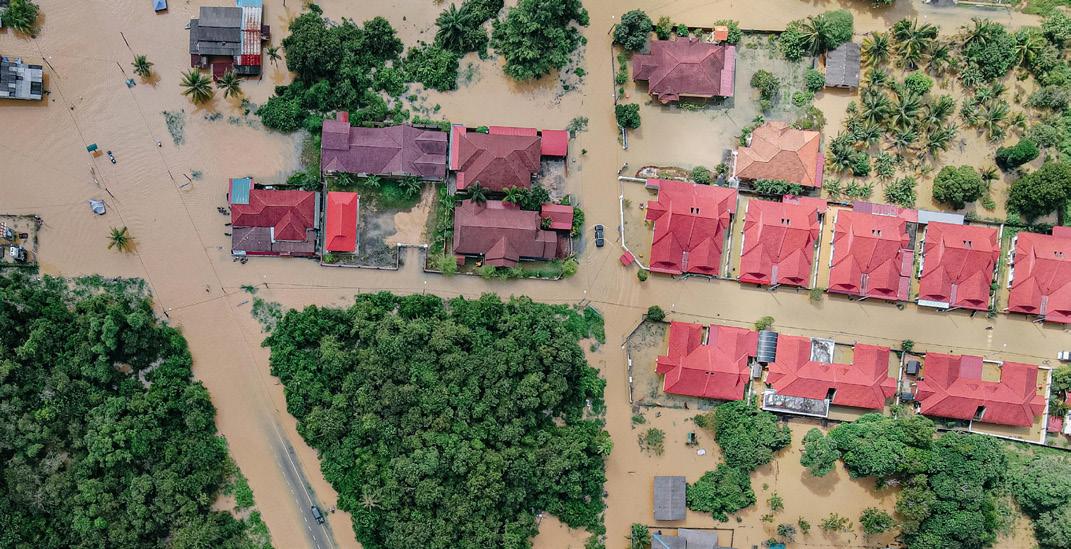
DEFINING RESILIENCE

DEFINING RESILIENCE
AN INTEGRATED FRAMEWORK
Here, we propose an approach to resilience that draws from several academic disciplines and communities of practice: engineering, ecology, the social sciences, and the field of disaster risk reduction. (See the Appendix for a summary of key insights from each.) While these disciplines offer necessary perspectives on resilience, none—on their own—are sufficient to address the challenges that now confront our communities. But taken together, they can inform a holistic, interdisciplinary approach to resilience in the era of climate change.
Resilience is the capacity of a community to anticipate, plan for, and mitigate the dangers—and seize the opportunities—associated with environmental and social change.
The process of building resilience is not value-neutral; decisions about what to protect and strengthen reflect deeply entrenched values and power structures. Therefore, true resilience begins with a searching inventory of the systems that serve our communities, and of their capacity to meet human needs sustainably and equitably.
To that end, those who work to build resilience must first ask what is being made resilient, to what changes or threats, and for whose benefit. They must analyze the systems that supply a community’s needs and reflect its values to determine their resilience in the face of expected and unknown changes. And they must act by protecting, restoring, adapting—and, if necessary, transforming—the systems on which they depend. Moreover, resilience is not an end state; it involves an iterative process of learning and adaptation. Accordingly, the steps outlined here must be frequently revisited as circumstances change.
ASK
Resilience of what?
What do we need?
What do we value?
Resilience to what?
Hazards
Environmental/social changes
Resilience for whom?
Who is vulnerable?
Who decides?
Who benefits?
ASK*
Resilience of what?
What do we need?
ANALYZE
Is it:
Diverse
Redundant
Modular
Responsive
Does it promote:
Social capital
Agency
Equity
Inclusiveness
Innovation
➢ Basic needs: Nutritious food; clean water and air; secure shelter
➢ Health: Physical and mental well-being, supported by accessible health care; protection from toxins and infectious agents; communities that support healthy lifestyles
➢ Economic well-being: Jobs, livelihoods, and social supports that enable people to thrive
➢ Safety and security: Protection from violence, hazards, and harmful disruption
➢ Mobility: Freedom of movement; convenient access to employment, housing, health care, education, commerce, and recreation
➢ Education: Schools and other learning opportunities that enable individuals to fulfill their potential and participate fully in society
What do we value?
➢ Relationships: Personal connections to family and community
➢ Fairness: A just society in which opportunity is available to all and risks are not disproportionately borne by some
➢ Freedom: The capacity to live the life one chooses
➢ Democracy: Representative decision making and an inclusive political process
* These lists are not necessarily comprehensive or universal; they are offered in order to model an approach to thinking about resilience.
ACT
Persist
Protect/restore system in current form
Adapt
Modify system to increase
resilience
Transform
Replace with more resilient system
DEFINING RESILIENCE
➢ Beauty: Aesthetically appealing places to live and work
➢ Nature: Healthy, functioning ecosystems, valued in their own right as well as for the services they provide to human well-being
What are the systems that meet our needs—and reflect our values—at scales from local to global?
➢ Built environment: Buildings; transit systems; water and sanitation systems; energy systems; communications networks
➢ Natural environment: Atmosphere and climate; watersheds and oceans; forests; agriculture and fisheries
➢ Institutions: Governments; economic regulations and markets; legal systems; civil society; the private sector
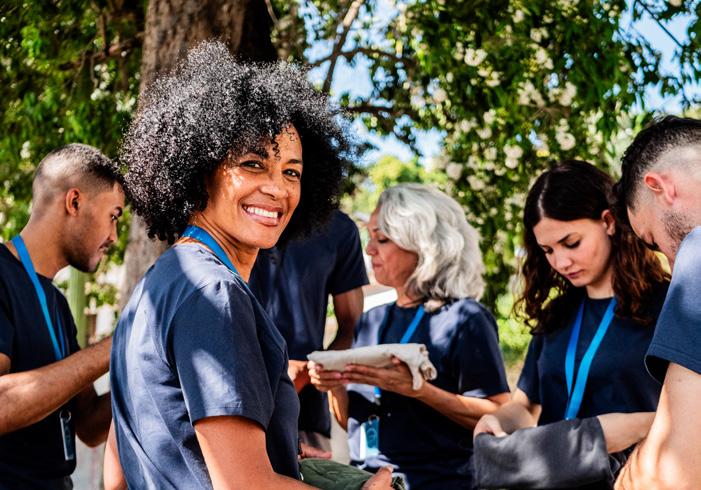
Collaborative processes that incorporate diverse perspectives produce better outcomes.
Resilience to what?
What are likely changes—short- and long-term; positive, negative, and neutral—that will affect existing systems?
➢ Climate change impacts: Drought; flooding; wildfires; sea-level rise; intensified storms; heat waves; changes in distribution of disease vectors; displacement and migration
➢ Other natural disasters: Volcanoes; earthquakes; tsunamis; mudslides
➢ Other environmental crises: Resource depletion; land degradation; pollution/ contamination of air, water, or soil; nuclear disasters
➢ Demographic changes: Population gains or losses; migration; changes in age distribution
➢ Public health issues: Epidemics; changes to food supply, housing, or other systems that impact health; changes in health indicators such as infant mortality and life expectancy
➢ Economic changes: Rise or collapse of key industries; changes in financial or regulatory systems; changes in wealth distribution
➢ Technological changes: Breakthroughs in artificial intelligence, energy, communications, or transportation; obsolescence of existing technologies
➢ Social changes: Institutional or political shifts; rising authoritarianism; outbreaks of violence, terrorism; changes in degree of globalization; gentrification/displacement
➢ “Black Swans”: Highly unpredictable, low-probability, high-impact changes
Resilience for whom?
Who may be affected by changes, and who shapes decision making? Who is vulnerable?
➢ Biophysical: Who lives in proximity to potential threats such as geologic faults, low-elevation coastal zones, or human-made hazards, such as polluting industries?
➢ Social: Who is vulnerable due to lack of resources and power; discrimination based on race, class, gender, age, sexual orientation; frailty/poor health? Who decides, and who benefits?
➢ Decision making: What are relevant decision-making processes? How are decisions made at different scales: family, neighborhood, city, region, state, nation, world—and in a range of sectors: civil society, government, industry?
➢ Representation: Do stakeholders—particularly the most vulnerable— participate in those processes and have agency to shape and influence decision making? What are barriers to participation, and how can they be overcome?
➢ Outcomes: Do interventions produce equitable benefits for all?
ANALYZE
Assess the resilience of existing systems. Is the system:
Diverse: A system with many different components will have a wide range of responses to change and is therefore unlikely to fail all at once. For example, a city with a diverse economic base is less vulnerable to economic upheaval than one that relies on a single industry. In governance and decision making, a collaborative process that incorporates a variety of actors and perspectives is likely to produce better outcomes.
A system with many different components will have a wide range of responses to change and is therefore unlikely to fail all at once. For example, a city with a diverse economic base is less vulnerable to economic upheaval than one that relies on a single industry.

DEFINING RESILIENCE
Resilient
people
have
a sense of control over their destiny; resilient communities fully engage their citizens in decision making.
Redundant: Similarly, a resilient system has multiple ways to perform basic functions, so that the failure of any one component does not cause the entire system to crash. A multimodal transportation system that includes a variety of public transit options as well as opportunities for walking and bicycling will weather disruptions better than a system that relies wholly on automobiles.
Modular: Modular systems in which individual units retain some self-sufficiency when disconnected from larger networks will fare better in times of change. For example, people living in a city with a robust local food culture (e.g., nearby farms, a farmer’s market) will be less likely to go hungry if there is a disruption in national or global supply chains. Modularity allows a system to manage its connectivity to larger regions and the world; it is a way to reinstate “firebreaks” that have been lost in a hyper-connected, globalized economy.
At a community Resiliency Hub in Petersburg, VA, residents can take classes to improve their health and well being. Here, a class on CPR for infants.
Responsive: A resilient system has “tight feedbacks,” allowing it to quickly detect changes in its constituent parts and respond appropriately. Tight feedbacks enable swift responses to changing conditions. If a reservoir is low, for example, water conservation measures may be put in place. But, in today’s globalized economy, consumers may be thousands of miles away from the source of resources on which they depend—so feedback loops go slack. Inequality also weakens feedbacks, as affluent communities routinely outsource production and pollution to poorer ones.

Does it promote:
Social capital: For an individual, social capital is about relationships with family, friends, and colleagues. In communities, social capital can be measured by levels of trust, the cohesion of social networks, and the quality of leadership. Resilient communities with ample social capital often have strong community-based organizations; public spaces that encourage interaction, and participatory, inclusive governance.
Agency: Resilient people have a sense of control over their destiny; resilient communities fully engage their citizens in decision making. Fundamentally, agency is about power, both personal and political. Strategies to build agency include the following: community organizing; public health and safety initiatives; and civic engagement.
Equity: Equity means that opportunities are equally shared, and everyone has what they need to thrive. It is a building block of social cohesion—the sense that “we’re all in it together” that enables communities to cooperate in times of disaster. And equity improves performance on a broad range of human development indicators that form the bedrock of individual and community resilience.
Inclusiveness: Inclusive social institutions—economic, political, and cultural—can strengthen resilience at every level, by increasing social capital, agency, and equity. In an inclusive society, power and opportunity are shared broadly, not concentrated in the hands of a few. Inclusive governance has practical benefits. For example, it tightens feedback loops so that problems are more readily detected, and it expands the depth and diversity of knowledge available for problem solving.
Innovation: A resilient system generates novel responses while learning and adapting to changing conditions. In nature, this is accomplished by evolution. In human society, it requires innovation—the ability and willingness to try new things. The capacity to innovate derives from many of the qualities just described. A diverse system generates more novelty than a monoculture; in social systems, innovation often comes from the margins. An inclusive society is better able to engage the agency and creativity of all of its citizens. And a responsive system with tight feedbacks has timely and accurate information about changing conditions, which is essential for positive innovation.
ACT
Armed with an understanding of what we want to make resilient and of the resilience or vulnerability of existing systems, the next step is to act:
➢ Persist: Protect (or restore) the existing system in its current/preexisting form (restore wetlands; reinforce bridges; rebuild after disaster).
➢ Adapt: Modify the system to increase resilience, using the above criteria as a guide (decentralize food and energy systems; adapt buildings and infrastructure to rising sea-levels; build social capital through inclusive governance).
➢ Transform: Replace the existing system with one that is more resilient (shift from fossil fuels to renewable energy; replace authoritarian governance with inclusive decision-making processes; build economic alternatives such as worker-owned cooperatives).

A resilient system generates novel responses while learning and adapting to changing conditions. In nature, this is accomplished by evolution. In human society, it requires innovation.
DEFINING RESILIENCE
AN EVOLVING CONCEPT
In the decade since Bounce Forward was published, the integrated framework outlined above has remained relevant and useful. At the same time, the popular concept of “resilience” has evolved:
An integrated view of social and ecological resilience is taking hold. Many of the themes of Bounce Forward, amplified by Kresge grantees and others, have been embraced by governments and other decision makers.1
There is growing awareness of the disproportionate impact of climate disaster on working-class communities and people of color, and of the need for a moreequitable response.2 Today, it is more widely understood that resilience is not value-neutral; decisions about what and who is protected—and about who gets to decide and who benefits—reflect prevailing values and power structures. Bouncing back can be maladaptive, if the status quo is unsustainable and inequitable. The Intergovernmental Panel on Climate Change (IPCC) acknowledges this danger: its current definition states that “Resilience is a positive attribute when it maintains capacity for adaptation, learning and/or transformation.”3
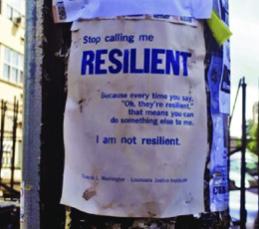
Resilience has its discontents. As a buzzword, “resilience” has drawn ample criticism. Indeed, the term can be coopted or offered as a substitute for addressing the root causes of environmental and social problems. For example, the American Enterprise Institute, which opposes efforts to reduce greenhouse gas emissions, has promoted what it calls the “resilience option” for climate change—in short, deal with it.4 And fossil fuel companies regularly tout their commitment to climate resilience.5
In popular parlance, resilience “is often used merely as a ‘feel good’ expression of the ability to keep going in the face of adversity,” write consultants Susanne Moser and Joyce Coffee.6 Worse, for people in marginalized communities that bear the brunt of climate change impacts, resilience can be heard as an imperative to fend for themselves.7 This reflects a culture that celebrates individual grit rather than mutuality and social support.8 Not surprisingly, frontline communities often reject the term.9
Still, resilience remains a useful frame. Done right, resilience can generate broad support. Community-led resilience efforts, which take a holistic approach and align with local values and concerns, have been enthusiastically embraced by activists in marginalized and climate-impacted communities. “People don’t live single-issue lives,” says Jeremy Hays, managing partner of Upright Consulting Services, “so we can’t have single-issue strategies. To the extent that an equitable climate resilience frame helps people understand the intersections and root causes of our problems and solutions, it is really useful.”10
And, in a moment when “climate change” has become intensely politicized, the term “resilience” retains widespread support. According to a Water Hub analysis, “Voters generally support resilience efforts, and a strong majority respond positively to the word.” It is notable, however, that terms like “preparedness” or “protection” elicit an even more-favorable response.11
The term “resilience” can be coopted or offered as a substitute for addressing the root causes of environmental and social problems.
Tracie L. Washington/Louisiana Justice Institute



5
|
PROGRESS AND PROSPECTS
Today, we have entered an era in which the pace, scale, and impact of change may be greater than anything our species has previously confronted.
PROGRESS AND PROSPECTS
THE FIERCE URGENCY OF NOW
In an era of unprecedented change, we need resilience more than ever. Change is a constant in human and natural history. But today, we have entered an era in which the pace, scale, and impact of change may be greater than anything our species has previously confronted. Human beings have destabilized the climate and other natural systems, catalyzing deadly floods, fires, heatwaves, and more. Global networks of commerce and information metastasize disruptions—from financial crises to pandemics. New technologies, including artificial intelligence, could transform our economy and society in ways we are just beginning to imagine. And, at this writing, the second Trump administration has launched an unparalleled assault on political institutions and norms.
“History doesn’t repeat itself, but it rhymes,” the saying goes. But the future may be more discordant. And, if recent years are any indication of where we are headed, that future will be punctuated by more-frequent environmental, economic, and social crises.
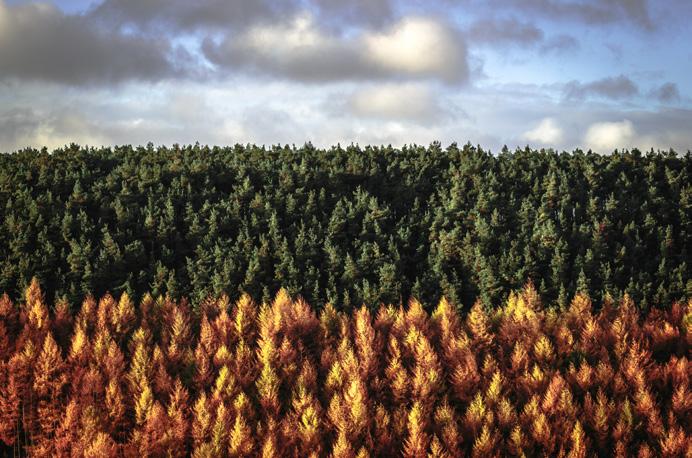
Climate change has arrived. Long predicted, climate change is now a daily reality across the globe. Human activity has raised atmospheric CO₂ to levels not seen in two million years, raising global temperatures by about 2°F. Without substantial changes, scientists predict the Earth could warm by 5.6° to 7.9°F by the end of the century—an outcome the Intergovernmental Panel on Climate Change (IPCC) says “would be catastrophic to human civilization.”1
Today, we may be nearing climate “tipping points” that could fundamentally alter the conditions that have allowed humanity to thrive.2 Natural systems are inherently resilient, but warming the planet beyond certain levels could abruptly shift those systems into different states—“Not like the turning of a dial, but the flipping of a
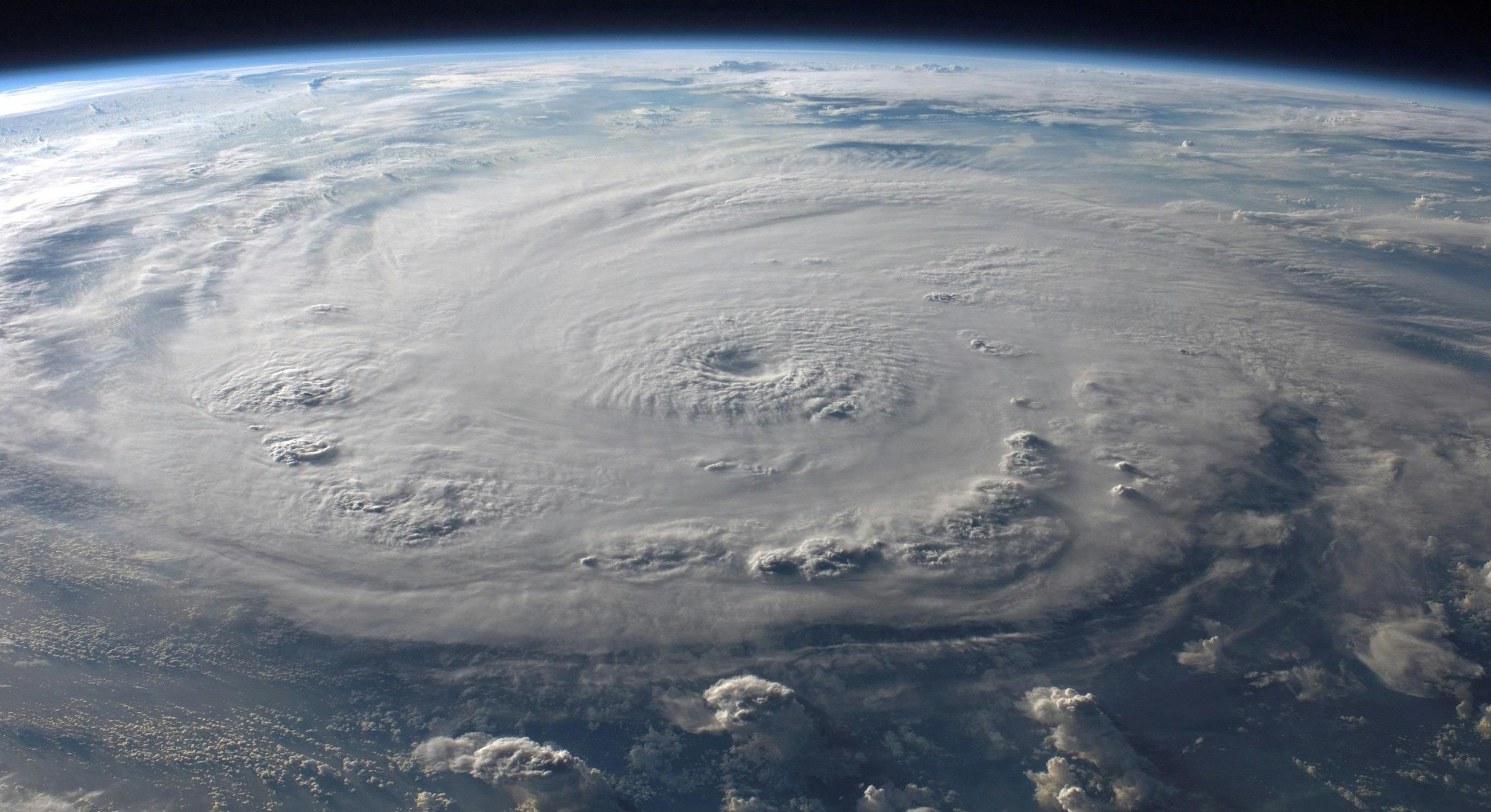
switch,” write Raymond Zhong and Mira Rojanasakul in The New York Times. Some changes, like the mass death of coral reefs, thawing permafrost, and the loss of polar ice, would be impossible to reverse.3
And it’s not just the climate. The Stockholm Resilience Center tracks ecosystems across the planet to determine whether human-made changes have passed dangerous boundaries that herald irreversible change. Today, six of the nine boundaries have been crossed.4
Climate impacts are worsening. In 2024, Americans endured 27 major weather disasters, which killed 568 people and cost at least $182.7 billion. It was the secondhighest number of billion-dollar weather disasters in history, just behind 2023.5 The number and severity of such disasters has increased steadily since 1980, as carbon emissions and global temperatures climb.6 And our failure to bend the curve of carbon emissions guarantees that climate impacts will only get worse. “The weather will never be better than this,” says Jeremy Hays, managing partner of Upright Consulting Services. “We’re going to look back on these crazy wildfire and storm seasons as the good times.”7
The landscape of risk is changing too. For example, while hurricanes once took more lives in coastal counties, we now see more deaths from freshwater floods in inland areas.8 In part, that is because a warmer atmosphere holds more water vapor, so storms bring more rain.9 This was tragically apparent in the fall of 2024 when Hurricane Helene devastated Asheville, North Carolina—a city previously considered a “climate haven.”10
Cascading disasters are now the norm. Hazards, such as hurricanes and disease outbreaks, are nothing new in human history. But in our wired, hyperconnected world, hazards spread with lightning speed and spark cascading disasters.
In 2024, Americans endured 27 major weather disasters, which killed 568 people and cost at least $182.7 billion.
Pexels/Pixabay
PROGRESS AND PROSPECTS
In the U.S., more than two-thirds of all wealth is owned by the richest ten percent; the bottom half holds just 2.5 percent.
Globe-spanning networks of travel and trade spread good things, like innovation and opportunity, but they also propagate harm. The first cases of COVID-19 were diagnosed in Wuhan, China, in December, 2019; by March of 2020 the disease had spread to every country on Earth.11 And the financial crisis that began in 2007 was triggered by risky mortgage lending in the U.S., but its repercussions were felt across the globe.
At the same time, modern societies are dependent on infrastructure and economic arrangements that are increasingly vulnerable to disaster. Flooding in Asheville, NC, destroyed the city’s water infrastructure, leaving residents without potable water for nearly two months.12 The COVID-19 pandemic snapped global supply chains, causing long-lasting shortages of medicine and other necessities.13
Power outages can be especially deadly—especially when combined with extreme heat—as they disrupt vital services like refrigeration, water and sewerage, telecommunications, and transportation.1⁴ One of the nation’s deadliest storms, Hurricane Maria in 2017, destroyed Puerto Rico’s power grid, leaving 3.4 million people without electricity. Many of the nearly 3,000 deaths in that disaster are attributed to the loss of power, which closed hospitals and left residents unable to purify drinking water.1⁵
Inequality heightens vulnerability. We live in a world of stark inequality. Globally, the richest one percent of the population lays claim to 44.5 percent of the world’s wealth, while nearly three billion of the world’s poorest people possess just over one percent of global assets.1⁶ In the U.S., more than two-thirds of all wealth is owned by the richest 10 percent; the bottom half holds just 2.5 percent—the highest level of inequality among G7 nations.1⁷ The wealth and income gap between White and Black Americans, produced by centuries of racist policy and practice, persists.
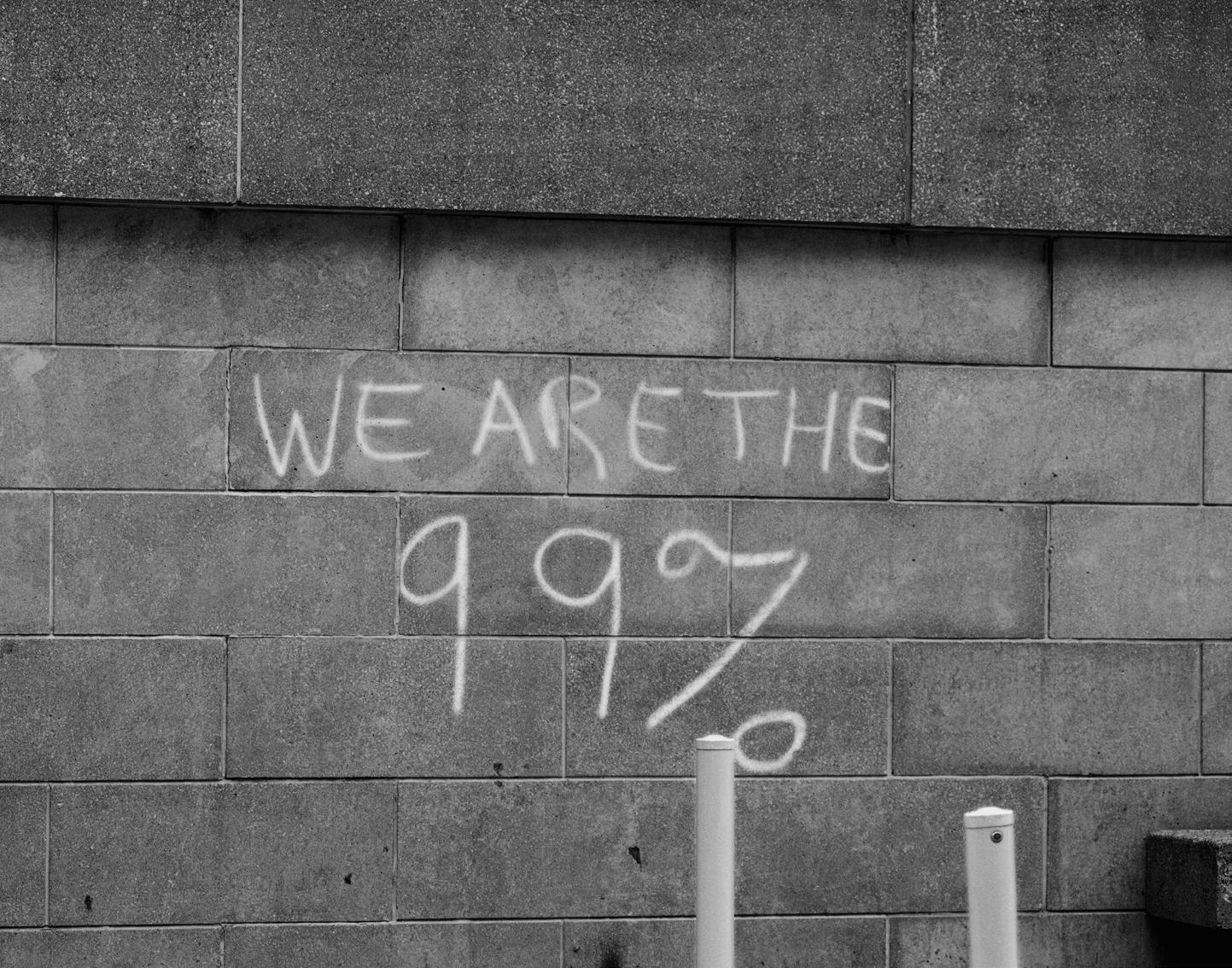

Today, White Americans earn about $33,000 more each year and hold $240,120 more in household wealth than Black Americans, a gap that has grown since 1970.1⁸
Inequality means that climate risks fall disproportionately on working-class communities and communities of color.1⁹ While they may be rich in social capital, these communities often lack the financial resources to prepare for, and recover from, climate disasters. These dynamics are self-perpetuating: the affluent consolidate their gains while marginalized communities fall further behind—a widening spiral of inequality and exclusion.
An aging population is more vulnerable to climate impacts. In the U.S. today, climate change is colliding with a new demographic reality: Americans over the age of 65 will soon outnumber those under 18 for the first time in history.20 As Danielle Arigoni observes in her book, Climate Resilience for an Aging Nation, climate-fueled disasters can be a matter of life and death for older adults.21 For example, when Hurricane Katrina tore through Louisiana in 2005, over two-thirds of the more than 1,300 people who died were older than 60; nearly half were over 75.22
The U.S. is retreating from its commitment to building resilience. The problems outlined above vividly illustrate the need for greater societal resilience. But, at this writing, it is clear that the policies of the second Trump administration undermine resilience on several fronts:
Backsliding on climate mitigation and adaptation. As explained in Chapter 5.1, the last decade saw significant gains on climate policy—notably the Biden administration’s $391 billion investment in climate initiatives through the Inflation Reduction Act.23 During the 2024 presidential campaign, Trump promised fossil
Inequality means that climate risks fall disproportionately on working-class communities and communities of color.
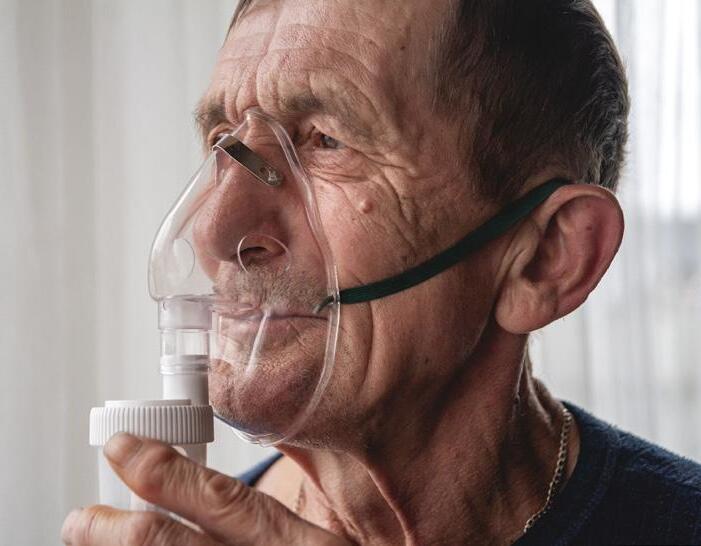
Climate-fueled disasters can be a matter of life and death for older adults.
A home in New Orleans’ Lower Ninth Ward after Hurricane Katrina.
Skodonnell/iStock
PROGRESS AND PROSPECTS

fuel executives that he would roll back those efforts in exchange for a $1 billion contribution.2⁴ Now he is making good on that promise by, for example, challenging the Environmental Protection Agency’s (EPA) determination that greenhouse gases are harmful, blocking or rescinding climate funding, gutting the EPA and other agencies charged with protecting the environment, and scrapping cleaner, cheaper renewable energy in favor of “drill, baby, drill” fossil fuel dependence.2⁵
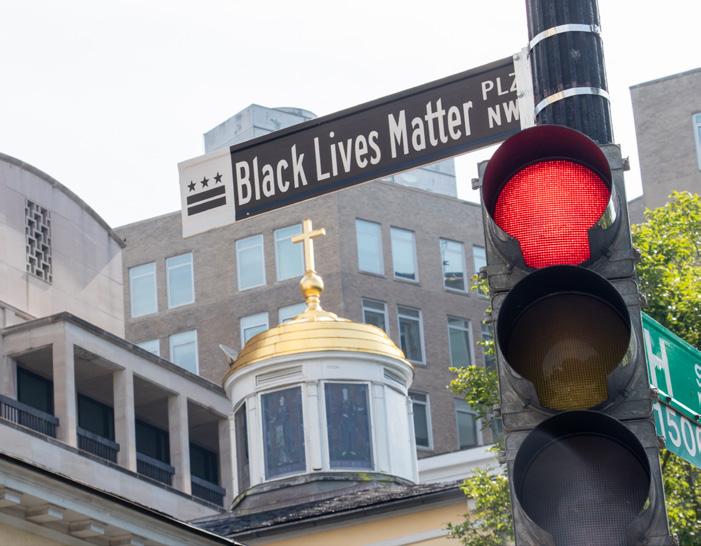
Assaulting diversity, equity, and inclusion (DEI). Trump has launched a ferocious attack on DEI efforts in government, education, and the private sector.2⁶ But, as explained in Chapter 4, each element of DEI is essential to building a resilient society. From forests to social institutions, diverse systems are less vulnerable to disruption than monocultures. Equity is a building block of social cohesion, which enables communities to cooperate in challenging times. And an inclusive society, where power and opportunity are broadly shared, expands the depth and diversity of knowledge available for problem solving.
Removing checks and balances. The Trump administration is trampling Constitutional safeguards intended to prevent the consolidation of power in any one branch of government—by sidelining Congress, ruling by executive order, and ignoring the courts.2⁷ If successful, this broad expansion of presidential power will weaken representative democracy and erode resilience. That is because democratic systems, in which people have more agency and control of their lives, are more resilient to climate disaster and other threats.2⁸
Silencing dissent. Resilient governance is responsive, soliciting information from all levels and sectors of society. In contrast, autocratic leaders rule from the top down, punishing dissent and creating a climate of fear. By silencing divergent views, such leaders lose critical feedback loops, depriving themselves of information needed for effective decision making. Indeed, this leadership style has been blamed for everything from military defeats to plane crashes.2⁹ In his second administration, Trump has assumed an increasingly autocratic posture. As The New York Times
Callum Shaw/Unsplash
editorial board observes, “Officials in Washington [are] stripping federal websites of any hint of undesirable words and thoughts, disciplining news organizations that refuse to parrot the president’s language, and threatening to punish those who have voiced criticism of investigations and prosecutions.”30
Dismantling and disregarding science. At the same time, the Trump administration is rooting out government scientists and agencies that supply vital information about climate change. For example, cuts to the National Oceanic and Atmospheric Administration (NOAA) make it harder to track extreme weather and measure atmospheric concentrations of greenhouse gases.31 But silencing “inconvenient truths” about climate change will not lessen the threats we face; it will only leave us less prepared to address them.
Redistributing wealth upward. Policies proposed by the Trump administration— tax breaks that disproportionately benefit the wealthy and large corporations, cuts to social programs for low-income people—would redistribute wealth to the affluent and worsen inequality.32 This, too, erodes resilience by reinforcing the disproportionate impact of climate change on working-class communities and people of color. And it imperils democracy: money buys power that can distort, or destroy, the democratic process.33
Depleting social capital. Even before the current administration, our nation’s social capital was diminishing. Political polarization has grown as Americans sort themselves into not just different political parties, but seemingly separate realities. Polarization is not just about holding different opinions, says Ann Kinzig, emeritus professor in the School of Life Sciences at Arizona State University: “A diversity of ideas sharpens thinking. But what we see today is affective polarization, where people with divergent views hate and mistrust each other.”3⁴ In this way, polarization destabilizes societies, makes compromise and policymaking more difficult, and raises the risk of political violence. Trump is deepening affective polarization, by demonizing those who disagree with him, and calling his political foes “vermin” and “enemies from within.”3⁵
Silencing “inconvenient truths” about climate change will not lessen the threats we face; it will only leave us less prepared to address them.
Below, we delve into recent progress and future prospects in five areas: climate resilience; equity and climate; energy; climate and health; and cities and the built environment. These are not the only issues that determine societal resilience, but we believe they are among the most critical.
Given the interconnected nature of these issues, these chapter divisions are somewhat arbitrary. For example, shifting from fossil fuels to renewable energy is a climate resilience issue, an energy issue, a health issue, and an issue for cities and the built environment. And equity is central to meaningful progress on all fronts. As such, there will be some repetition and overlap in the sections below. Still, these chapters, taken together, should provide an overview of the last decade’s advances and setbacks, and prospects for progress toward resilience in the current environment.

CLIMATE RESILIENCE
ADVANCES AND SETBACKS
The U.S. has made historic investments in climate mitigation and resilience. In 2022, President Biden signed the Inflation Reduction Act (IRA)—the nation’s largest-ever investment in climate initiatives—allocating $391 billion for clean energy, climate justice, and more.1 The IRA was designed with equity at its core: almost three-quarters of the IRA’s clean-energy investments were targeted to counties with median household incomes below the national average.2
The federal government also made new investments in coping with climate disaster. While federal disaster spending has historically focused on recovery, Congress created the Community Development Block Grant Mitigation program in 2018, and the Building Resilient Infrastructure and Communities (BRIC) program in 2020, to boost investment in risk reduction.3 Other funds for disaster mitigation were included in the Infrastructure Investment and Jobs Act and the STORM (Safeguarding Tomorrow through Ongoing Risk Mitigation) Act.⁴ The Biden administration also changed rules that could help break the costly cycle of rebuilding at taxpayers’ expense, by requiring flood-damaged public infrastructure to be rebuilt in a way that prevents future damage.⁵ Still, as disasters grow in scope and frequency, the need for climate resilience outpaces spending.⁶
Climate impacts and market forces are driving adaptation. The sheer toll of climate disaster is forcing policy change, even in states that refuse to recognize manmade climate change as a problem. For example, as insurance companies flee vulnerable states and raise rates, policymakers are developing strategies to keep insurers in their states by climate-proofing their housing stock.⁷ Deep-red Alabama launched a program that provides grants to homeowners to stormproof their homes, which has since been duplicated in Louisiana and elsewhere.⁸ And Alabama’s coastal counties, like Florida and other vulnerable jurisdictions, have adopted stringent building codes to limit damage and keep residents safe.⁹
Flooding in New Orleans’ Ninth Ward, April 2025.

With new support, frontline groups notched wins on climate. While they are still underfunded relative to national environmental groups, community-based organizations received a wave of new support in the last decade. “I have never seen this much funding go toward the organizing and community governance work before,” says Cate Mingoya-LaFortune, chief officer of community adaptation and land use at Groundwork USA. “The Kresge Foundation was ahead of the curve in supporting that work, and it seems like everybody’s starting to catch up with them, including the federal government.”10
Empowered with added support, frontline groups formed networks and won important victories. For example, Catalyst Miami joined with other groups to mobilize local investments in climate resilience. “In 2015, Miami-Dade County didn’t have any funding allocated to address climate change,” says Zelalem Adefris, CEO of Catalyst Miami. Now, thanks to the work of her organization and others, the county has an Office of Environmental Risk and Resilience with a multimilliondollar budget.11
And in Portland, Oregon, the Coalition of Communities of Color won a 2018 ballot initiative to create the Portland Clean Energy Fund, which has since invested $883 million in renewable energy, energy efficiency, job training, green infrastructure, and other climate-resilience initiatives, prioritizing benefits to low-income residents and people of color. The Fund’s revenue comes from a 1 percent surcharge on revenue generated in Portland by retail corporations that take in more than $1 billion each year.12
Frontline groups can have impact far beyond their community borders by spurring policy change at the state and national levels. For example, the Equitable and Just National Climate Platform, developed by frontline advocates in partnership with national environmental groups, helped shape Biden’s Justice40 initiative, which worked to deliver 40 percent of federal climate and clean energy investments to marginalized communities.13
Above: Community members gather at Parker Village in Highland Park, Michigan, a solar-powered resiliency hub and community garden that’s part of the Highland Park Community Crisis Coalition.
Frontline groups can have impact far beyond their community borders by spurring policy change at the state and national levels.
PROGRESS AND PROSPECTS
“We need an IRA-sized investment every year, until we catch up on redesigning the structure and function of society.”
—LARA HANSEN, EXECUTIVE DIRECTOR OF ECOADAPT
Even in the current political climate, investments made in community-based groups over the last decade are likely to have an enduring impact. “There’s still a lot of strength and possibility at the hyperlocal level,” says Mingoya-LaFortune. “Those bonds, those connections, those community relationships are not going anywhere, regardless of who is in power at the federal level.”1⁴
The climate adaptation field has matured… As climate change impacts have increased, the adaptation field has grown in personnel and expertise. “Twentyfive years ago, the people working on adaptation could all fit in an elevator,” jokes Lara Hansen, executive director of EcoAdapt.1⁵ Today, there are thousands—in government, community-based organizations, and national nonprofits. Since 2013, EcoAdapt has hosted six in-person National Adaptation Forums, drawing a total of over 5,300 participants from a wide array of sectors and regions.1⁶ Another network, the National Association of Climate Resilience Planners, supports communitydriven planning in communities of color as an alternative to top-down planning processes.1⁷
A decade ago, “adaptation was a stepchild to mitigation,” says Susanne Moser, principal of Susanne Moser Research and Consulting. “That has changed, because we are seeing the impact everywhere, so it’s become a thing we can’t avoid doing.” Moser adds that adaptation is embraced with less resistance than mitigation, out of sheer necessity. But, while attitudes toward mitigation remain a political litmus test, adaptation can also be contentious.1⁸ Adaptation received an infusion of federal support during the Biden years, both in the investments outlined above and in policy and strategy. Notably, the National Climate Resilience Framework, published in 2023, lays out an equitable, all-of-government approach to climate adaptation.1⁹
…but not enough. The 2023 U.S. National Climate Assessment concluded that: “Adaptation activities are occurring across the US but have been small in scale, incremental in approach, and lacking in sufficient investment.” As a result, “Current adaptation efforts and investments are insufficient to reduce today’s climate-related risks…and are unlikely to keep pace with future changes in the climate.”20 Given the scale of the challenge, “We need an IRA-sized investment every year, until we catch up on redesigning the structure and function of society,” says Hansen.21
Hansen is also concerned about the patchwork nature of adaptation efforts. “In California and Washington, where I live, we have climate policies—but our neighbors to the east do not,” she says. “We have long borders with them, and resources—including our energy—come from these other states.”22 Without consistent policies across geographies, even states that are preparing for climate change are vulnerable to cross-border disruptions.
Moreover, adaptation remains a “faith-based enterprise,” according to Hansen, because it still lacks evidence-based practices. “We are implementing all sorts of things that are really just our best guesses,” she says, because there is scant evidence that these interventions reduce harm in subsequent events.23 Despite a robust effort to establish indicators and metrics, “States and localities are focusing on the data they’re already collecting, because they are so resource constrained,” adds Moser.2⁴
Similarly, governments are “recycling old solutions, like forest restoration and floodplain management, and calling it adaptation without explicitly evaluating if these actions are designed to address the challenges at hand,” Hansen says.2⁵ And as the field solidifies into a routinized profession, Moser sees a loss of creativity and innovation—as the need for those qualities grows.2⁶
Progress on mitigation is encouraging but insufficient. Without radical progress on climate change mitigation, the best-laid adaptation plans may be doomed to fail. Over the last decade, U.S. greenhouse gas emissions have declined steadily, largely because natural gas has replaced carbon-heavy coal in power production.2⁷ Still, the U.S. remains the largest historical emitter of greenhouses gases (GHGs), as well as the world’s second-largest emitter of GHGs on an annual basis.2⁸ And global emissions continue to rise, reaching an all-time high in 2024.2⁹ Prospects for reducing U.S. GHGs in key sectors are explored in more detail in Chapters 5.2 and 5.4.
The backlash against climate action puts gains at risk. Now, the Trump administration is working to roll back spending on climate change mitigation and adaptation. It has paused enforcement of regulations requiring resilience when rebuilding after disaster and blocked funding for the BRIC program and the Flood Mitigation Assistance Grant program—actions that will dramatically increase Americans’ vulnerability to climate disasters.30
The Trump administration is also working to claw back unspent funds from Biden’s climate investments. At this writing, their success is not assured: some federal climate investments—like tax credits for clean energy and electric vehicles—have proven broadly popular. And the IRA has produced outsized benefits in red states that form the base of Trump’s support. For example, Texas and Iowa now lead the nation in wind energy production.31
There is also a backlash against climate initiatives at the state level. Even before Trump was reelected, conservative states were challenging cities’ farsighted climate policies by, for example, preempting municipal bans on new natural gas infrastructure.32
THE PATH FORWARD
Support climate action at the subnational level. In the vacuum left by federal support, advocates for resilience must scale up efforts at the local, state, and regional levels. Funders can bolster support for frontline groups and cooperation among stakeholders—community groups, advocacy organizations, the private sector, and government. They can focus on policy change in municipal governments, state legislatures, and public utility commissions. And they can build powerful partnerships that span localities and regions, including those with shared geography and resources.
Local climate action begins with organizing. “We know how to engage people,” says Lara Hansen. “We need to go where people are and talk to them about what they
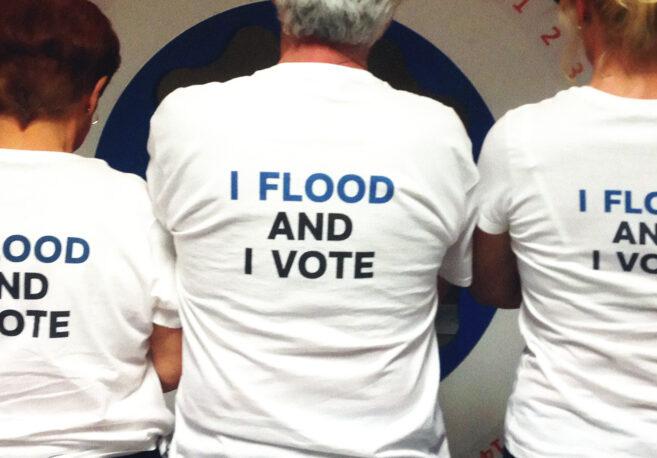
After enduring repeated floods, an Illinois community group called Floodlothian Midlothian organized and won a $7.6 million flood control project.
Floodlothian
Midlothian
PROGRESS AND PROSPECTS

care about and bring them information relevant to that.”33 Jeremy Hays emphasizes the need to foster problem-solving partnerships between frontline communities and local government. It’s an approach, he says, that “not only gives us better solutions to climate resilience, but also strengthens democracy and helps rebuild faith in institutions.”3⁴
Focus on implementation with federal funds. As of this writing, there are still unspent funds from Biden’s IRA that can be used to build resilience at the state and municipal levels. This includes funds from the $27 billion EPA Greenhouse Gas Reduction Fund and its Solar For All competition.3⁵ Assuming that money is not clawed back, “That’s real money out the door, and real opportunity to show the benefits of this work,” says Shamar Bibbins, managing director of The Kresge Foundation’s Environment Program.3⁶
In the coming years, Americans will need to make difficult decisions about whether to defend their communities, adapt to changing conditions, and/or move to safer locations.
Defend, adapt, or relocate. In the coming years, Americans will need to make difficult decisions about whether to defend their communities, adapt to changing conditions, and/or move to safer locations.3⁷ For example, a coastal community might fortify its shoreline with seawalls, adapt by allowing for periodic flooding, or move people and property out of harm’s way. The city of New Orleans, one of the nation’s most vulnerable, has adopted a Coastal Master Plan that incorporates all three strategies.3⁸
Thoughtful decision making begins with a broad, community-level conversation, says Stephen Flynn, founding director of the Global Resilience Institute at Northeastern University. “What are the needs? What are the vulnerabilities? What are the strengths in this community? When you inventory those, and introduce the issue of climate, it guides a more-holistic response.”3⁹
There is vast room for improving the climate resilience of American communities. For example, one-third of U.S. counties, cities, and towns have adopted modern building codes that help homes withstand hurricane-force winds.⁴0 It is especially critical that buildings and infrastructure constructed with public funds adhere to
Bilanol/iStock
the highest standards: “When we are building with taxpayers’ money, we should only have to build once,” says Michael Newman, general counsel at the Insurance Institute for Business and Home Safety.⁴1 Such upgrades more than pay for themselves by reducing the human and economic toll of disasters. For every $1 of resilience investments made, taxpayers save more than $6 on future recovery costs.⁴2
At the same time, climate adaptation has its limits. Rising seas and powerful storms may render some communities too dangerous to inhabit. Ayana Elizabeth Johnson, co-founder of the Urban Ocean Lab, is seeing more openness to the concept of managed retreat in coastal cities. “Investing in a plan for retreat is important,” Johnson says. “Because, if it’s done in a reactive way, it will be chaotic and unjust.”⁴3
Grow the adaptation field. Given the urgent need for evidence-based resilience strategies, it is crucial to evaluate measures such as green infrastructure for flood control and workforce protections against extreme heat. Hard evidence can guide effective interventions and build a case for more investment. And communicating those findings broadly can spur learning and improve practice.
While the growth of adaptation as a profession is a positive development, it risks creating a new silo for this work. “In many places, people think, ‘Oh, we have one staff who’s responsible for climate adaptation and resilience, and everybody else gets to do whatever they did before,’” says Susanne Moser. “But resilience needs to be everyone’s job.”⁴⁴ Lois DeBacker, former managing director of The Kresge Foundation’s Environment Program, adds: “Asking the ‘climate question’ must become part of standard decision making in professional disciplines such as urban planning, civil engineering, architecture, landscape architecture, public health, construction, forestry, and agriculture.”⁴⁵
Engage the private sector. The withdrawal of federal funding for climate resilience leaves a gaping hole at a critical moment. Private-sector businesses have an obvious interest in resilience, given the mounting costs and disruptions of a changing climate. But, while “resilience may be considered when thinking about supply chains, it is not yet part of the conversation at the boardroom level,” says Moser. “Until corporations understand that it’s a material risk to not think about resilience, we won’t unleash the other big money source.”⁴⁶
There are limits to what the private sector can accomplish in the current economic system, says DeBacker, given that incentives favor short-term economic returns rather than long-term resilience. But, even within the existing structure, “if you change design standards and change what people understand to be best practice in their discipline, you get different results.”⁴⁷
Double down on mitigation. Finally, we must stop making the problem worse, says Lara Hansen. “If we don’t get emissions under control, honestly, I don’t know how much adaptation matters.” The good news, she adds, is that we know how to mitigate climate change: “We need to start using those stabilization wedges that Pacala and Socolow gave us back in 2004 and enacting them at scale.”⁴⁸ Chapters 5.3 and 5.5 offer insights on how to do so.
“Investing
in a plan for retreat is important because, if it’s done in a reactive way, it will be chaotic and unjust.”
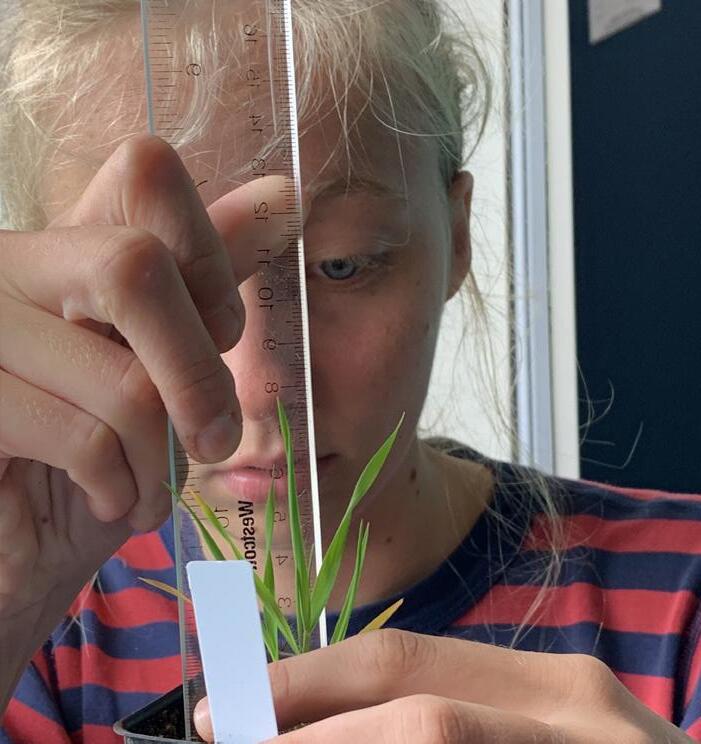
Kelley Lynch/kelleyslynch.com
A student at the University of Vermont conducts research on drought-tolerant grass species.
—AYANA ELIZABETH JOHNSON, CO-FOUNDER OF THE URBAN OCEAN LAB

EQUITY AND CLIMATE
ADVANCES AND SETBACKS
Equity is more central in climate work. Public concern about racial injustice surged in 2020, after the killings of George Floyd and others. But even before that “racial reckoning,” the climate movement was edging away from what Shalanda Baker, professor of environment and sustainability at the University of Michigan, calls “carbon fundamentalism”—a myopic focus on GHGs—and toward climate justice, which seeks a more-equitable distribution of risks and opportunities.1
Driven in part by frontline groups rooted in low-income neighborhoods and communities of color, the shift has had considerable impact on climate policy. For example, it helped shape the Biden administration’s Justice40 initiative and philanthropic programs such as the American Cities Climate Challenge.2 Jeremy Hays has witnessed a significant change over the last 15 years: “In 2008 and 2009, the big environmental groups were like, ‘the equity stuff is nice, I’m glad you’re doing that.’ By 2018, it had changed to ‘yes, we care, and this is part of our work.’”3
Racial diversity improved, then declined, at environmental nonprofits. While frontline groups are often led by people of color, the broader climate movement remains less diverse than the nation as a whole.⁴ In surveys of dozens of environmental nonprofits, Green 2.0 found a measurable increase in people of color on the staff and boards of green groups from 2017 to 2023, and a decline in 2024. (Among environmental foundations surveyed, the diversity gains were more durable.)⁵
The attack on equity has a chilling effect. Recent years have seen a vehement backlash against racial equity in policy and practice, culminating in the Trump administration’s efforts to root out equity initiatives in all sectors of society. Relevant examples include the closure of environmental justice offices at the Department
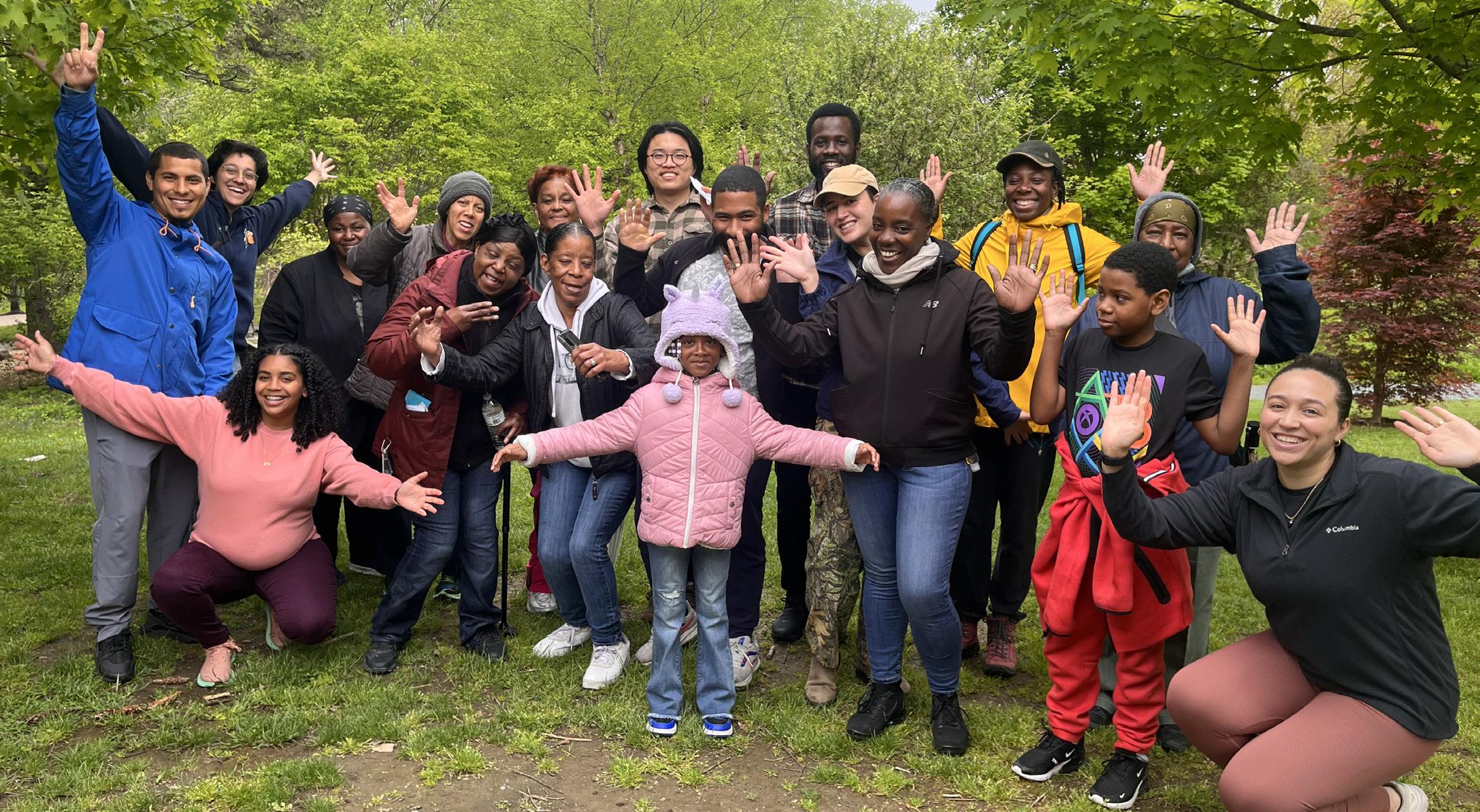
of Justice and EPA and cancellation of more than 400 EPA environmental justice grants totaling $1.7 billion—including a major grant to the Climate Justice Alliance.⁶ Assaults on equity are increasingly accompanied by public expressions of overt racism. As Jacqueline Patterson, founder of The Chisholm Legacy Project, observes: “They are saying the quiet part out loud, with a megaphone.”⁷
These efforts are part of a longstanding campaign to undermine civil rights protections. Conservatives won a major victory on that front in 2023, when the Supreme Court banned affirmative action in college admissions.⁸ That decision has had a chilling effect on a wide range of efforts to advance equity with race-conscious policies. For example, the Biden administration chose not to include race in a screening tool for Justice40, even though race is the strongest predictor of whether Americans live near polluting facilities.⁹ As Jacqueline Patterson, Aiko Schaefer, and Alvaro S. Sanchez write in Nonprofit Quarterly, the SCOTUS decision “could derail progress in our collective fight to slow climate change and address the long legacy of racial injustice in this country.”10
Across government, nonprofits, and the private sector, many are backpedaling on equity to avoid lawsuits, funding cuts, or harassment. “It’s a climate of fear,” says Lois DeBacker, “and people are obeying in advance.”11 Philanthropy, too, is pulling back from equity, says Shamar Bibbins. As a result, “Nonprofits in this space are really struggling, and laying people off.”12
The fierceness of the backlash may be a perverse measure of success. It followed closely on the heels of 2020’s racial reckoning, and, in the environmental movement, a new infusion of support for frontline groups led by people of color. “For the first time, these woefully underfunded groups had access to real money,” says Bibbins.13 In this way, the backlash against equity echoes similar moments in American
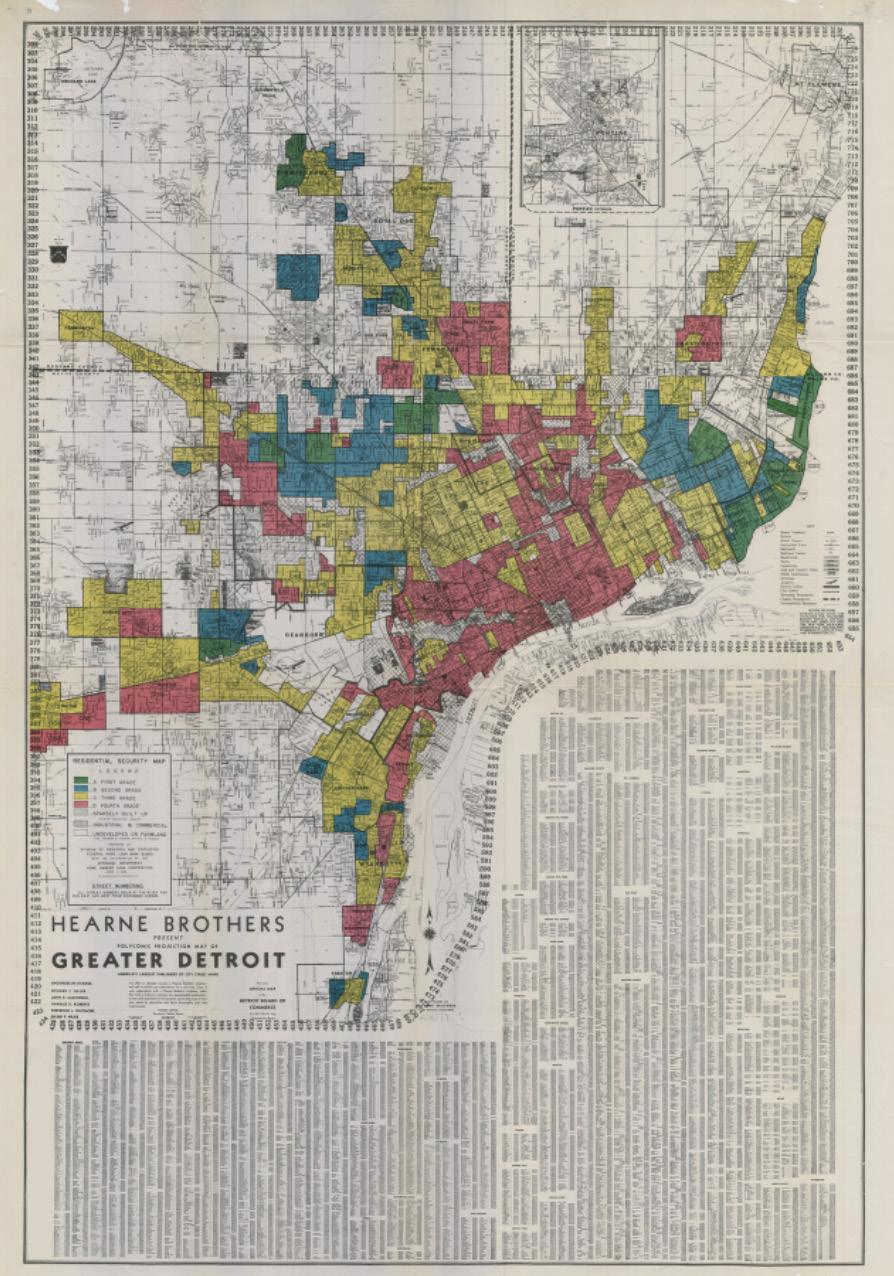
of redlined neighborhoods in Detroit, 1939. Redlining deprived Black and Brown neighborhoods of investment and amenities; today, those neighborhoods have more concrete and fewer green spaces and are therefore more vulnerable to flooding and heat.
Above: Participants in a nature walk hosted by the Fairmount Indigo CDC Collaborative at the Boston Nature Center.
Fairmount Indigo CDC Collaborative
Map
Detroitography
PROGRESS AND PROSPECTS
history—notably the darkest days of Reconstruction. The difference this time, says Jeremy Hays, is that “this country will soon have a majority of people of color.”1⁴ That fact, which underlies the ugly surge of racism we see now, may ultimately signal its undoing.
THE PATH FORWARD
Keep equity at the center of climate work. Low-income communities and people of color are hit first and worst by climate impacts. Since inequity is deeply embedded in the problem, equity must be part of solution. That means advocates must continue to educate policymakers and the public about the disproportionate impacts of climate change on marginalized communities. And they must continue to advance community-driven solutions that benefit those most at risk.
Connect equity to other issues and sectors. At the same time, progress requires more cross-pollination between those working on the technical aspects of resilience and those concerned about equity. “Social- and racial-justice leaders need access to trusted sources of scientific and technical expertise as they work on climate mitigation, adaptation, and resilience,” says Lois DeBacker. “And policymakers at all levels need a heightened understanding of the racial-justice implications of their decision making.”1⁵
Show that equity benefits everyone. Racial equity is a matter of fairness and justice for all, full stop. It is also better for society as a whole. In The Sum of Us: What Racism Costs Everyone and How We Can Prosper Together, Heather McGee shows how zero-sum thinking about race—if Black people win, White people lose—has undercut White people’s support for a wide range of public goods.1⁶ It is, Frontline groups, often led by people of color, play an outsized role in building an equitable, resilient future. Below, graduates of Catalyst Miami's Community Leadership on the Environment, Advocacy and Resilience (CLEAR) training program.

Catalyst Miami

she writes, why Americans “can’t have nice things,” like well-funded schools or a comprehensive public health system.1⁷ (Or clean air and a stable climate.) “We need to show that this is about all of humanity,” says Nathaniel Smith, chief equity officer at the Partnership for Southern Equity. “If you harm the most vulnerable, we all suffer.”1⁸
Support and protect frontline groups and leaders. Frontline groups—often led by people of color—play an outsized role in building an equitable, resilient future. However, these groups receive less support than national green groups, and leaders of color face extraordinary pressures and dangers. In addition to providing more monetary support for frontline groups, funders can support networking, retreats, and other efforts to reduce burnout among leaders, as well as security measures to protect them from violence and intimidation.
Continue to diversify the movement. The recent decline in diversity at environmental nonprofits suggests that hiring more people of color is not enough. According to Green 2.0’s 2024 Transparency Report: Turning Tides in the Sector, “Increasing and retaining staff with diverse identities and experiences in the field is an active process and not something that happens passively.”1⁹ To that end, environmental nonprofits and foundations must work to ensure fairness in policies including hiring, evaluation, employee development, and pay.
In The Sum of Us: What Racism Costs Everyone and How We Can Prosper Together, Heather C. McGee shows how zero-sum thinking about race—if Black people win, White people lose— has undercut White people’s support for a wide range of public goods. In the 20th century, many cities closed and drained their public swimming pools rather than desegregate them.

ENERGY
ADVANCES AND SETBACKS
The Biden administration’s climate investments could shape the U.S. energy future. The Inflation Reduction Act (IRA) invested $391 billion in climate and clean energy initiatives, including tax credits and other incentives for renewable power, electric cars, solar panels, and batteries.1 “It’s the biggest piece of climate legislation that ever passed,” says Seth Mullendore, president and executive director of the Clean Energy Group.”2
Despite the Trump administration’s efforts to roll back funding for clean energy, implementation of these investments is already underway, with much of the funding legally obligated. Laurel Blatchford, senior fellow at Delivery Associates, and Xavier de Souza Briggs, senior fellow at Brookings Metro, conclude that “effective implementation will need to be sustained for years to come, and the impact of these major investment programs hinges on how they are implemented by state, local, tribal, and even industry decision makers.”3
The IRA brought new players to the clean-energy transition. Biden’s clean energy investments sought to benefit those who have historically been left out of the transition to renewables. These investments “focused on creating a more-equitable distribution and deployment of resources,” says Mullendore. He cites the Solar For All program, which brings solar to low-income households and lowers their energy costs. The investments also embraced community benefits, “making sure that renewable energy is developed in a way that’s inclusive of those communities and beneficial to them.”⁴
Importantly, the IRA extended tax credits to those who usually can’t access such incentives because they don’t pay federal taxes, including local governments and nonprofits such as churches and universities. Under the IRA’s Direct Pay provisions

(also called Elective Pay), tax-exempt entities can receive a payment equal to the full value of tax credits for clean energy projects. An analysis by the World Resources Institute found that Direct Pay is offering game-changing support for clean energy in the public and nonprofit sectors. In 2023, for example, some 27 cities claimed a total of $12.6 million in tax credits they would not have otherwise received.⁵ IRA tax credits have also helped health centers, community action agencies, and other nonprofits build solar installations with battery storage that can keep the power on during ever-more-frequent disasters.⁶
The IRA also offers bonus tax credits for clean-energy investments in low-income communities.⁷ A report from the U.S. Treasury Department found that these credits spurred $3.5 billion in public- and private-sector investment, while creating an additional 1.5 gigawatts of energy generation capacity.⁸
Federal support has catalyzed private investment, especially in Republican districts. In addition to tax credits for clean energy in low-income communities, federal support has spurred significant private-sector investments: during Biden’s term in office, corporate spending on clean energy and manufacturing in the United States surpassed $1 trillion.⁹
According to E2, a nonpartisan network of business leaders, nearly 60 percent of the clean-energy and -vehicle projects announced since the IRA passed are in Republican congressional districts, even though no Republican voted for the legislation. These projects represent 85 percent of the new investments and 68 percent of jobs created.10 Notably, Texas—which already leads the nation in wind energy—has added nearly 5,000 megawatts of new solar energy capacity since 2022—a 37 percent increase.11 And Oklahoma is positioning itself as a leader in geothermal energy.12 “At this point, market forces are driving the transition to
The Biden-Harris administration’s Inflation Reduction Act (IRA) invested $391 billion in climate and clean energy initiatives.
Serhii Hryshchyshen/iStock
PROGRESS AND PROSPECTS

for
“At this point, market forces are driving the transition to renewables. Policy and incentives are still important, but they’re not the defining line between success and failure for clean energy.”
—SETH MULLENDORE, PRESIDENT AND EXECUTIVE DIRECTOR OF THE CLEAN ENERGY GROUP

renewables,” says Seth Mullendore. “Policy and incentives are still important, but they’re not the defining line between success and failure for clean energy.”13
Renewables rise; carbon emissions fall. Across the globe, renewable energy is now cheaper than fossil fuels.1⁴ The price of solar, for example, fell by nearly 90 percent from 2009 to 2019.1⁵ In the U.S., renewables now account for two-thirds of new generating capacity.1⁶ Indeed, wind and solar are now the fastest-growing electricity sources in history.1⁷ Thanks to cleaner energy and greater efficiency, our economy is becoming less carbon-intensive: since 2000, the U.S. economy has grown by more than one-third, while carbon emissions have fallen 20 percent from their 2007 peak.1⁸
Regulatory hurdles slow the transition to renewables. Renewable energy developers face a maze of complex regulations and long queues when they seek to connect their projects to the grid, slowing the transition to clean energy.1⁹
One analysis found that 80 percent of the carbon benefits from Biden’s climate investments could be lost if the U.S. fails to double its rate of power-line construction.20 Long-awaited permitting reform legislation could help, but is also likely to remove environmental protections and speed the approval of harmful fossil fuel projects.21
The Trump administration is trying to reverse progress. Backed by fossil-fuel interests, Trump pledged to roll back Biden’s signature investments in clean energy. As promised, his administration has halted new leases for renewable energy projects on federal lands and waters and is trying to claw back $14 billion in grants already awarded through the Greenhouse Gas Reduction Fund.22
Climate justice advocates with Catalyst Miami and other partners protest rate hike requests
more dirty energy investments.
Catalyst Miami
However, because Biden’s clean energy tax credits disproportionately benefited Republican districts, these efforts are getting pushback from red-state allies.23 As a result, the Trump administration is now focusing its clean-energy cuts on Democratic-leaning states.2⁴ Mullendore fears that the equity-oriented provisions of Biden’s clean energy investments are most at risk.2⁵
There are less-tangible costs, as well. Shalanda Baker, who headed the Department of Energy’s (now defunct) Office of Energy Justice and Equity during the Biden administration, speaks of “the spiritual and psychic toll of knowing that someone is coming to dismantle your work.” In the current climate of fear, Baker says, “Folks are actively dismantling it even before they are asked to do so.”2⁶
A shift toward electrification is under way. The last decade has seen a push to “electrify everything”—to replace gas- and oil-burning appliances and vehicles with electric ones, powered by renewable energy. Electrification promises lower greenhouse gas emissions and cleaner air. Buildings are especially ripe for electrification, as they produce about 13 percent of U.S. GHG emissions.2⁷ Electrified buildings have health benefits, as well, because burning fossil fuels indoors produces toxins linked to cancer and respiratory disease.2⁸ The shift is well under way: electric heat pump sales topped those of gas furnaces in 2022.2⁹
The IRA helped advance electrification with tax credits for electric appliances and upgrades, administered by the states. However, some states have paused these programs due to the current uncertainty of federal funding.30
The last decade has seen a push to “electrify everything”—to replace gas- and oil-burning appliances and vehicles with electric ones, powered by renewable energy.
When the local utility repossessed Highland Park, Michigan’s streetlights, the community group Soulardarity installed solar-powered lights.
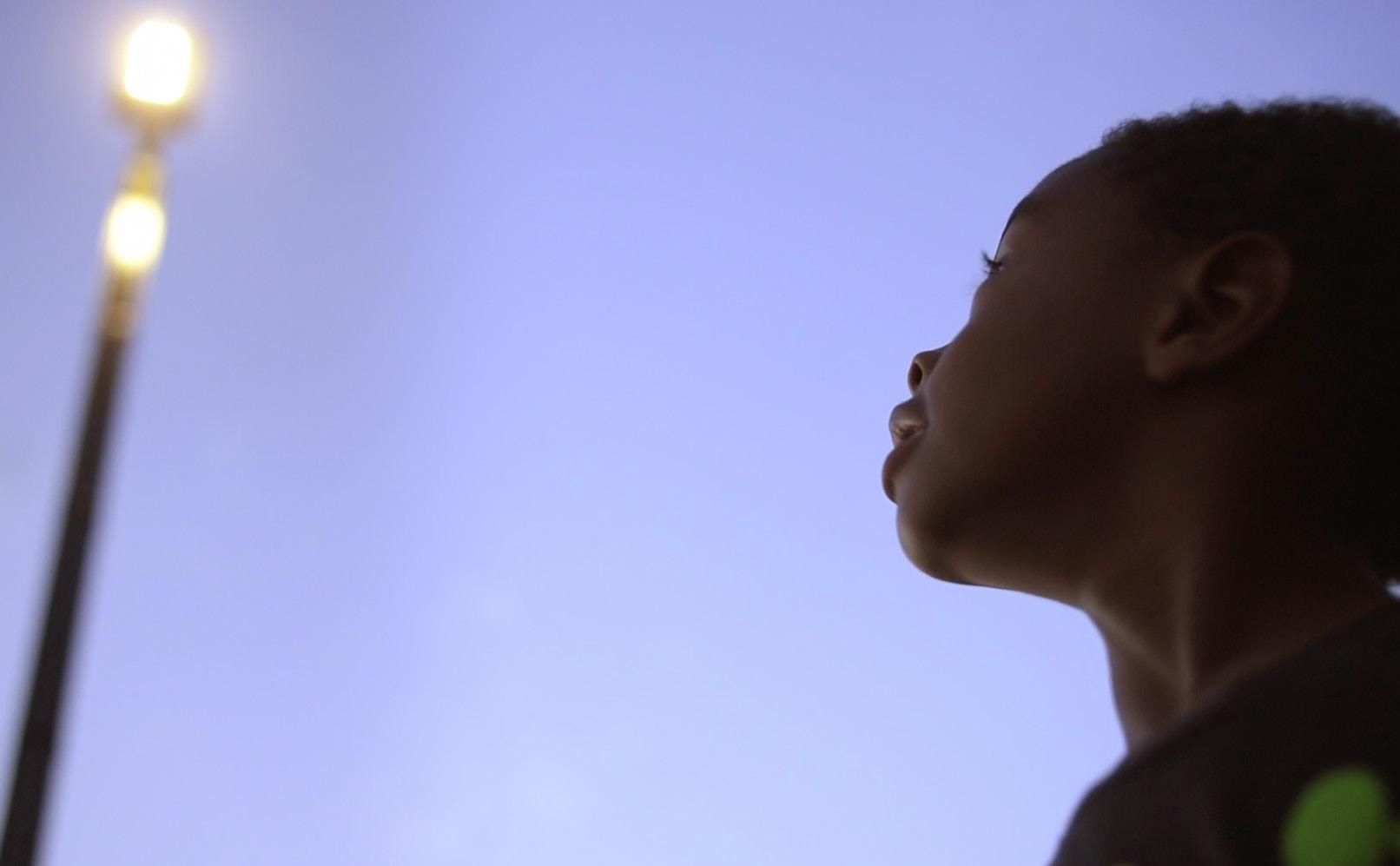
Highland Park Community Crisis
PROGRESS AND PROSPECTS
Electrification raises equity concerns. At the same time, advocates have warned that a rush to electrify could do harm as well as good. Stark economic and racial inequities mean that people of color and low-income communities bear the heaviest burdens from our current fossil-fueled energy system—from high prices to poor air quality. If electrification proceeds without understanding and addressing those inequities, it could deepen them. For example, without measures to make electrification affordable, low-income families could be stranded with failing gas utilities and higher energy prices. And without a wholesale shift to renewable power generation, electrification could ramp up demand at fossil-fueled power plants, which are disproportionately located in communities of color.31
“We are in the midst of a technology shift,” says Anne Evens, CEO of Elevate. “And every time there’s a big technology shift, we have to think about who wins and who potentially gets harmed.”32 Several nonprofit groups, including Elevate and Collectrify (formerly the Equitable Building Electrification Fund) are working to ensure more fairness in the shift toward electrification.33

Rising demand for electricity could swamp climate gains. While U.S. greenhouse gas emissions have declined in recent years, a surge in demand for electricity could undo that progress. Thanks largely to the breakneck construction of data centers to power artificial intelligence and crypto mining, some analysts predict electricity demand will surge by 35-50 percent between 2024 and 2040. Building electrification, EVs, and economic growth are also expected to fuel demand.3⁴
That growing demand could slow the shift to renewable power. Indeed, surging demand is delaying the closure of polluting coal-fired power plants in Kansas, Wisconsin, Nebraska, and South Carolina.3⁵ In North Omaha, Nebraska—a lowincome, majority-Black community plagued with air pollution and high rates of asthma, plans to close a 1950s-era coal plant were scuttled when Google and Meta announced plans to build data centers nearby.3⁶ In this way, power-hungry data centers threaten environmental justice as well as climate change mitigation.
But some think estimates of growing demand from data centers are overblown. Recently, a Chinese company unveiled DeepSeek, a new AI model that reportedly uses 10 to 40 times less energy than similar U.S. technology.3⁷ If true, evolving AI technology could prove less energy-intensive than feared. Seth Mullendore notes that utilities build their usage predictions on worst-case scenarios, where everyone is using everything at once. However, he says, innovative technologies—demand response programs, battery storage—can manage loads and reduce peak demand.3⁸
The U.S. power system needs an overhaul. Regardless of how much demand increases, our energy system is failing to provide affordable, reliable power to all Americans. Residential electricity rates have increased by 20 percent since early 2022.3⁹ More than one in four Americans have trouble paying their energy bills; one in five have been forced to forego basic necessities in order to keep the lights on.⁴0 High energy costs disproportionately affect the nation’s growing population of older adults: seven million elderly Americans have skipped meals or medicine to pay their utility bills.⁴1 And, as climate change impacts worsen, weather-related power outages have increased by 80 percent since 2011.⁴2

THE PATH FORWARD
Look to the states. State public utilities commissions (PUCs) already play an outsized role in shaping the U.S. energy system. While they usually labor in obscurity, PUCs determine how much consumers pay for energy, how utilities invest their funds, and where energy and transmission projects are built. As Charles Hua, executive director of Powerlines, told David Roberts in Volts last year: “These 200 [commissioners] oversee over $200 billion in annual utility spending…We should be talking about them like they're Supreme Court justices in terms of their impact on energy and equity issues.”⁴3
As the federal government steps away from the clean-energy transition, PUCs will only grow in importance. These commissions can be laboratories of innovation. For example, Johanna Partin, principal at Transformative Strategies Consulting, observes that some state PUCs are considering rate changes to encourage electrification and discourage fossil fuel use.⁴⁴ Boosting public engagement with PUCs could help shape a more sustainable, equitable energy system. State energy offices, which craft statewide energy policy and strategies, will also grow in importance in the years to come.
Show the economic benefits of clean energy. In this moment of economic uncertainty, it’s important to show that “clean energy is the cheapest thing out there,” says Seth Mullendore. He adds that Biden’s investments could make the U.S. a global leader in clean-energy manufacturing, creating good jobs and revitalizing communities. “We ceded that place to China,” Mullendore says, “and it’s time to bring it back.”⁴⁵
More than one in four Americans have trouble paying their energy bills; one in five have been forced to forego basic necessities in order to keep the lights on.

Catalyst Miami's Community Engagement Manager for Overtown, Nicole Crooks, participates in an awareness event outside Florida Power and Light's headquarters.
Catalyst Miami
Pexels
PROGRESS AND PROSPECTS
It is vital to show benefits at the household level, as well, says Johanna Partin. For example, an analysis by EV advocacy group Coltura found that drivers in Republican districts—which tend to be more rural and auto-dependent than Democratic districts—have the most to gain financially by switching to electric vehicles.⁴⁶ “We need to talk to people about what they care about, which is reducing monthly household expenditures,” says Partin. Messaging aside, she adds, “We’ve got to bring down costs for people. Energy and transportation costs are a huge burden on many families.”
Cut red tape. As noted above, federal permitting reform is a mixed bag; it could bring more renewables online, but also greenlight fossil-fuel projects and weaken environmental protections. But there’s much to be done at the state and local level. Cities, governments, and other entities can make it easier to build renewable energy and upload it to the grid. To keep up with rapidly changing technology, “We need to set regulations that are outcome focused, and not highly prescriptive,” says Stephen Flynn of the Global Resilience Institute.⁴⁷
Spur innovation. Smart grids, energy storage, demand-response programs, “virtual power plants” composed of networked batteries—all of these innovations can help deliver affordable, efficient, resilient power and reduce the need for new fossil fuel
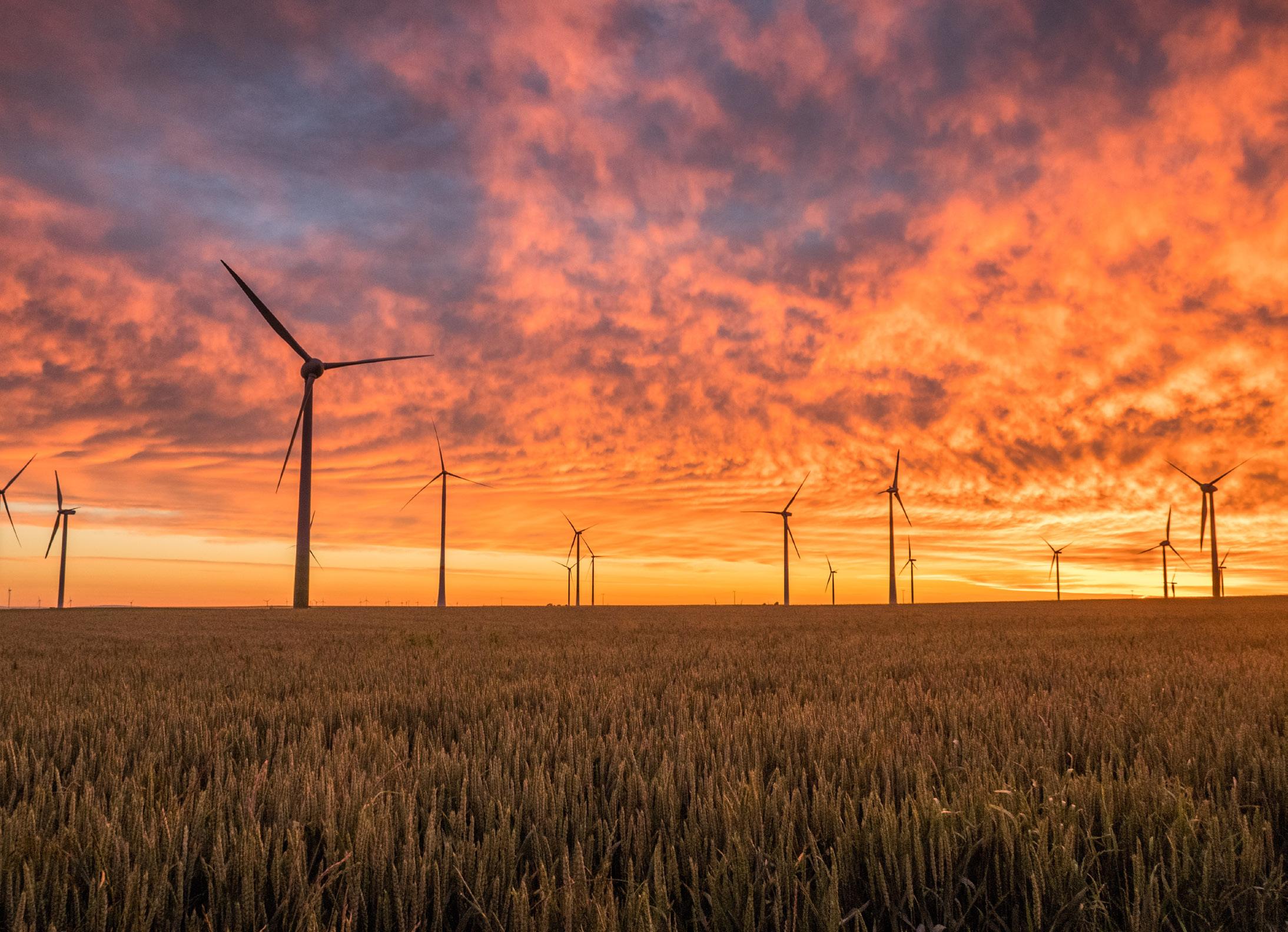
infrastructure. Even without federal support, advocates and donors can continue to advance innovation in these areas, working with state governments and PUCs.
Another promising technology is advanced geothermal energy, which uses fracking techniques to inject water deep underground, creating hot-water reservoirs that can heat buildings or produce energy.⁴⁸ “District” geothermal power can provide heating and cooling for clusters of buildings, achieving gains more efficiently than a building-by-building approach.⁴⁹ Importantly, geothermal is the one form of renewable energy that has been embraced by the second Trump administration.⁵0
Electrify equitably and strategically. “We don’t advocate for electrifying everything today,” says Anne Evens. Instead, “we need to make this transition in a way that doesn’t saddle anyone with higher costs.” For example, Evens suggests focusing on electrification strategically in areas where it will help people save money—such as rural and tribal areas where residents depend on propane for power. In the Northeast and other areas where electric rates are high, advocates can push for costsaving measures, such as discounted rates for homes with electric heat.⁵1
Continue to support energy efficiency. Improving efficiency by reducing energy waste remains a low-hanging fruit in the clean-energy transition. After all, the cleanest power plant is one that isn’t built. Efficiency gains account for more than half of reductions in energy use since 1980, and there is still room for improvement.⁵2 According to the American Council for an Energy-Efficient Economy, through innovative technology and policy, “energy efficiency can cut U.S. energy use and emissions in half by 2050.”⁵3 At the same time, these innovations must be accompanied by education, warns Denise Fairchild, founder of the Ubuntu Climate Initiative; otherwise, greater efficiency may spur more energy use, offsetting gains for the climate and economy.⁵⁴
Decentralize power (literally and figuratively). The massive, centralized electric grid we rely on is wondrously efficient on a good day. But climate change guarantees more bad days to come. “We need to create decentralized systems that are networked together on blue-sky days, but ‘island’ themselves so they can keep operating during a disruption,” says Stephen Flynn. He adds that such systems face stiff headwinds in a market that discourages redundancy and focuses on short-term profits rather than long-term resilience.⁵⁵
In Energy Democracy: Advancing Equity in Clean Energy Solutions, editors Denise Fairchild and Al Weinrub lay out a vision of decentralized, community-owned energy systems that boost climate resilience while returning power, quite literally, to the people.⁵⁶ Shalanda Baker, whose book Revolutionary Power: An Activist’s Guide to the Energy Transition provides a blueprint for achieving that goal, agrees. Baker observes that the distribution of literal and figurative power reflects a profound political choice: “On one side is totalitarianism—top-down management of our resources and assets. On the other side is community ownership, governance, and stewardship—thinking of resources as the commons. We’re in that moment where we’ve got to decide how we want to go.”⁵⁷

“On one side is totalitarianism— top-down management of our resources and assets. On the other side is community ownership, governance, and stewardship— thinking of resources as the commons. We’re in that moment where we’ve got to decide how we want to go.”
—SHALANDA BAKER, PROFESSOR, ENVIRONMENT AND SUSTAINABILITY, UNIVERSITY OF MICHIGAN
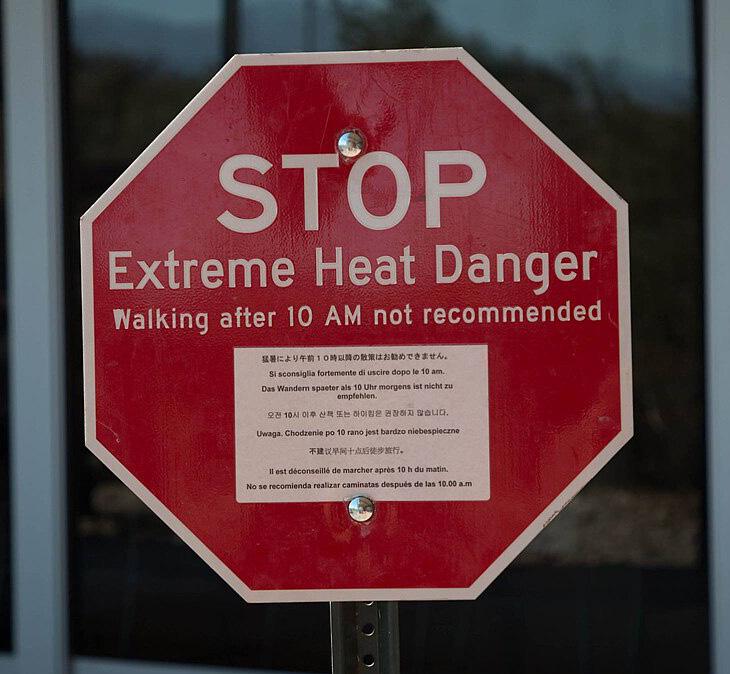
CLIMATE AND HEALTH
ADVANCES AND SETBACKS
Climate change takes an ever-greater toll on human health. According to The Lancet, a leading medical journal, climate change is now the greatest threat to global public health.1 Searing heat waves and choking wildfires sicken and kill by weakening hearts, lungs, and kidneys. Lives and livelihoods are lost in rising floodwaters. And vector-borne diseases—such as Zika, dengue, and Oropouche— are expanding their range into new locations and latitudes. The toll of climate change on health is so great—and so underappreciated—that Gary Cohen, president of Health Care Without Harm, calls it “the elephant in the waiting room.”2
Moreover, the primary cause of climate change, air pollution from burning fossil fuels, is itself a leading cause of sickness and premature death.3 A report from the Harvard School of Public Health found that 8 million people worldwide died prematurely from fossil fuel pollution in 2018—accounting for about one in five deaths worldwide.⁴
There is new understanding of climate health impacts. Recent years have seen “a growing awareness of the impacts of climate change and fossil fuels on health, and a growing movement of health professionals that are trying to address them,” says Linda Rudolph, principal investigator at the Public Health Institute’s Center for Climate Change and Health.⁵ In addition to national organizations like the Medical Societies Consortium on Climate and Health, the Fossil Free for Health Coalition, and the Alliance of Nurses for Healthy Environments, state-based climate and health organizations have proliferated over the last decade.
Under the Biden administration, the U.S. Department of Health and Human Services established a first-ever Office of Climate Change and Health Equity to protect communities that bear the brunt of pollution and climate-driven disasters— though the Trump administration has shut it down.⁶ Several states have passed
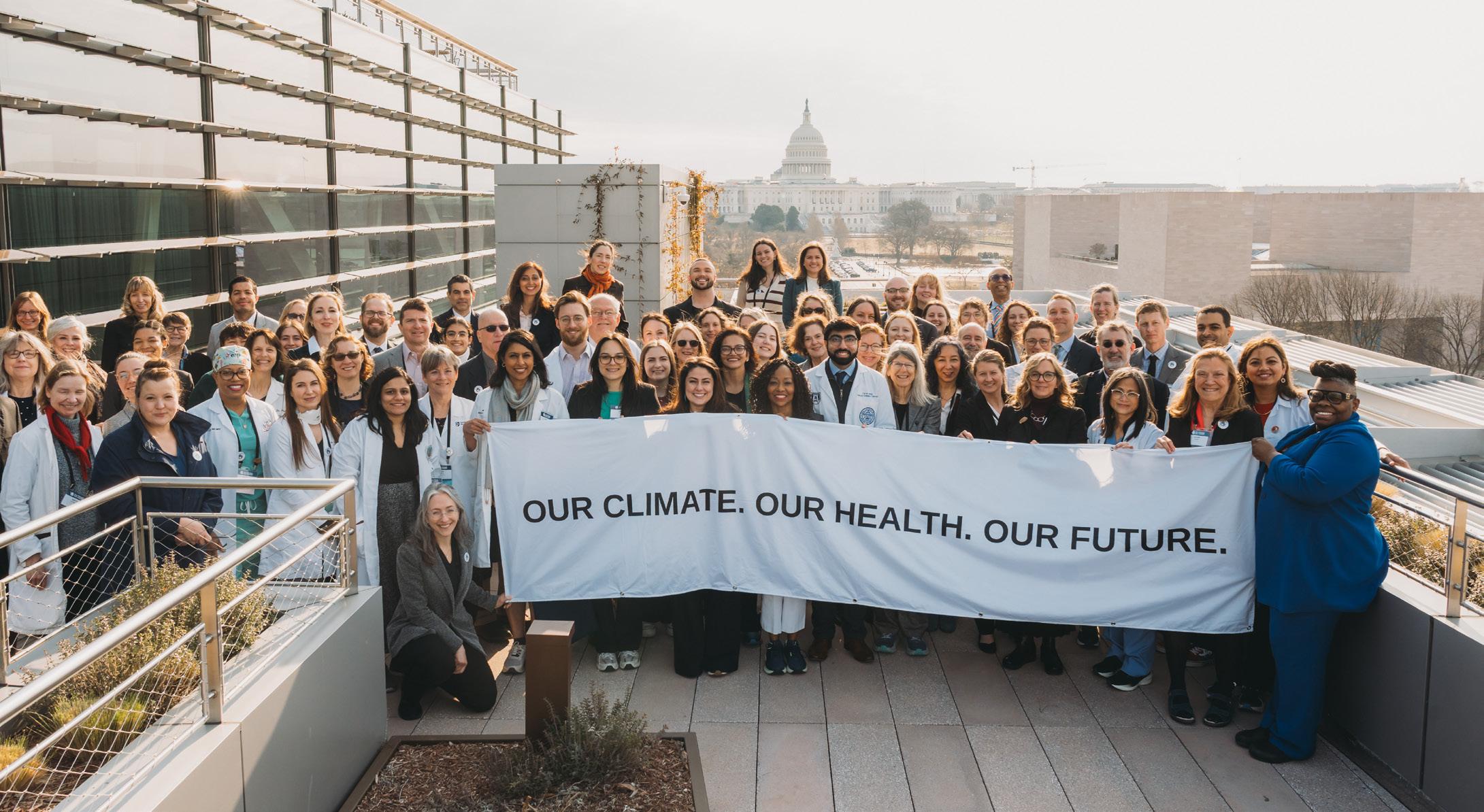
protections against heat for vulnerable workers, and the federal government has considered a nationwide standard.⁷
While these interventions are driven by an increase in extreme weather events, “There’s not yet a full appreciation of the imperative to address the upstream causes of climate change,” says Rudolph. “Even in the public health world, which is theoretically focused on prevention and upstream causes, it’s still very focused on downstream interventions.”
Heat is the deadliest climate impact. Heat causes 12,000 premature deaths each year in the U.S.⁸—killing more Americans than floods, hurricanes, tornadoes, and other weather-related hazards combined.⁹ Adults over the age of 60 account for 80 percent of those deaths.10 Dr. Cheryl Holder, executive director of Florida Clinicians for Climate Action, calls heat a “threat multiplier.” “If you have diabetes, high blood pressure, any kind of medical condition,” she says, “heat makes it worse.” But the healthy are not spared: “A lot of strong, healthy outdoor workers die in extreme heat. Children die,” she says.11
Heat has more-subtle effects on human health and well-being, too. It prevents children from playing outdoors and makes it harder to sleep and learn. Heat is associated with higher crime and lower productivity.12 And it is getting hotter: 2024 was the hottest year in recorded history, followed only by 2023. The world’s 10 hottest years all happened in the last decade.13
Climate change health impacts reflect—and magnify—existing inequities. Climate change is also a threat multiplier for existing social, racial, and economic disparities. For example, heat and wildfire exacerbate conditions like asthma and diabetes that are already more prevalent in Black communities, leading to worse health outcomes.1⁴ Moreover, the legacy of redlining and other racist policies has left Black and Brown neighborhoods more vulnerable to climate impacts.1⁵
Above: Health professionals gather in Washington, D.C., to visit Congress as part of the "Our Planet, Our Health: 2025 Climate Action Convention." Participants educated decision makers on the importance of federal climate investments.
Heat causes 12,000 premature deaths each year in the U.S.— killing more Americans than floods, hurricanes, tornadoes, and other weather-related hazards combined.
Aidan Demolili
PROGRESS AND PROSPECTS

Frontline groups are steering attention and resources to climate health impacts, especially in marginalized communities.

Crowded with polluting industries and lacking parks and green spaces, these neighborhoods are hotter and more flood-prone than their wealthier, Whiter counterparts.1⁶ Partly as a result, the rate of heat-related deaths among Black Americans is 50 percent higher than for non-Hispanic Whites.1⁷
Older Americans are especially vulnerable to climate health impacts. Americans over the age of 65 will soon outnumber those under 18 for the first time in history.1⁸ And climate health impacts—especially extreme heat—take the greatest toll on older adults.1⁹ Danielle Arigoni, director of the EPA Region 8 Environmental Justice Division, explains that older adults are more vulnerable to heat because of the physical effects of aging; they are also more likely to have underlying health conditions and take medications that reduce a body’s ability to cool itself. Lowincome older adults—who struggle to pay for air conditioning—are particularly vulnerable.20
Community-based organizations are changing the conversation on climate and health. Frontline groups are steering attention and resources to climate health impacts, especially in marginalized communities.21 Several of these groups are part of The Kresge Foundation’s Climate Change, Health and Equity Initiative, a joint effort of Kresge’s health and environment grantmaking teams.22 For example, Catalyst Miami helped shape Miami-Dade’s climate policies to better meet residents’ needs. While the county initially focused on sea-level rise, Catalyst Miami heard from community members that heat was their top concern. The group’s advocacy helped spur the appointment of the nation’s first chief heat officer, who is charged with developing and deploying a comprehensive action plan for extreme heat.23 At least seven cities worldwide have since appointed heat officers.2⁴
Health care systems are impacted by—and contribute to—climate change. Climate disasters increasingly impact health care facilities, with sometimes deadly
Alliance of Nurses for Healthy Environments Fellow Mia McPherson talks to health professionals in Minneapolis about the importance of working in communities to address environmental health issues.
Jamie Giambrone Photography
results. Hospitals were forced to close when Hurricane Maria destroyed Puerto Rico’s power grid in 2017, contributing to one of the highest hurricane death tolls in U.S. history.2⁵ And during Hurricane Helene in 2024, floodwaters turned a Tennessee hospital’s corridors into whitewater rapids, while patients were rescued from the roof by helicopter.2⁶ Extreme weather is one cause of a recent increase in power outages, during which medicines go bad, electronic health records are inaccessible, and essential medical equipment—including ventilators—shuts down.2⁷
Ironically, the U.S. health care sector is itself a major contributor to climate change. According to Health Care Without Harm, the sector produces 8.5 percent of the nation’s GHG emissions.2⁸ Globally, if the health sector were a country, it would be the fifth-largest emitter on the planet.2⁹
COVID supercharged distrust of health systems. The COVID-19 pandemic sparked a crisis of confidence in public health. As Linda Rudolph observes, “The pandemic distilled a lot of anger that people had at institutions and the government, feeling like the people making decisions don’t have my needs and my life in mind. And some have built on that to further a distrust in public health and medical professionals.” She adds: “While medical professionals are still among those most highly trusted, that trust has dropped significantly since COVID, along with distrust and lack of understanding of science.”30
For Dr. Cheryl Holder, the erosion of trust began long ago, with the demise of primary health care infrastructure in the U.S. Constrained by the imperatives of for-profit medicine, doctors are reduced to providing “episodic care,” because they lack the time to care for their patients more holistically. However, she notes that the recent decline of trust in public health is something that happened primarily in affluent, White communities: “Many Black folks have never trusted health systems,” she says.31

Globally, if the health sector were a country, it would be the fifthlargest emitter of greenhouse gases on the planet.
Fairmount Indigo CDC Collaborative
Participants in “Collaging for Envisioning a Hopeful Future,” part of an art therapy workshop series on climate and mental health hosted by the Fairmount Indigo CDC Collaborative.
PROGRESS AND PROSPECTS
Distrust is fueling an attack on public health. Contempt for public health was reflected in Trump’s appointment of Robert F. Kennedy Jr.—a prominent skeptic of vaccines and other cornerstones of public health—as U.S. Secretary of Health and Human Services. Now, the Trump administration’s assault on public health infrastructure, combined with public indifference, threatens basic protections for all Americans. For example, Holder says that underfunded health departments are neglecting mosquito control in Florida, even as new vector-borne diseases take hold.32 And officials are downplaying the importance of vaccines while a measles outbreak spirals out of control.33 “Hold on to your masks and your gloves,” says Holder, “because nobody’s coming to help.”3⁴
Conservative state governments are also taking aim at local health protections. In Texas, which has the nation’s highest number of worker deaths from heat-related causes, the cities of Austin and Dallas passed ordinances mandating water and shade breaks for construction workers. In 2023, the Texas state legislature nullified those laws and barred similar laws in the future. The following year, Florida followed suit, preempting Miami’s heat-protection ordinance for outdoor workers.3⁵

THE PATH FORWARD
Continue to connect the dots between climate and health. In this era of highlevel climate denial, the climate-health connection can open conversations about the perils of a warming planet, even in conservative areas. “The 1.5-degree goal, net zero, emissions trends—those are words people don’t relate to,” says Danielle Arigoni. “But when you say, ‘We have X number more days of extreme heat, we have this much worse air quality because of wildfire smoke, we have this much more flooding—that really resonates for people.”3⁶
By connecting the dots on climate and health, advocates can build and strengthen coalitions for action, says Cate Mingoya-LaFortune. For example, where MingoyaLaFortune lives in eastern Massachusetts, public schools are not air-conditioned. “We’re starting to run into problems where kids can’t go to school in September because it’s 104 degrees in the classroom. That’s a labor issue for teachers, so we should be working with the teachers’ union. It’s an economic problem for parents who have to call out of work, so we should be working with them. It’s a climate adaptation issue. There are so many intersecting groups that can work on these issues.” Mingoya-LaFortune hopes that “philanthropy and government will help people find that connectivity, so they can solve these problems more effectively.”3⁷
Focus on the most vulnerable… To reduce the toll of climate change on human lives and health, it is essential to prioritize the needs of those hit first and worst. That includes those who lack the financial resources to protect themselves from—or recover from—climate impacts. It includes communities of color that are already burdened with pollution and high rates of disease. It includes outdoor workers who labor under broiling heat. And it includes the fast-growing population of older Americans.
In the last decade, advocates have won important protections for vulnerable groups. In New York City, for example, WE ACT for Environmental Justice launched the Harlem Heat Project in 2016, partnering with researchers and residents to measure
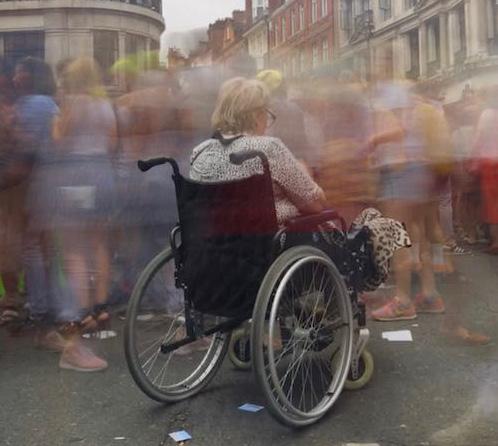
heat inside apartment buildings.3⁸ Their findings helped win a program that distributes free air conditioning units to low-income households throughout the city.3⁹ And in 2024, advocates in Virginia won legislation with bipartisan support that prevents utility companies from shutting off electricity during times of extreme heat or cold.⁴0 Catalyst Miami, Florida Clinicians for Climate Action, and other groups are now fighting for similar legislation in Florida.⁴1
Protections for older adults have lagged, largely due to a lack of awareness, says Danielle Arigoni. Governments and nonprofits must begin by understanding the community of older adults and implementing programs to address their needs. Fortunately, interventions that keep elderly people safe also have broader social benefits. For example, programs that help seniors weatherize their homes can bring down cooling costs and deliver a more resilient housing stock. Bus shelters with shading and seating can make public transit a good option for older adults on hot days—and serve people of any age who can’t afford to or are unable to drive.⁴2
…but show that climate affects everyone. At the same time, focusing only on the most vulnerable groups obscures how widespread those impacts have become. Working-class Americans, people of color, and the elderly are the sentinels of climate change, but its impacts are coming for everyone. “You know the saying, ‘White folks get a cold, Black folks get pneumonia?’ Well, we all get pneumonia at some point,” says Holder.⁴3 And we are all aging, says Arigoni: “While we may not be vulnerable now, aging is a universal experience that ultimately comes for us all.”⁴⁴
Amplify trusted voices. Although they lost ground during the pandemic, health professionals still have the public’s trust. Nurses, in particular, have been voted
“You know the saying, ‘White folks get a cold, Black folks get pneumonia?’ Well, we all get pneumonia at some point.”
—DR. CHERYL HOLDER, EXECUTIVE DIRECTOR OF FLORIDA CLINICIANS FOR CLIMATE ACTION
Pexels
PROGRESS AND PROSPECTS
the most-trusted professionals in the U.S. for 23 years running.⁴⁵ Given that status— and their position on the front lines of the climate-health crisis—nurses and other health professionals are key messengers on climate and health. Accordingly, the Alliance of Nurses for Healthy Environments works with nurses to educate their communities about climate impacts, and to press for policies that protect health and mitigate climate change.⁴⁶
Medical professionals of color have an especially important role to play, given their communities’ heightened distrust of health systems. That is why the Medical Society Consortium on Climate and Health launched the Climate Health Equity Fellowship (CHEF) in 2021, in order to “empower physicians from populations that face greater burdens from climate effects and are under-represented in medicine to become leaders in climate and health equity education, advocacy, and policy solutions.”⁴⁷ Among other activities, CHEF fellows publish op-eds in local media outlets that speak directly to members of their communities.⁴⁸
Connect frontline organizations with health professionals. Rebuilding trust in public health and developing better climate-health policies requires better collaboration between health professionals and the people they serve. That collaboration can be a powerful learning experience for both groups. For example, Carmen Cavezza, senior climate organizer at the Coalition for Environment, Equity and Resilience in Houston, took the director of a local public health school on a tour of homes without air conditioning. “He was inside those houses when it was
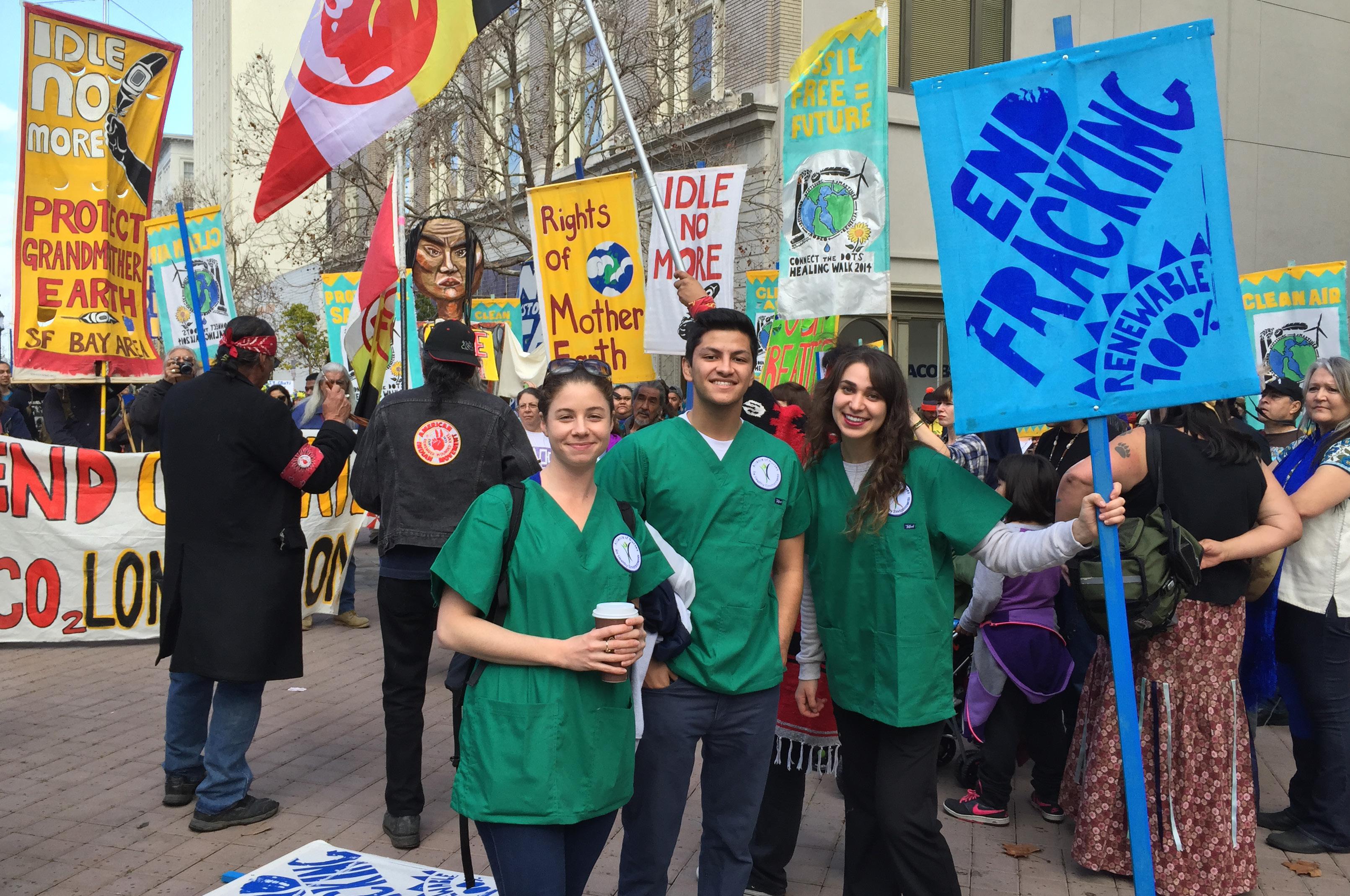
Alliance of Nurses for Healthy Environments Fellows attend a climate march in Washington, DC.
98 degrees, and with humidity it feels like 107,” says Cavezza, “and he learned what it feels like when you don’t have a break from the heat.” The experience moved him from a “research institution mentality” to a place of true empathy.⁴⁹
Through its Climate Change, Health and Equity Initiative, The Kresge Foundation has worked to create and deepen such collaborations, particularly among health institutions, practitioners, and community-based organizations. An evaluation of the initiative concluded that those collaborations will “have a lasting impact on advancing climate, health, and equity goals.”⁵0
Decarbonize the health sector. Given its outsized carbon footprint, the health sector is ripe for decarbonization. And many health care providers—under the umbrella of Health Care Without Harm’s U.S. Health Care Climate Council—are reducing emissions while lowering costs. For example, Boston Medical Center has lowered its energy use by about 35 percent since 2011, reducing carbon emissions from energy consumption by over 90 percent. This cut the system’s costs by $500 million while expanding its capacity to serve patients.⁵1 As the federal government pulls back from clean energy and climate mitigation, philanthropy and the private sector will need to step up to advance this work.
Make health care facilities more climate resilient. Similarly, new support is needed to prepare health care facilities for the onslaught of climate impacts. In recent years, health systems have used IRA tax credits to install solar panels plus battery storage. For example, the San Fernando Community Health Center, a federally qualified health center (FQHC) near Los Angeles, installed a solar + storage system that provides 60 percent of the clinic’s energy. The battery backup will keep the lights on during an outage, supplying power to critical functions such as vaccine refrigerators and computer servers.⁵2 FQHCs, which serve patients who lack other health care options, should be a priority for climate resilience.
Take on fossil fuels. While the health sector has become more engaged on climate change, “There is still a reticence about taking on the fossil fuel industry,” says Linda Rudolph, “and that has to change.” Like the tobacco industry before it, fossil fuel companies use deceptive tactics to hide their harms.⁵3 Between 2008 and 2017, fossil fuel trade groups spent $1.4 billion on advertising and public relations to thwart climate legislation.⁵⁴ The health sector played an important role in countering the narrative of Big Tobacco; it could do the same for fossil fuels, says Rudolph. “A well-funded, evidence-based public health approach could really break through,” she says, “and erode the social license of the fossil fuel industry.”⁵⁵ Importantly, “Voters don’t have a full understanding of what they are sacrificing for ‘drill, baby, drill,’” says Dr. Cheryl Holder. “We need to make a better case at the grassroots level.”⁵⁶
Prioritize health, broadly defined. In times of uncertainty and turmoil, attending to one’s own health is a “no-regrets” action that can help individuals face whatever comes, says Elizabeth Sawin, director of the Multisolving Institute. “And that applies beyond our individual bodies,” she observes. “A healthy forest can withstand stronger storms, new pests, or a dry summer better than a weakened one. An organization that’s invested in good communication and trust can pull together better in a crisis than one with simmering tensions. Boosting the health of the systems you are a part of is almost always worth it.”⁵⁷
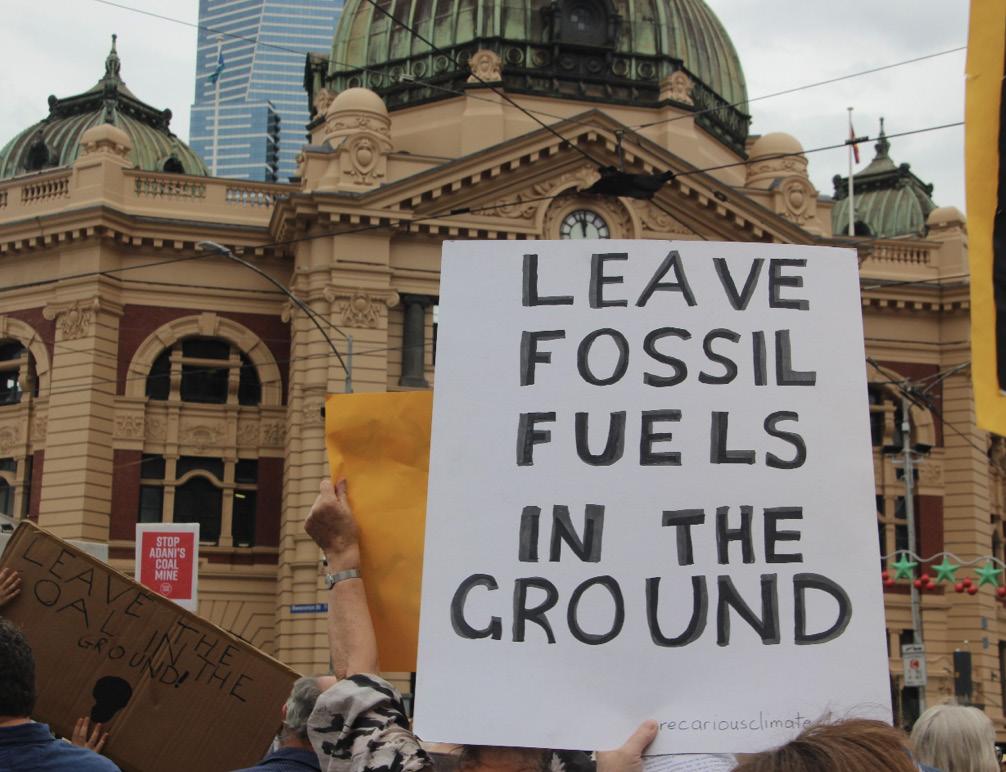
“A
well-funded, evidence-based public health approach could really break through and erode the social license of the fossil fuel industry.”
—LINDA RUDOLPH, PRINCIPAL INVESTIGATOR
AT THE PUBLIC HEALTH INSTITUTE’S CENTER FOR CLIMATE CHANGE AND HEALTH

CITIES AND THE BUILT ENVIRONMENT
ADVANCES AND SETBACKS
Cities will shape the future. Cities are the crucibles of change in the 21st century. They are, increasingly, the places we call home: more than half of humanity now lives in urban areas—a proportion that is expected to top two-thirds by 2050.1 The U.S. is even more urbanized, with about 83 percent of the population living in cities.2 The nature of those cities—their infrastructure, resource use, and social systems—will have profound consequences for our planet and its people, and for the ultimate sustainability of the human enterprise.
Cities can concentrate risk… Most urban growth is taking place in coastal areas, which are dangerously exposed to the rising seas and supercharged storms of a changing climate.3 According to the Urban Ocean Lab, more than 47 million people live in U.S. coastal cities—one in seven Americans. Nearly 60 percent of those coastal residents are people of color, and they have higher rates of poverty and unemployment than the nation as a whole.⁴ And older Americans increasingly live in coastal areas: the number of coastal residents over age 65 grew by nearly 90 percent between 1970 and 2010.⁵ In other words, the most climate-vulnerable groups—the elderly, working class residents, people of color—now inhabit the riskiest places.
…but they also incubate solutions. Urban density fosters synergies that spur innovation; as a result, metropolitan areas account for 90 percent of U.S. economic output.⁶ And cities offer clear advantages for sustainability. Density and economies of scale can encourage more-efficient use of resources. For example, cities are better suited to energy-saving public transit than are rural areas. As cities stretch to accommodate new residents, and as existing infrastructure reaches the end of its useful life, decisions about urban development will shape our nation’s environmental impact for decades to come.
With funding from Partners for Places, the city of Oakland, CA, will co-create a "Rooted and Resilient" plan for the city's Chinatown, advancing communityled climate and resilience priorities.
Jonathan

Cities are rising to the challenge. Over the last decade, cities have worked—on their own and together—to reduce emissions and mitigate climate change. At least 35 of the 50 largest U.S. cities have created climate action plans, although most are in early stages of implementation.⁷ Since 2005, the nonprofit C40 has built a global network of nearly 100 mayors committed to cutting their carbon emissions in half by 2030.⁸ The American Cities Climate Challenge, launched in 2019 by Bloomberg Philanthropies, worked in 25 of the largest U.S. cities to pass new policies on buildings, energy, and transportation that are expected to cut 74 million metric tons of carbon emissions through 2030. And in 2024, Bloomberg launched American Sustainable Cities, a three-year, $200 million initiative that will build on those accomplishments.⁹ The Biden administration’s IRA and bipartisan infrastructure law also made significant investments in urban climate mitigation and adaptation, as detailed in Chapters 5.1 and 5.3.
A vision of sustainable, lower-carbon cities is emerging. In recent decades, “smart growth” and “new urbanism” have emerged as compelling alternatives to dominant development patterns that produce suburban sprawl and polluted inner cities. The vision embraces transit-oriented, walkable, mixed-use neighborhoods where residents can live, work, and shop—surrounded by parks and green space.10 While there are numerous examples of successful smart-growth developments, the vision remains largely aspirational: “We’ve seen a change in thinking,” says Heather Boyer, editorial director at Island Press, “but not as much change in activity on the ground. It’s very difficult to make changes around zoning and planning.”11
Building performance standards aid decarbonization. New standards for building construction hold promise for reducing energy use and emissions. The National Building Performance Standards Coalition, spearheaded by the Institute for Market Transformation, has won policies in more than a dozen cities that reduce emissions by improving the efficiency of buildings’ energy, gas, and water use.12 In 2019,
At least 35 of the 50 largest U.S. cities have created climate action plans, although most are in early stages of implementation.
Kelley Lynch
PROGRESS AND PROSPECTS
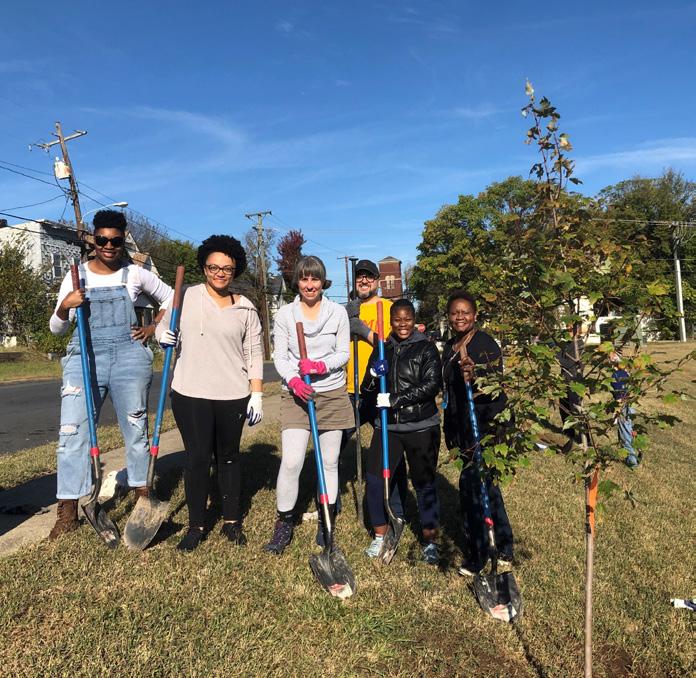
New York City adopted the most stringent standards in the nation, aiming to reduce the emissions produced by the city’s largest buildings by 40 percent by 2030 and 80 percent by 2050.13 Even as the federal government turns away from climate action, state and local governments across the country continue to develop and adopt building performance policies.1⁴
Community-based groups are leading on adaptation. With support from The Kresge Foundation and other donors, frontline organizations have taken the lead on adapting to climate impacts, including flooding (Chapter 5.4 explores frontline groups’ work on extreme heat). In New Orleans, for example, Healthy Community Services (HCS) and its partners implemented over 150 green infrastructure projects— using tree plantings and other natural features to sponge up some 50,000 gallons of storm water in flood-prone areas. One analysis found that every dollar invested in such efforts produces sixfold returns in economic, social, and environmental benefits.1⁵ HCS is part of The Kresge Foundation’s Climate Resilient and Equitable Water Systems (CREWS) grantee cohort, which works at multiple scales and geographies to ensure climate-ready stormwater and wastewater systems for all.1⁶
Cities are embracing nature-based stormwater solutions. Across the U.S., cities like New Orleans are confronting worsening stormwater challenges as climate change brings heavier rain. The nation’s antiquated stormwater infrastructure is not up to the challenge—earning a “D” grade from the American Society of Civil Engineers (ASCE) in 2025.1⁷ Many cities are turning to green infrastructure as an alternative or adjunct to traditional gray infrastructure, like dams and water-treatment plants. Green infrastructure is a win-win-win solution: it reduces flood risk, protects water quality, and provides green spaces for recreation and shade. It can also save money. For example, New York City has saved $1.5 billion by incorporating nature-based solutions into its municipal stormwater infrastructure planning.1⁸ As Mami Hara, CEO of the US Water Alliance, observes: “Green infrastructure and other naturebased solutions have now become more standard practice. In many cities, it’s even standard policy to evaluate those options first.”1⁹
Water infrastructure sees new investment and big challenges. More broadly, water infrastructure faces significant challenges. The nation’s aging, underfunded drinking water systems earned a C- in the ASCE report, and the EPA says $625 billion is needed over the next two decades to bring them up to par. As a downpayment on that investment, the Biden administration’s bipartisan infrastructure law (BIL) allocated $50 billion for water systems, including removal of lead service lines and toxic chemicals.20 The BIL also created 29 Environmental Finance Centers (EFCs) charged with helping communities access the federal funds. Mami Hara, whose organization runs one of four national EFCs, worries that this much-needed system will wither if the Trump administration withdraws support. “All of the information and assistance infrastructure that’s been developed in the past couple of years could evaporate,” she says. “And the growing number of communities that need that assistance will be left out.”21
Meanwhile, climate change continues to raise the bar on water challenges, bringing floods in some areas and lingering drought in others. “Development has run amok in places without a secure water supply, and we are seeing floods in places that no one thought were vulnerable,” says Hara.
The Southside neighborhood of Richmond, VA, is up to 16 degrees hotter than wealthier areas of the city. Southside ReLeaf is using funding from Partners for Places to green and cool their neighborhood.
Southside ReLeaf

At the same time, Americans across the political spectrum support investment in water systems: A poll by the US Water Alliance found that 92 percent of voters identify reliable water access as a very or extremely important issue; 80 percent support continued federal funding for water infrastructure.22 And opinion research by Water Hub found growing concern about threats to water safety from PFAS (88 percent), lead (88 percent), and climate change (79 percent).23
There is new understanding of the inequities that shape U.S. cities… The last decade has seen a surge of research and public conversation about the class and racial inequities that have, quite literally, scarred American cities. That includes the federal government’s redlining policies, which denied investment in neighborhoods of color, causing economic and environmental harms that endure to this day. As noted above, redlining left Black and Brown neighborhoods more vulnerable to climate impacts; lacking parks and green spaces, these neighborhoods are hotter and more flood-prone than wealthier, Whiter areas.2⁴ While redlining was officially outlawed in 1968, racist zoning laws that favor single-family homes persist—and continue to segregate American cities.2⁵
There is new understanding, also, of the harm caused by the construction of interstate highways in the 1950s, which sliced through neighborhoods of color, displacing nearly one million Americans and isolating once-thriving Black communities.2⁶ Just as disastrous were the “urban renewal” policies of the 1960s, nicknamed “Negro removal” by those who lost their homes to this cruel campaign of displacement and redevelopment.2⁷
…and new effort to repair those harms. Amid high-profile police killings of Black citizens and the rise of the Black Lives Matter movement, activists have fought to address the spatial inequities engraved on American cities. One such effort, included in the Biden administration’s infrastructure bill, was the Reconnecting
“Development has run amok in places without a secure water supply, and we are seeing floods in places that no one thought were vulnerable.”
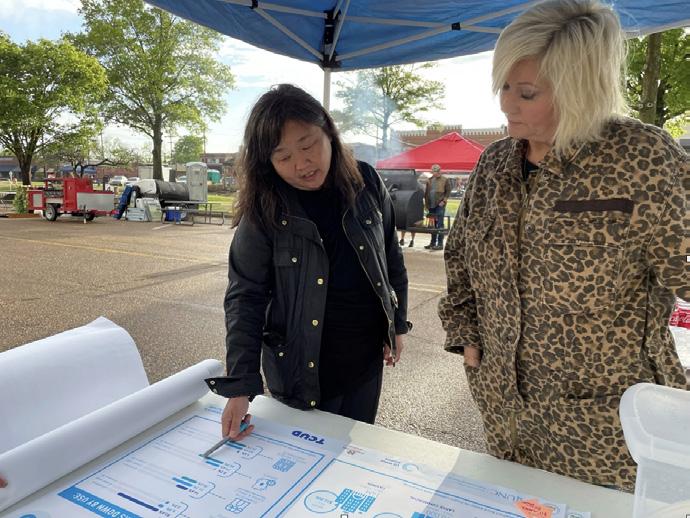
Mami Hara, CEO of the US Water Alliance, talks with a local resident at a community event in Tunica, Mississippi.
—MAMI HARA, CEO OF THE US WATER ALLIANCE
Poster at a Lynchburg, South Carolina, community event hosted by the US Water Alliance.
Bartley Taylor
Mary Morton
PROGRESS AND PROSPECTS
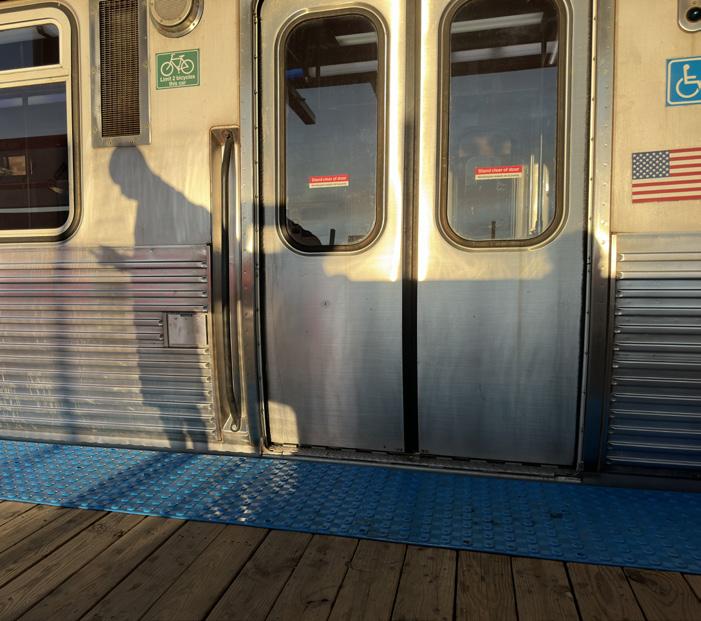
"The amount of transit we're providing is actually less than the public is asking for."
—CHRISTOF SPIELER, DIRECTOR OF PLANNING AT HUITT-ZOLLARS AND LECTURER AT RICE UNIVERSITY
Communities program, which allocated $1 billion in grants to reconnect communities bisected by interstate highways.2⁸ While that program is unlikely to survive the current administration, Liz Ogbu, principal of Studio O, believes that many of the programs it supported—such as ReConnect Rondo in St. Paul, Minnesota—will continue their important work.2⁹
U.S. housing policy is hard on our wallets and the climate. The U.S. is in the grip of a housing crisis, with astronomical prices that reflect a nationwide shortage of 4.5 million homes.30 High prices make it harder for middle- and lower-income families to live near employment and opportunity, causing longer commutes and more air pollution.31 For older adults, who often live on fixed incomes, housing cost burdens are at an all-time high.32 Yet rigid zoning laws and other regulations make it difficult to build housing that is compact, energy efficient, and transit-accessible. Threequarters of residential land in the U.S. is zoned for single-family homes, prohibiting the construction of more-affordable multifamily units.33 By favoring larger homes and auto-dependent sprawl, these policies contribute substantially to the climate crisis: transportation and housing together account for more than half of U.S. carbon emissions.3⁴ Moreover, policies that favor single-family homes do not serve the nation’s aging population and smaller families.3⁵
Transit is making gains, but threats loom. Americans are broadly supportive of climate-friendly public transit, and willing to pay more to live near transit stations.3⁶ The last decade has seen substantial new investment in light rail, streetcar, bus rapid transit, and commuter rail projects.3⁷ In 2024, voters across the U.S. approved 19 pro-transit ballot measures, greenlighting more than $25 billion in spending for public transportation. In Nashville, Tennessee, for example, a transit tax won resounding approval where a similar measure had failed in 2018.3⁸
Another recent win was the approval of congestion pricing in New York City, which took effect in early 2025 after two decades of debate and delay. Following the lead of London and Singapore, the policy charges a fee to drive in the densest part of Manhattan, reducing car traffic and pollution while raising $1 billion each year to upgrade the city’s transit system.3⁹ Its brief run has been successful, cutting crashes and injuries by half, reducing congestion, and boosting transit use.⁴0 The Trump administration has vowed to eliminate the policy, but at this writing, it remains in effect.⁴1
Despite recent gains, “the amount of transit we’re providing is actually less than the public is asking for,” says Christof Spieler, who serves as director of planning at Huitt-Zollars and as a lecturer at Rice University.⁴2 Historically, 80 percent of federal transportation funds have gone to highways and 20 percent to transit—though transit got an extra infusion during the COVID pandemic.⁴3 The share of funding for transit could shrink further under Trump: “You could see the administration killing or freezing some capital projects,” Spieler predicts.⁴⁴ Trump’s transportation secretary, Sean Duffy, has criticized the use of climate change criteria in planning, stating that his department should instead prioritize projects in “communities with marriage and birthrates higher than the national average.”⁴⁵ Moreover, cumbersome approval processes for transit can delay construction by years—or even decades. “There’s a lot more process involved in building a transit line than there is in building a highway,” says Spieler.⁴⁶
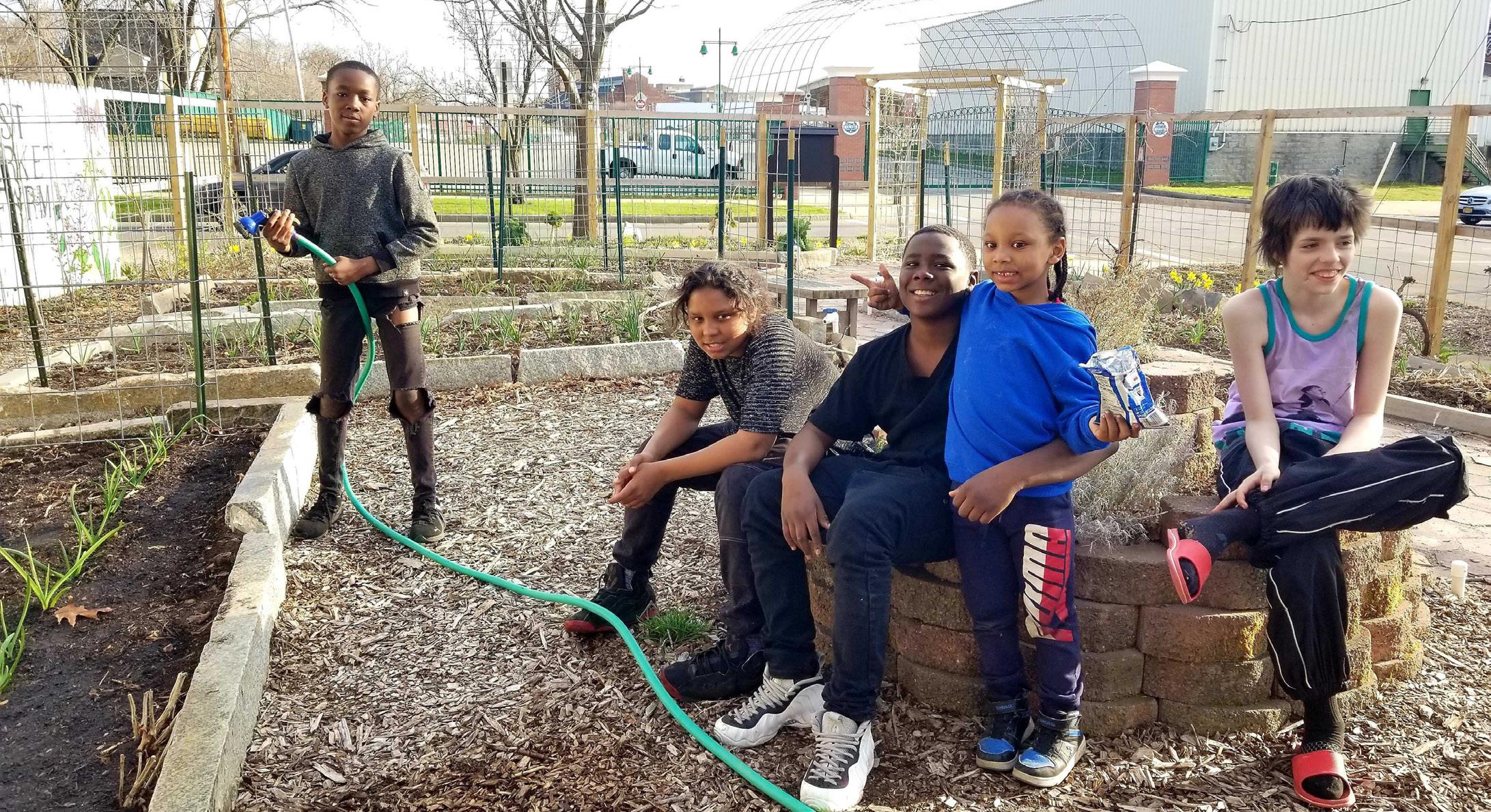
COVID dealt a heavy blow to transit. When the pandemic hit in the spring of 2020, U.S. transit ridership dropped by a staggering 81 percent, and it has yet to fully recover.⁴⁷ By the fall of 2023, ridership was back to just 74 percent of September 2019 levels, starving transit systems of fare revenue that cities and states have not fully replaced.⁴⁸ That is partly due to the rise of hybrid work, says Spieler: “If someone’s coming to the office three days a week instead of five, that’s a 40 percent drop in ridership even though that person is still riding transit.” That may change as more employers force workers back into the office full time.⁴⁹ The danger is that cash-starved transit systems cut service, creating a downward spiral where fewer commuters rely on transit, prompting more cuts and less-reliable service. The transit systems that recovered most quickly after the pandemic were those that serve more low-income riders, who have fewer mobility options than white-collar workers.⁵0
THE PATH FORWARD
Invest in change at the municipal level. Urban areas have always been incubators of innovation, and that is doubly true in the current political context. “Cities have a larger role to play now that the federal government is abdicating its responsibility to protect humanity and the rest of life on this planet,” says Ayana Elizabeth Johnson, co-founder of the Urban Ocean Lab. “It’s a powerful level of government for implementing climate solutions and adapting to the changes that are already here.”⁵1
Thanks to the Biden administration’s IRA and bipartisan infrastructure law, many American cities have contracts to implement mitigation measures—weatherization programs, EV charging stations, solar and wind deployments, and more. If not impounded by the Trump administration, those investments will remain in play
“Cities have a larger role to play now that the federal government is abdicating its responsibility to protect humanity and the rest of life on this planet.”
—AYANA ELIZABETH JOHNSON, CO-FOUNDER OF THE URBAN OCEAN LAB
Above: Local children learn about seed planting in one of the community gardens established by Beechwood neighbors in Rochester, NY.
Taproot Collective
PROGRESS AND PROSPECTS
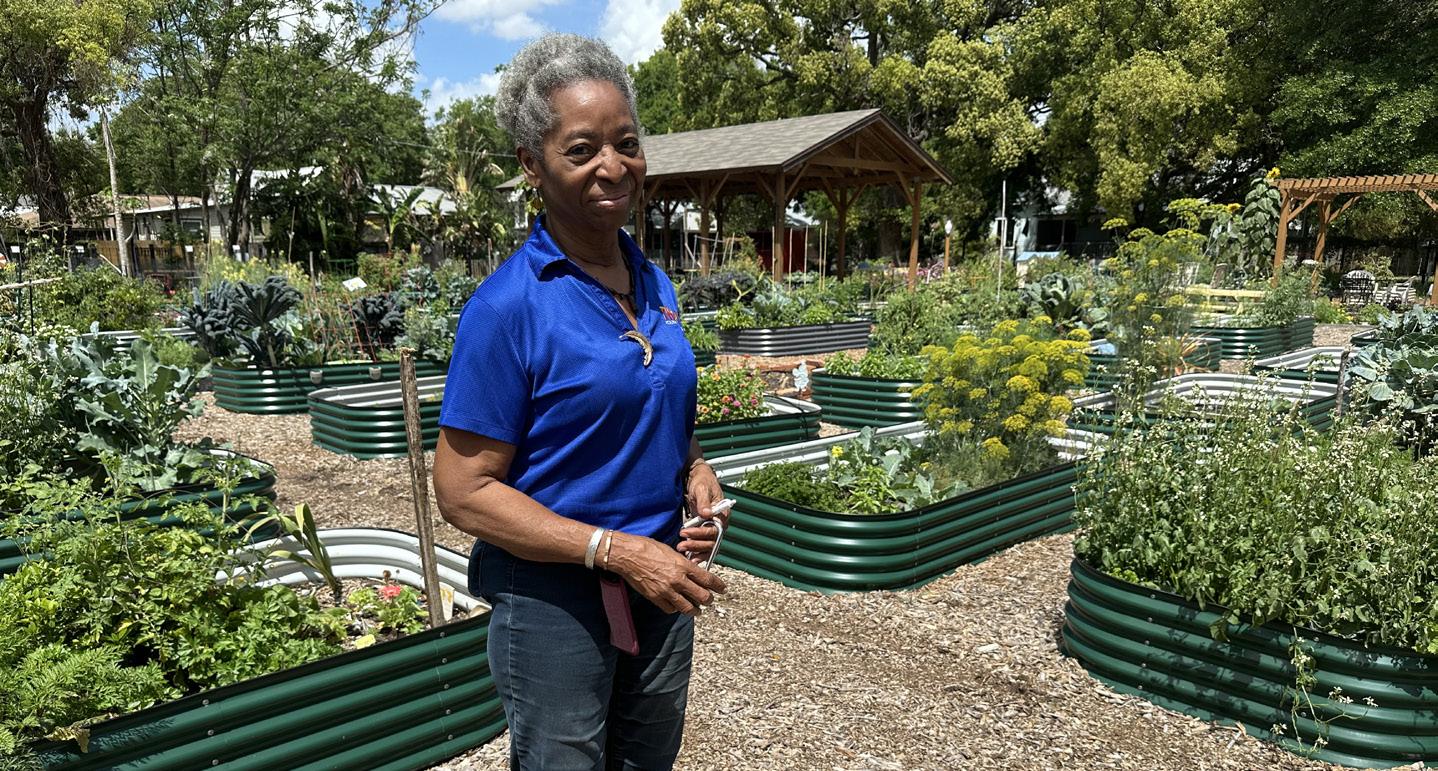
through 2026. Smart deployment of those investments can build political will for climate action if implemented effectively and efficiently.
Funders can preserve forward momentum by supporting bipartisan regional planning entities like the New York metro region’s Regional Plan Association, says Heather Boyer. “These groups have the power and knowhow to work on zoning and affordable housing in areas well-served by transit,” Boyer says.⁵2 Continued support will be needed to advance gains in smart growth, building performance standards, green infrastructure, transit, and equitable development.
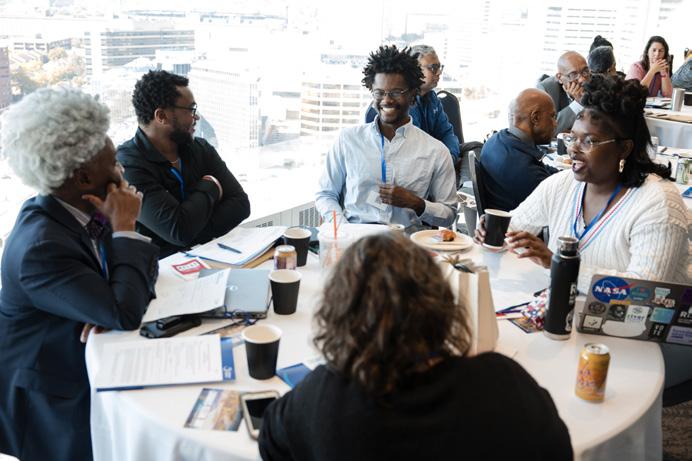
Work with communities to create sustainable water systems. Securing a sustainable water future in the era of climate change will require creativity and experimentation, says Mami Hara. She advocates a broad strategy, because no single approach can meet growing water challenges. “Nature-based solutions are still very relevant, and we need to consider integration of innovation and technology into these approaches,” she says. “We also need to think about hybridization of gray and green infrastructure as the need intensifies.”⁵3 In the coming years, the US Water Alliance will focus on developing more partnerships and cooperation across localities, states, and regions.
Community engagement is key, Hara says. By working with residents to understand water challenges and co-create solutions, utilities and planners can build enduring support for sustainable water systems. One example of this approach is the Shape Our Water initiative, which Hara helped develop when she served as general manager and CEO of Seattle Public Utilities.⁵⁴ The initiative brought together utility staff and residents to design a 50-year plan for Seattle’s drainage and wastewater systems. “The beautiful thing about it was that community leaders helped in the design of the engagement, so it was not something that’s done to them, but with them,” Hara says.
Build the housing we need. The U.S. housing crisis presents an opportunity to address the shortfall of housing units by building homes that are affordable, energy efficient, and climate resilient. A recent study found that more than half of
Lena Young Green, founder of the Tampa Heights Junior Civic Association, in her community garden. Lena is working with Anthropocene Alliance to apply for grants to support their garden and sustainability projects.
Participants in the US Water Alliance’s 2024 Workforce Institute.
Stephen F. Eisenman
Jon Armstrong Photography
Americans would prefer to live in an attached home in a walkable neighborhood, but only about 8 percent of our built environment meets that description.⁵⁵
One solution is to build more of what Dan Parolek, founding principal of Opticos Design, calls “missing middle” housing—townhouses, duplexes, and other housing that comprises the midpoint between single-family dwellings and larger apartment buildings.⁵⁶ Missing middle housing is a good fit for older Americans who want to downsize their homes, and for smaller families. While this type of housing was common in American cities before 1940, misguided zoning makes it much harder to build today.⁵⁷ Several jurisdictions are working to change that. Minneapolis outlawed single-family zoning in 2018, but its plan has been tied up in legal challenges ever since.⁵⁸ Similar policies have been proposed in Arlington, Virginia, Montgomery County, Maryland, and in five cities in California—but all face stiff resistance from existing homeowners.⁵⁹
The Trump administration’s gutting of the federal government could produce some unintended benefits. Danielle Arigoni, director of the EPA Region 8 Environmental Justice Division, notes that deregulation may spur construction of more affordable housing: “In some ways we have overregulated to the point that it is cooling development,” she says. Arigoni adds that insurance companies will be mindful of climate risks, given their financial stake, and likely prevent construction in hazardous areas.⁶0 Laurel Blatchford, senior fellow at Delivery Associates, notes that “devolving some of the federal work on housing to the local level isn’t necessarily bad. It could be a big opportunity for innovation—tying development more closely to local needs.”⁶1 At the same time, Heather Boyer warns that “just focusing on the supply side of housing is not enough. It has to have affordability built in, through

Karolina Grabowska

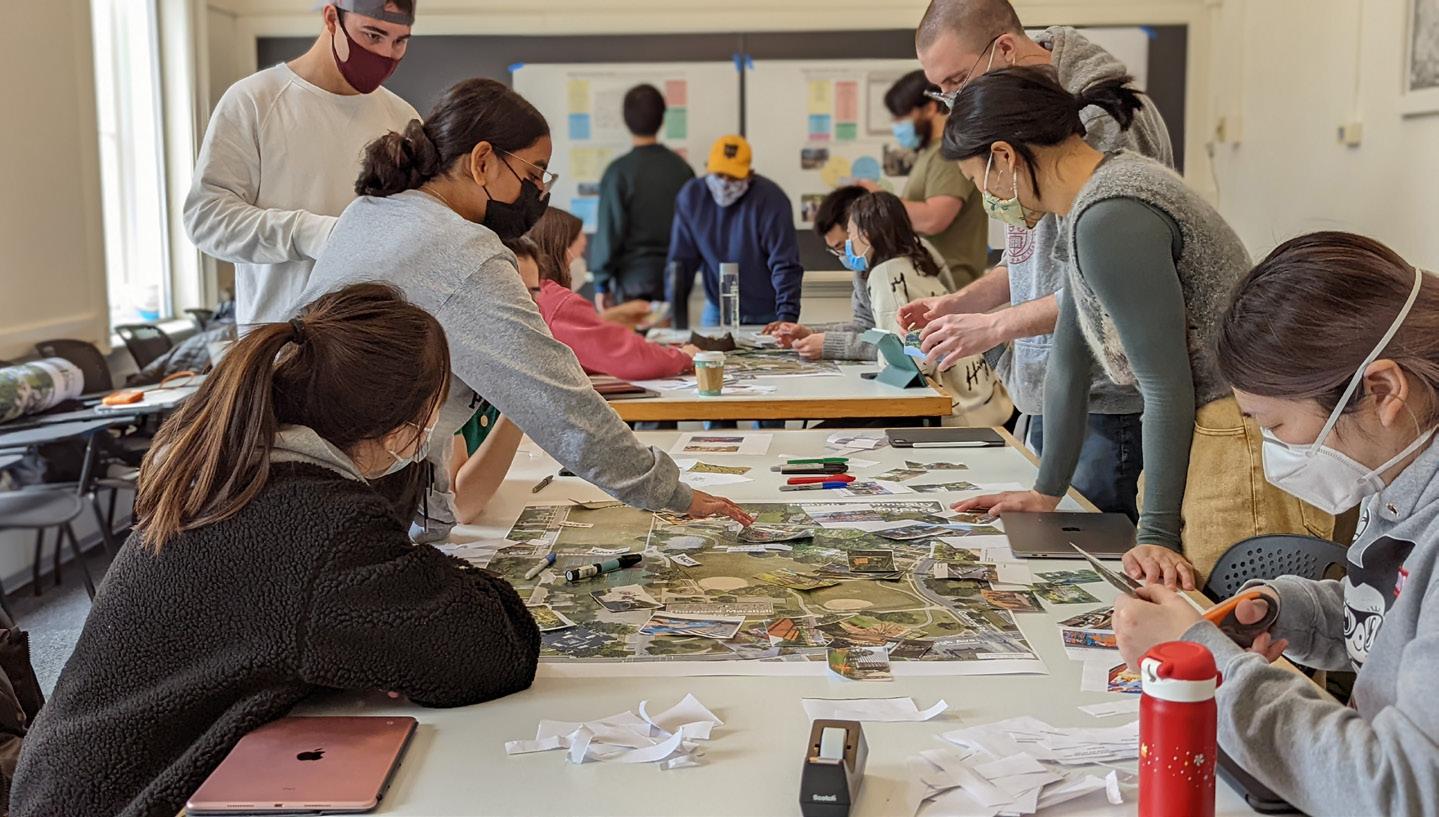
Cuyahoga County, Ohio: Cornell University urban design students helped propose ideas for the 2.6-acre Hough Community Green Space in Cuyahoga County after meeting with community members.
incentives or vouchers.” Building more luxury housing will not “trickle down” to solve the housing crisis for working-class Americans.⁶2
Make transit better (and build it faster). Unsurprisingly, better service is the key to transit success. For example, Christof Spieler observes that transit systems with all-day service recovered more quickly after the pandemic, because they are more convenient for service workers—loyal transit riders—who are less likely to work 9 to 5. High-quality, frequent transit service needs a solid base of tax revenue to operate, says Spieler; fare-dependent systems are vulnerable to disruptions, like the pandemic, that can send them into a death spiral. For inspiration, look to the North: Canada has better transit service and higher ridership than the U.S., with similar land-use patterns. Canadians achieve this by allocating tax revenue for transit and spending less on highways.⁶3
Spieler says it is important to streamline approval processes for transit, while still encouraging public engagement. “We need public input and transparency,” he says, “but we need there to be fewer steps in the process. If the process of getting input on a new line takes two-plus years, it actually makes it more difficult for the public to get involved.” In addition, Spieler calls for more-effective transit agencies, courageous leadership from elected officials, and an organized advocacy community to hold agencies and leaders accountable.⁶⁴
Heal the harm. Racial and class inequities have scarred American cities, and we cannot build fairer, greener cities without understanding and mitigating those harms. We cannot fix urban heat islands without addressing the legacy of redlining, which deprived Black neighborhoods of trees and green space. We cannot deal with stormwater flooding without addressing the policies that drive working class people of color to the low-lying margins of American cities. And we cannot build the housing we need without revising racist zoning laws that favor affluent, White suburbanites. “There is no simple answer to the question of how to heal the places we call home,” writes Liz Ogbu. “But it is clear that we must account for the past, reckon with the arc of harm and benefit, and create a pathway to repair.”⁶⁵
“There is no simple answer to the question of how to heal the places we call home. But it is clear that we must account for the past, reckon with the arc of harm and benefit, and create a pathway to repair.”
—LIZ OGBU, PRINCIPAL OF STUDIO O
Western Reserve Land Conservancy
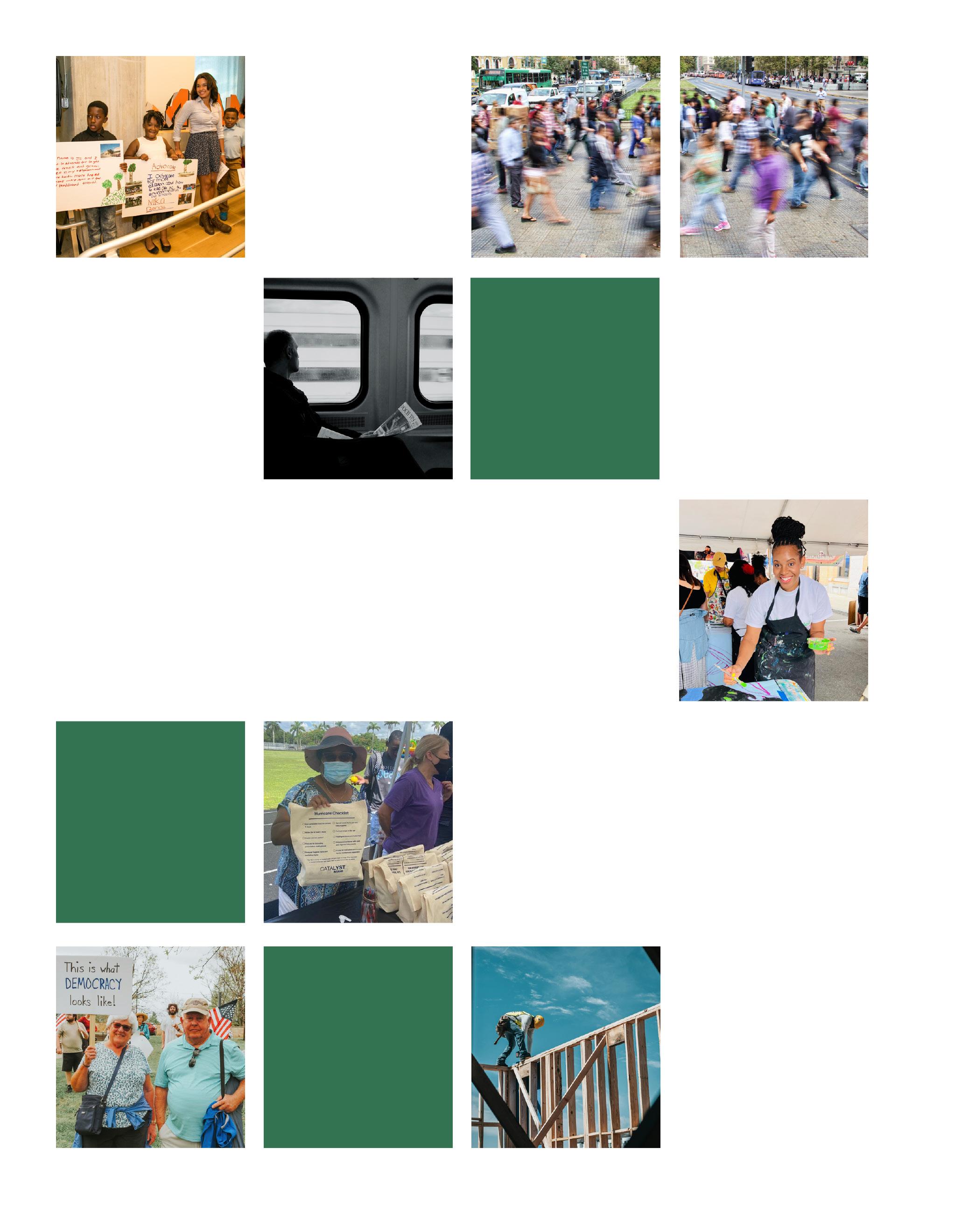

6 | REALIZING RESILIENCE
“We are our own first responders.”
—DENISE FAIRCHILD, FOUNDER OF THE UBUNTU CLIMATE INITIATIVE
REALIZING RESILIENCE
MEETING THIS MOMENT: RECOMMENDATIONS FOR FUNDERS AND OTHERS
Chapter 5 offers detail on progress and prospects for advancement in several domains, but some learnings apply more broadly. Here, we offer a set of general principles for how funders and advocates can advance resilience in the current context.
Build frontline capacity. Frontline, community-based organizations are the backbone of a resilient society. These groups, which have direct knowledge of local conditions and earn trust by responding to their neighbors’ needs, are uniquely prepared to identify and solve community challenges. “The people who are closest to the problem are closest to the solution,” says Nathaniel Smith, chief equity officer at the Partnership for Southern Equity.1 As the federal government withdraws from a commitment to climate resilience, the role of frontline groups will only grow.

Community groups are the first line of defense in any disruption, as we saw during the COVID pandemic, when many frontline groups pivoted from their usual work to supply personal protective equipment and coordinate mutual aid.2 This role is especially crucial in underserved communities, where official assistance may be slow or nonexistent. “We are our own first responders,” says Denise Fairchild, founder of the Ubuntu Climate Initiative.3
Frontline groups can have impact far beyond their community borders, by spurring policy change at the state and national levels. In 2019, New York Renews, a coalition of over 200 community-based organizations, helped the state pass one of the world’s most ambitious climate plans, which later inspired the Biden administration’s signature climate bill.⁴ And in Newark, New Jersey, the Ironbound Community Corporation and NJ Environmental Justice Alliance won a first-inthe-nation Environmental Justice-Cumulative Impact Ordinance in 2016.⁵ The
In 2020, Catalyst Miami provided hurricane preparedness kits and PPE to community members.
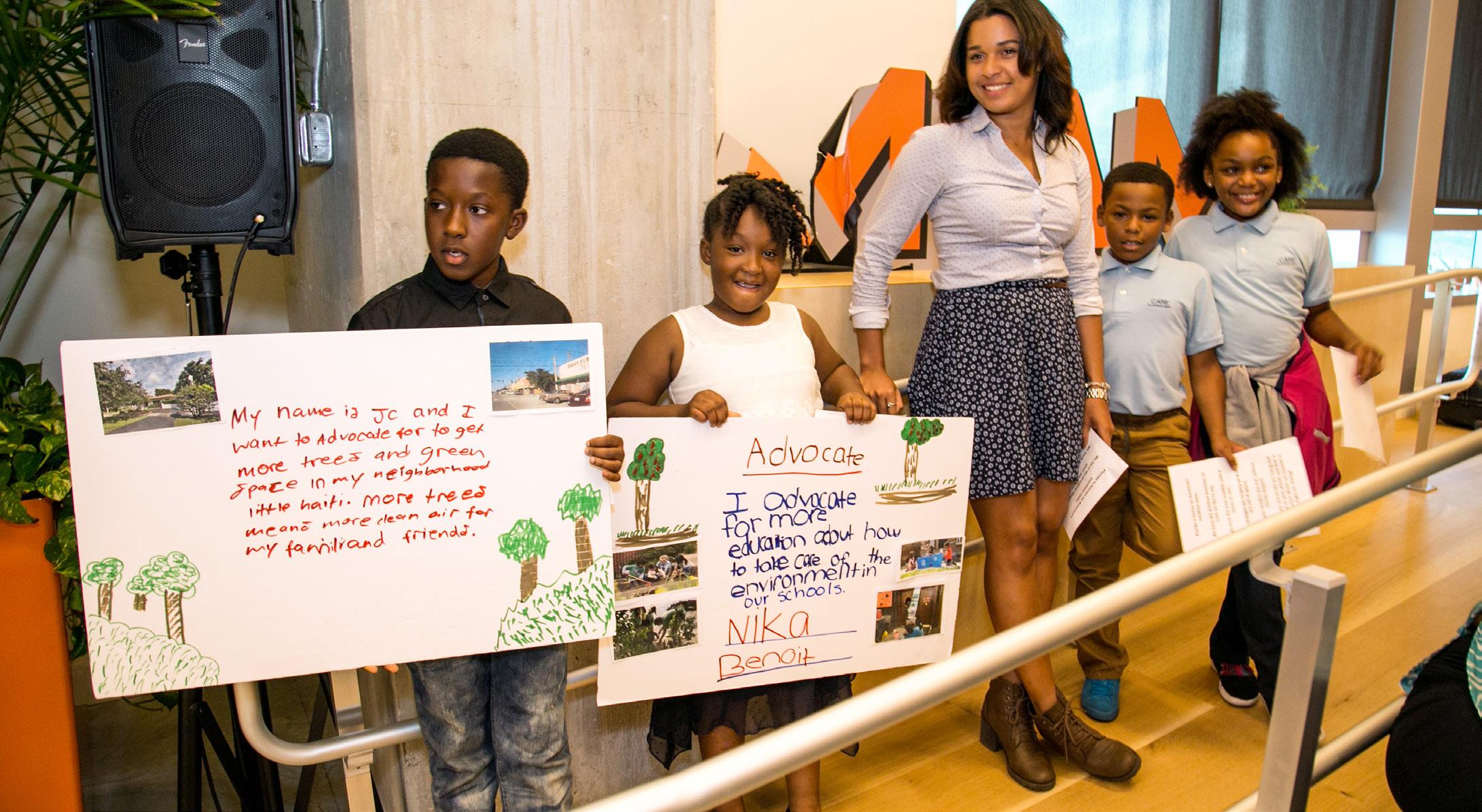
ordinance requires permitting for industrial projects to consider existing conditions in a community, to ensure that new projects—including power plants and other greenhouse gas emitters—don’t worsen unjust toxic burdens. The ordinance has since been copied by several other communities.⁶
Despite their impact, frontline organizations receive dramatically less support than national environmental groups. A report by Building Equity and Alignment for Environmental Justice found that in some regions, only about one percent of grants from the 12 largest environmental funders went to frontline organizations.⁷
Funders can provide direct support to community-based groups, preferably with unrestricted, multi-year grants and manageable reporting requirements.⁸ They can also support intermediary funds (also known as non-endowed or pooled funds) that regrant to frontline groups.⁹ According to Shamar Bibbins, managing director of the Environment Program at The Kresge Foundation, funding intermediaries, such as the Hive Fund for Climate and Gender Justice, the Solutions Project, and the Climate and Clean Energy Equity Fund, “allows us to go much deeper into places and communities that otherwise we would not be able to reach.”10
Focus on change at the subnational level. Meaningful resilience-building efforts require coordinated efforts at the national, state, and local levels, but federal action is unlikely under the Trump administration. Still, city and state governments offer promising opportunities to advance resilience, as detailed in Chapter 5.
In the vacuum left by federal support, funders and others can scale up local resilience efforts by supporting cooperation among stakeholders: community groups, advocacy organizations, local government, and the private sector. They can focus on policy change in municipal governments, state legislatures, and public utility commissions. And they can build powerful partnerships that span localities and regions, including those with shared geography and resources.
"Funding intermediaries allows
us to go much deeper into places and communities that otherwise we would not be able to reach.”
—SHAMAR BIBBINS, MANAGING DIRECTOR OF THE ENVIRONMENT PROGRAM AT THE KRESGE FOUNDATION
Above: Graduates of the youth portion of Catalyst Miami's climate justice training give their presentations. Catalyst Miami
REALIZING RESILIENCE

The key is consistent support: in recent years, philanthropic commitments to subnational work have ebbed or flowed depending on who is in the White House, leaving cities strapped for funds just as they enter the implementation phase of sustainability and resilience projects launched during the Biden administration. Connect local, regional, and national groups. Community-based groups, on their own, cannot address today’s enormous environmental and social challenges. Funders can augment the capacity of frontline organizations by networking them with similar groups in other communities—providing both moral support and technical assistance.
As federal support dwindles, it is critical to scale up local resilience efforts by supporting cooperation among stakeholders (community-based groups, advocacy organizations, local government, the private sector) across localities and regions. Lois DeBacker, former managing director of The Kresge Foundation’s Environment Program, recommends asking, “What is the geographic ‘problem shed’? Do the proposed solutions match—or at least recognize—that scale?”11 There are effective models of regional cooperation in localities with shared resources, including the Great Lakes, Chesapeake Bay, and Colorado River.12 DeBacker also notes that “there’s a danger in only hanging with one crowd—it’s really important to support innovators in multiple sectors and help them communicate with one another.”13 It is also effective to link local groups with national organizations that provide legal, communications, fundraising, and scientific expertise. Connecting local and national groups benefits both: local groups get assistance they may not be able to access on their own; national groups get vital information about local challenges and solutions. The Kresge Foundation has supported several cohorts of grantees
Kresge Foundation
A network map of The Kresge Foundation's Climate Change, Health & Equity initiative. Kresge has supported several cohorts of grantees that unite community-based organizations with national groups.
that unite community-based organizations with national groups. As described in Chapter 5, these networks have proven remarkably effective in leveraging resources and advancing policy change.
Support leaders… “Funders need to invest in leaders, not just organizations,” says Ayana Elizabeth Johnson, co-founder of the Urban Ocean Lab.1⁴ Leaders catalyze movements; they are nurturers of relationships, holders of institutional memory, and invaluable sources of wisdom and perspective. Support can include mentoring and development of emerging leaders, and opportunities for veteran leaders to regroup, convene, and think creatively.
It is especially important to support leaders of frontline organizations, who often carry unsustainable burdens. Many are women of color, living in marginalized communities where they face the same outsized challenges as their neighbors while responding to urgent needs and fighting for long-term change. And many are simply exhausted.1⁵
“There’s so much that people are holding,” says Jacqueline Patterson, founder of The Chisholm Legacy Project. “We need to make sure someone is holding the holder.”1⁶ Patterson’s organization and others have launched efforts to do just that, through peer support cohorts, retreats, sabbaticals, grant programs, and stipends for frontline leaders.1⁷
Funders have a particular responsibility to care for these leaders, says Shamar Bibbins: “If we are committed to building this field, we need to think about the well-being of the people we are serving. It’s not sufficient to ask organizations about their fiscal health. We should be just as interested in the health of the people of the organization.”1⁸
…and keep them safe. Amid a rising tide of hate and political violence in the U.S., women of color—especially frontline and nonprofit leaders—are disproportionately singled out for threats and harassment.1⁹ Three such leaders, who remain anonymous for safety reasons, describe their experience in The Real News Network: We have been threatened — online and in person — with rape and murder. We have been stalked and surveilled, in our homes and on the street. Our online meetings have been “Zoom bombed” by hackers who fill our screens with pornography and horrific images of racial violence. Our names and addresses appear in social media and on hate-filled websites, with exhortations to do us harm. Our families, too, have been targeted.20
Several foundations and intermediary groups have stepped up to keep leaders safe online and in person.21 But, Jacqueline Patterson says that safety must be everyone’s job, particularly philanthropy: “If you’re funding folks to be on the front lines and in harm’s way, you need to take responsibility and provide resources to keep folks safe.”22
Trust grantees, and be flexible. Recent years have seen a new emphasis on “trustbased philanthropy,” which seeks to lessen power imbalances and create moreeffective partnerships between funders and grantees. According to the Trust-Based Philanthropy Project, this approach includes giving multiyear unrestricted grants, streamlining paperwork, being transparent and responsive, and soliciting and acting

“There’s so much that people are holding. We need to make sure someone is holding the holder.”
—JACQUELINE
PATTERSON, FOUNDER OF THE CHISHOLM LEGACY PROJECT.
Dr. Neelu Tummala speaks during the "Story of Self" session at the "Our Planet, Our Health: 2025 Climate Action Convention.”
Aidan Demolli
REALIZING RESILIENCE
on feedback.23 For Shamar Bibbins, who came to philanthropy from a nonprofit that works alongside communities, trust-based philanthropy is nothing new: “It’s really just about being a good partner.” The Kresge Foundation embodies this approach, she says, with consistent funding and deep partnership through which funders and grantees “build and weave together.”2⁴
Given the complex systems grantees are working within, trust-based philanthropy requires flexibility on both strategy and outcomes. This allows grantees to respond to emergent crises and opportunities, says Elizabeth Sawin, director of the Multisolving Institute. She adds, “If funders want to be helpful in this time of uncertainty and destabilization, they can’t ask people what’s going to happen next and how they will respond—[the grantees] will just be making it up. Instead, funders can build capacity to respond to whatever happens.” That may require putting aside the foundation’s strategic plan, or its tried-and-true strategies—but the potential rewards are great. “Do we want to do what needs to be done, or what we know how to do?” Sawin asks.2⁵
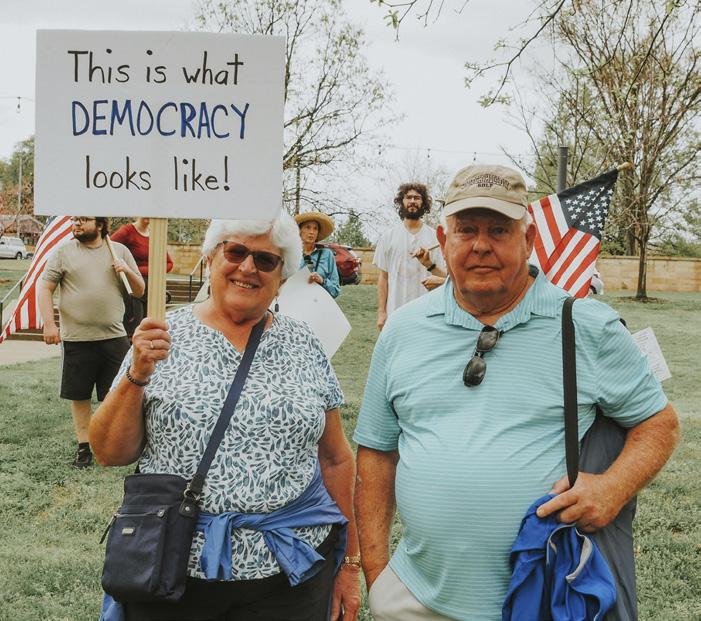
Connect sectors and solutions. In our complex, interconnected world, problems are often linked. For example, climate impacts are made worse by inequity, and inequity is exacerbated by climate impacts. But solutions are connected as well. That means a single policy or investment can sometimes solve many problems at once. Weatherizing homes, for example, can boost resilience by keeping homes more comfortable when the power goes out. It can also reduce cost burdens, create jobs, and lower carbon emissions. Elizabeth Sawin calls this approach “multisolving”—she has founded an organization and written a book of the same name.2⁶ A multisolving approach has political benefits as well, by forging new constituencies across sectors and movements. Create a more-inclusive movement. The need for resilience transcends geographic, cultural, and political boundaries. But in our polarized society, the work of building resilience—mitigating climate change, promoting sustainability and equity—is firmly anchored in what we call “the left.” Many of those interviewed for this report spoke of the need to build a broader, more-inclusive movement for resilience as defined here. That may seem an impossible task in the current political environment. But the 2024 election serves as a reminder that a broader coalition is essential for durable change.
Building that coalition requires better ways to communicate, as detailed in “Shifting the Narrative” below. It requires efforts to connect the dots between resilience and topof-mind issues like affordability and health. And it requires us to build a movement culture that is more welcoming to those from different backgrounds and perspectives.
As Nathaniel Smith explains, “There are times when I have sat in left-leaning conversations, when I start talking about spirituality, when I start talking about love, when I start talking about a Creator—or even just me being who I am, as a heterosexual Black male—sometimes I feel uncomfortable in those rooms. And if I feel uncomfortable in those rooms, how do you think other people feel who may not be as connected or committed?”2⁷
Smith and several others spoke of the need to engage young men of all ethnicities, as well as working-class Americans who have been left behind economically. As Ann Kinzig observes, “It is dangerous to decide that half of your fellow Americans are stupid or greedy or evil.”2⁸ Instead, we must work to overcome “affective polarization,” to build solidarity across demographics, issues, and movements. And, in the policy
sphere, “We need to meet with leaders on both sides of the aisle,” says Anne Evens, CEO of Elevate. “We have to talk to everybody, all the time.”2⁹
Imagine (and create) the future we want. In a moment when so much essential work is under siege, it is natural to assume a defensive posture. But, while “some folks will need to engage in the battles of the next four to eight years, we absolutely need a core group of dedicated folks looking beyond that to dream and create the world we want,” says Shalanda Baker, professor of environment and sustainability at the University of Michigan. “Because as long as we’re only reacting and not creating, we’re only going to be responding to unjust frameworks.”30
Creating more-just frameworks requires shifts in vision and values, which philosopher Joanna Macy has called “The Great Turning.”31 As Denise Fairchild observes, “We can’t create resilience with what we’re doing. We need radical shifts in consciousness and behaviors.” To inform those shifts, we can draw on the indigenous worldviews that sustained humanity through most of history: “The philosophy of ‘it takes a village’ is more resilient than ‘survival of fittest,’” says Fairchild.32
While those interviewed for this report hold diverse opinions and worldviews, some themes emerged. Many see the need to jettison a culture based on exploitation and extraction (of human beings and nature) and consumerism. For Zelalem Adefris, CEO of Catalyst Miami, “Climate is not purely a greenhouse gas emissions issue; it’s a cultural issue about greed. It’s about disrespect for nature and for each other.”33 That is why “green capitalism” is a false solution, says Nathaniel Smith: without addressing that underlying mindset, he says, “we will just replace one extractive economy with another.”3⁴
Others see a need to view the world as a web of relationships among human beings and nature, rather than as a disconnected “collection of things,” in Elizabeth Sawin’s words. In place of rigid hierarchies and caste systems, this worldview proposes radical equality. “What if we are all the same,” asks Liz Ogbu, principal of Studio O. “What if we are all connected in a place of mutuality, where my wellbeing is utterly dependent on your wellbeing, and so to do the best for me means supporting you to do the best for you?”3⁵ It is a positive, optimistic vision that contrasts sharply with the hate and fear that dominates current political discourse.
In addition to a shift in vision and values, we must offer concrete visions and plans for the communities in which we live. For Zelalem Adefris, that means “imagining, in a realistic way, what a thriving Miami looks like over a 200-year arc. What do we need to start building toward to get there? What adaptation would it take to stay here, or where will people go, and how will they be welcomed?” It is important to have such plans in place before a crisis happens, she adds, so that advocates are ready to implement changes when opportunities arise.3⁶
And, wherever possible, we can build projects, communities, and systems that embody the values and principles of resilience. Such efforts can show that another world is possible, creating what Joanna Macy calls “refugia” from systems that are unsustainable and unjust.3⁷ They can also spark broader change: as Nobel laureate and systems thinker Ilya Prigogine has written, “When a system is far from equilibrium, small islands of coherence in a sea of chaos have the capacity to elevate the entire system to a higher order.”3⁸
“We
can’t create resilience with what we’re doing. We need radical shifts in consciousness and behaviors.”
—DENISE
FAIRCHILD, FOUNDER OF THE UBUNTU CLIMATE INITIATIVE
REALIZING RESILIENCE
When funders pivot abruptly, “We risk losing the funding, losing the attention, losing the support of things we know are working and creating lasting systems change.”
—CATE MINGOYA-LAFORTUNE, CHIEF OFFICER OF COMMUNITY ADAPTATION AND LAND USE AT GROUNDWORK USA
Dr.
Stay the course. This extraordinary political moment is a test of our collective resolve, as many advocates and funders question their strategy and commitments. But evidence shows that recent investments in community-led, equity-centered climate resilience have produced outsized gains. As the Trump administration claws back federal funding, and some foundations pivot from this work, it is vitally important that others redouble their commitment to preserve gains and continue forward momentum.
Our opponents are in it for the long haul, says Nathaniel Smith. Indeed, the Trump administration’s slashing of federal agencies is the culmination of a 50-year plan to starve the government and privatize its core functions.3⁹ Likewise, the work of cultivating community power and building resilience takes time and patience; as many advocates remind us, “change moves at the speed of trust.” When funders pivot abruptly, says Cate Mingoya-LaFortune, chief officer of community adaptation and land use at Groundwork USA, “We risk losing the funding, losing the attention, losing the support of things we know are working and creating lasting systems change.”⁴0
Step in, speak up, and spend down. This moment, shaped by escalating climate disaster and political upheaval, is a full-on emergency. Funders can step in to help by filling some gaps left by the federal government and retreating foundations. For example, those with access to emergency funds can provide stopgap funding to prevent grantees from losing critical staff and momentum. As a more-durable solution, “We need to endow some of these organizations that are being attacked by the federal government,” says Nathaniel Smith.⁴1
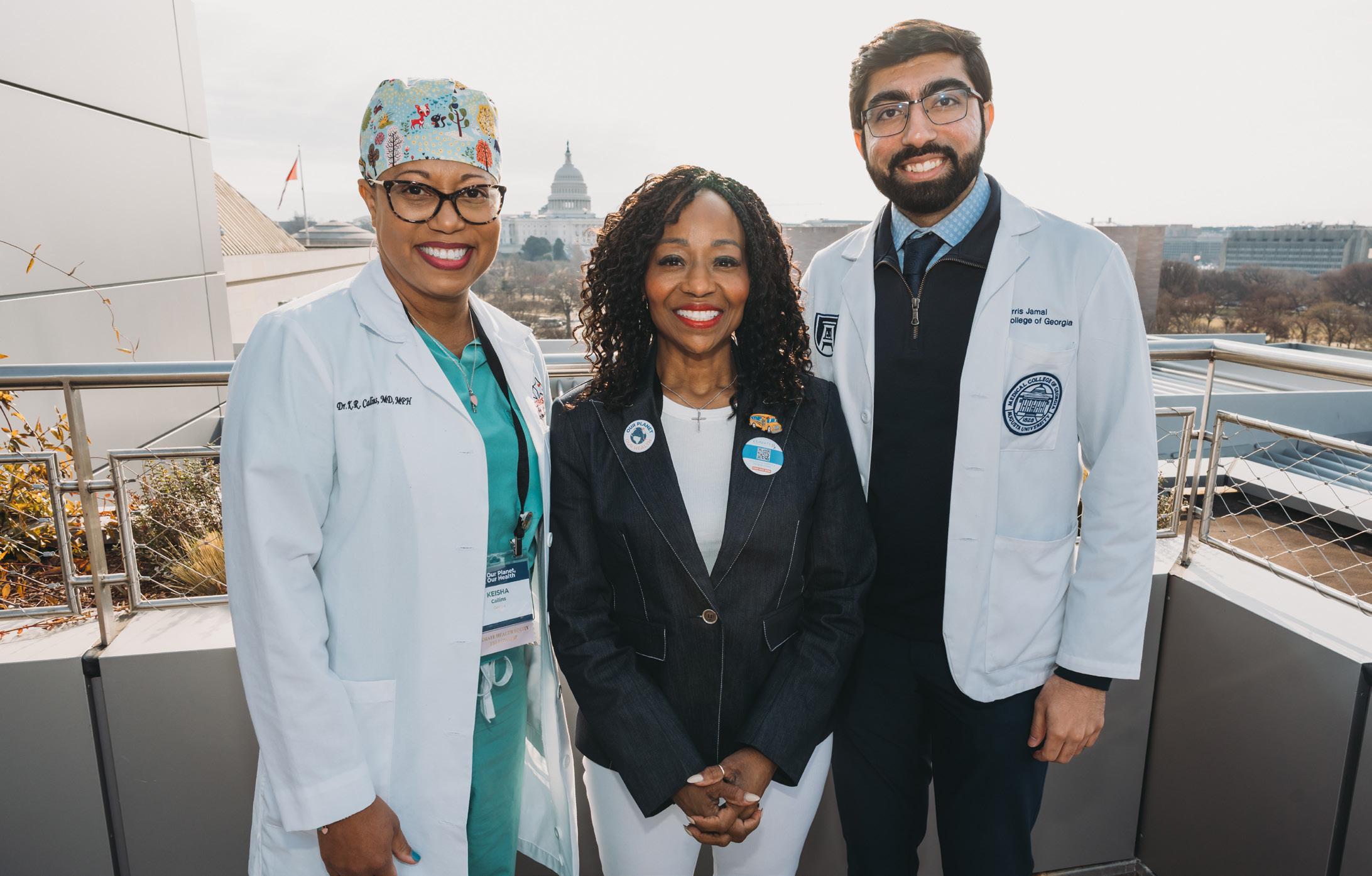
Aidan
Demolili
Keisha Callins, Dr. Kimberly Williams and medical student Harris Jamal visit Congress as part of the "Our Planet, Our Health: 2025 Climate Action Convention".
And funders must speak up, in unison, for the values they hold and the work they support. While the first Trump administration spurred widespread resistance, many are keeping a low profile now. As Ayana Elizabeth Johnson observes, climate philanthropists protested loudly when Trump pulled the U.S. out of the Paris climate agreement in 2017, “but they’ve been mostly silent this time around.”⁴2 Funders hold power and influence; if they remain unified, they could be a potent force of resistance.
Finally, funders can increase their grantmaking to levels commensurate with current challenges. “This is a moment of crisis on all these different fronts—climate, democracy, equality,” says Johnson. “Funders need to give their money away faster, because five percent a year is not cutting it. Make it rain, you guys.”⁴3
SHIFTING THE NARRATIVE
Many of those interviewed for this report expressed frustration about communications—a sense that advocates for resilience, broadly defined, are failing to connect with the public and build support for this urgent work. Below, we offer context and recommendations on how funders and others can shift the narrative in a fast-changing information environment.
The information landscape has transformed. Effective communications are essential to build support for resilience as defined here. But the context for that work has changed dramatically over the last decade. The long decline of legacy media has accelerated in recent years, as newspapers and general-interest publications have been shuttered or hollowed out.⁴⁴ In their place is a cacophonous array of podcasts, livestreams, and social media sites. While these new media offer diverse content and perspectives, many are filled with misinformation and vitriol. The new media reflect—and amplify—our political and affective polarization. As a result, “We do not have a shared set of facts in America anymore,” says Ayana Elizabeth Johnson, “so it’s very hard to even have a conversation.”⁴⁵
Americans care about climate… Amid worsening impacts, Americans have grown more concerned about climate change over the last decade. According to the Yale Program on Climate Change Communication, the percentage of Americans who are either alarmed or concerned about the climate jumped from 47 percent in 2014 to 54 percent in 2024.⁴⁶ Other environmental issues also enjoy broad support; even in the 2024 election, five states approved ballot initiatives that advance climate resilience and conservation.⁴⁷
…but it’s not a top voting issue. Americans don’t always carry their climate concerns into the voting booth. Other polling data from Yale found that climate change ranked 19th among 28 issues listed in deciding a presidential candidate. The economy, inflation, and health care were in the top five.⁴⁸ As a result, we now have a presidential administration that is gutting climate initiatives that enjoy broad support.
These realities suggest some ways forward for effective communications about climate and resilience:
Connect to top-of-mind issues. For messages to gain traction, “You have to be talking about people’s health or their pocketbook,” says Shamar Bibbins. “It has to make
“This is a moment of crisis on all these different fronts—climate, democracy, equality. Funders need to give their money away faster, because five percent a year is not cutting it. Make it rain, you guys.”
— AYANA ELIZABETH JOHNSON, CO-FOUNDER OF THE URBAN OCEAN LAB
REALIZING RESILIENCE
For messages to gain traction, "you
have to be talking about people’s health or their pocketbook. It has to make financial sense or health sense.”
—SHAMAR BIBBINS, MANAGING DIRECTOR OF THE ENVIRONMENT PROGRAM AT THE KRESGE FOUNDATION
financial sense or health sense.” Communications strategist David Fenton agrees, arguing that progressives have “failed to communicate at the level of people’s values or daily struggles—if we communicated at all.”⁴⁹
Show what people can do. For Cate Mingoya-LaFortune, the biggest problem is that people don’t know how to have an impact. “There’s a huge misperception that a lot of people don’t care about the climate,” she says. “It’s probably 90 percent paralysis around not understanding how to intervene and worry about the time and financial costs of intervening.”⁵0 That is why Mingoya-LaFortune authored a book, Climate Action for Busy People, which identifies easy ways to take action—like tree plantings, coalition-building, and data collection.⁵1
Tell stories and connect the dots. Climate change has far-reaching impacts on daily life, but Americans are sometimes unaware of the connections. For example, air pollution and extreme heat are causing more red-flag days with poor air quality. “If you have a kid with asthma, and they can’t safely play outside in the summer, that’s an air quality issue. That’s a climate adaptation issue,” says Mingoya-LaFortune. She adds that it is important to help people make those connections and show how they can keep their family and community safe. And the best way to make connections is through storytelling, says Shalanda Baker, professor of environment and sustainability at the University of Michigan: “Numbers don’t tell the story; data doesn’t tell the story,” she says. “When you’re able to connect the dots so that it lands on a personal level, that’s what resonates.”⁵2
Don’t let a disaster go to waste. Escalating climate impacts also offer opportunities to connect the dots. From farmers facing crop failures to people displaced by wildfires and floods, more Americans are touched by climate change every year. “There are ways to not capitalize on these disasters, but use them as teachable moments,” says Lois DeBacker. ⁵3 Moreover, every disaster spawns stories of resilience, says Stephen Flynn, founding director of the Global Resilience Institute at Northeastern University. “We need to find those stories of societal resilience, of community resilience, and celebrate them, and then find ways we can grow them,” he says.⁵⁴
Don’t always center climate. In this polarized political climate, the term “climate change” closes minds and ends conversations with many Americans. According to Water Hub research, “resilience,” fares better, and “preparedness” better still.⁵⁵ But the fact is, resilience measures remain broadly popular. One interviewee, who wishes to remain anonymous, recalls a conversation he had with the mayor of a small town in Texas. “The mayor said, ‘If I tell folks in my town that I want to do stuff that protects them from heat and drought, 90 percent of the folks will say yes. If I tell them I’m going to do something about climate change, 90 percent will say no.’”⁵⁶ Others working in red and purple states report similar experiences, concluding that it is more important to advance the work than to call it by its rightful name.
Stand up for fairness. Similarly, Americans care about fairness, but the term “equity” has been demonized as DEI’s middle name. Some oppose DEI precisely because they’ve been told it confers unfair advantages to people of color.⁵⁷ But climate impacts are deeply unfair, compounding the effects of discrimination. For
example, segregation pushed communities of color into less-desirable, low-lying areas that now flood regularly. And formerly redlined neighborhoods received less investment and fewer amenities; today, those neighborhoods have more concrete and fewer green spaces and are therefore more vulnerable to flooding and heat.⁵⁸ When Americans learn about the legacies of discrimination and the disproportionate harms of climate change, most endorse “climate justice” initiatives to redress those harms.⁵⁹ So, it is important to show that efforts to help marginalized communities are promoting fairness, not undermining it.
Communicate grounded hope, not fear. Several interviewees call for more messaging based on hope and possibility, rather than doom and fear. “We spend a lot of time on, ‘If we don’t do this, the polar ice caps are going to melt and we’re going to die,’” Nathaniel Smith says.⁶0 “Instead, we need to communicate about ‘How do we create a better world for all people.’” Denise Fairchild agrees, calling for a new narrative of joy and possibility, rather than doom and sacrifice.⁶1
Amplify new voices… In addition to new messages, we need new messengers: “Amplify a multitude of voices,” says Shamar Bibbins, “not just the usual suspects. That will allow a broader conversation about what people actually need to survive and thrive through all kinds of shocks—climate and otherwise.”⁶2
…and use new media. Bibbins and others call for expanded work with influencers, social media, podcasts, and other platforms. Even as mainstream, legacy media declines, there are many niche publications, mostly online, that cater to specific audiences: hyperlocal nonprofit news outlets, ethnic media, publications aimed at urban planners and local officials. Many of these outlets are hungry for content and offer a direct way to reach important stakeholders.
“We have to think way beyond the news media,” says Nicole Lampe, managing director of Water Hub. Lampe suggests building a network of progressive water and climate-justice influencers who can communicate to niche audiences, such as parenting and health bloggers. That work must be backstopped by investments in reporting capacity: “Without reporting, we can’t equip influencers to do their storytelling.” Lampe adds that Black and Latino news outlets are especially in need of reporting capacity on environmental issues.⁶3
Support arts and culture. Arts and culture are vital for communicating about the challenges we face and the world we want. “Climate can be part of our cultural conversation, as opposed to a technical and policy conversation,” says Ayana Elizabeth Johnson. She calls for “climate solutions to saturate popular culture— movies, TV, films, music. Because right now it’s barely a blip in the content people are seeing, unless they specifically seek it out.”⁶⁴
Beyond their value as a communications tool, “Arts and culture are our seed banks in dark times,” observes Jeremy Hays. “That’s where folks will hold the kernels of our values and protect them through the winter of autocracy… stewarding them into the next wave of opportunity.”⁶⁵

“Arts and culture are our seed banks in dark times. That’s where folks will hold the kernels of our values and protect them through the winter of autocracy… stewarding them into the next wave of opportunity.”
— JEREMY HAYS, MANAGING PARTNER, UPRIGHT CONSULTING SERVICES
Ivan Samkov/Pexels


7 | REASONS FOR HOPE
REASONS FOR HOPE

"Hope is a duty to the future."
—SUSANNE MOSER, PRINCIPAL AT SUSANNE MOSER RESEARCH AND CONSULTING
REASONS FOR HOPE
The challenges outlined in this report are daunting, though counterbalanced by recent accomplishments and prospects for meaningful change. Beyond that, each of the leaders interviewed for this report offered their own reasons for hope in these tumultuous times. “Hope,” says Susanne Moser, principal at Susanne Moser Research and Consulting,“is a duty to the future.”1
Crises present opportunities for transformation. Many interviewees predict dark times ahead: climate disasters, political upheaval, a profoundly weakened democracy. But even in this moment, there are opportunities for transformative change. Disruption drives innovation, and communities continue to engage in creative problem-solving at the local and regional levels. It is critically important to build on that innovation, and craft a comprehensive vision of the world we want. On the other side of chaos and disruption there will be opportunities to make that vision a reality.
We know that transformation is necessary: the systems that shape our world are neither sustainable nor just. But systems—and the worldviews that guide them— rarely shift in times of calm. It is in tumultuous times that people see how current worldviews are not serving us. “People are getting fed up,” says Cate MingoyaLaFortune, chief officer of community adaptation and land use at Groundwork USA. “And they are beginning to question why things look the way they do. And that, I think, is a historically proven precursor to bigger change.”2
Change is possible. Indeed, change is the natural order of all things, in the natural world and in human society. The age of fossil fuels, too, will pass. But its passage will require a vast reordering of our economy, our politics, and our shared values. “It sounds impossible,” observes Denise Fairchild, founder of the Ubuntu Climate Initiative. “But history offers a model for this kind of transformative change: the dismantling of the slave economy in the 19th century.”3 The abolitionist movement,

the labor movement, battles for civil rights and environmental protection—all offer lessons and hope for the struggles at hand. And for those who fear the current system is permanent, EcoAdapt director Lara Hansen offers the oft-quoted sentiment: “We didn’t leave the Stone Age because we ran out of stones.”⁴
Solidarity is powerful. At a moment when so much is threatened, many interviewees see new cooperation and solidarity among those working on climate, social justice, and related issues. “Everyone is starting to see that we are better together, that some of the things that cause false divisions are less important, and that what’s most important is that we come together a lot more,” says Jacqueline Patterson, founder of the Chisholm Legacy Initiative.⁵ Ayana Elizabeth Johnson, co-founder of the Urban Ocean Lab, agrees: “People are realizing the limits of what any one organization can do and figuring out ways to coordinate and be more impactful,” she says.⁶
There is joy and comfort in solidarity, as well as power. “There’s a lot of people who are deeply committed to this work, who will keep going,” says Lois DeBacker, former managing director of The Kresge Foundation’s environment program. “I’m hopeful that people will look out for one another and hold each other up and find bits of joy, even as all this evil stuff happens around us.”⁷
We’ve been here before. No struggle against exploitation (of people or planet) has ever been won easily or permanently. For all of us—and for Black Americans, in particular, there is strength in that history: “We have endured every oppressive system from slavery through Jim Crow onward,” says Denise Fairchild. “And we got through it the same way we’re going to get through this: with a communal, collective effort. That’s how we manage oppression and disruption. That’s the only work.”⁸
"Everyone is starting to see that we are better together, that some of the things that cause false divisions are less important, and that what’s most important is that we come together a lot more."
—JACQUELINE PATTERSON, FOUNDER OF THE CHISHOLM LEGACY INITIATIVE
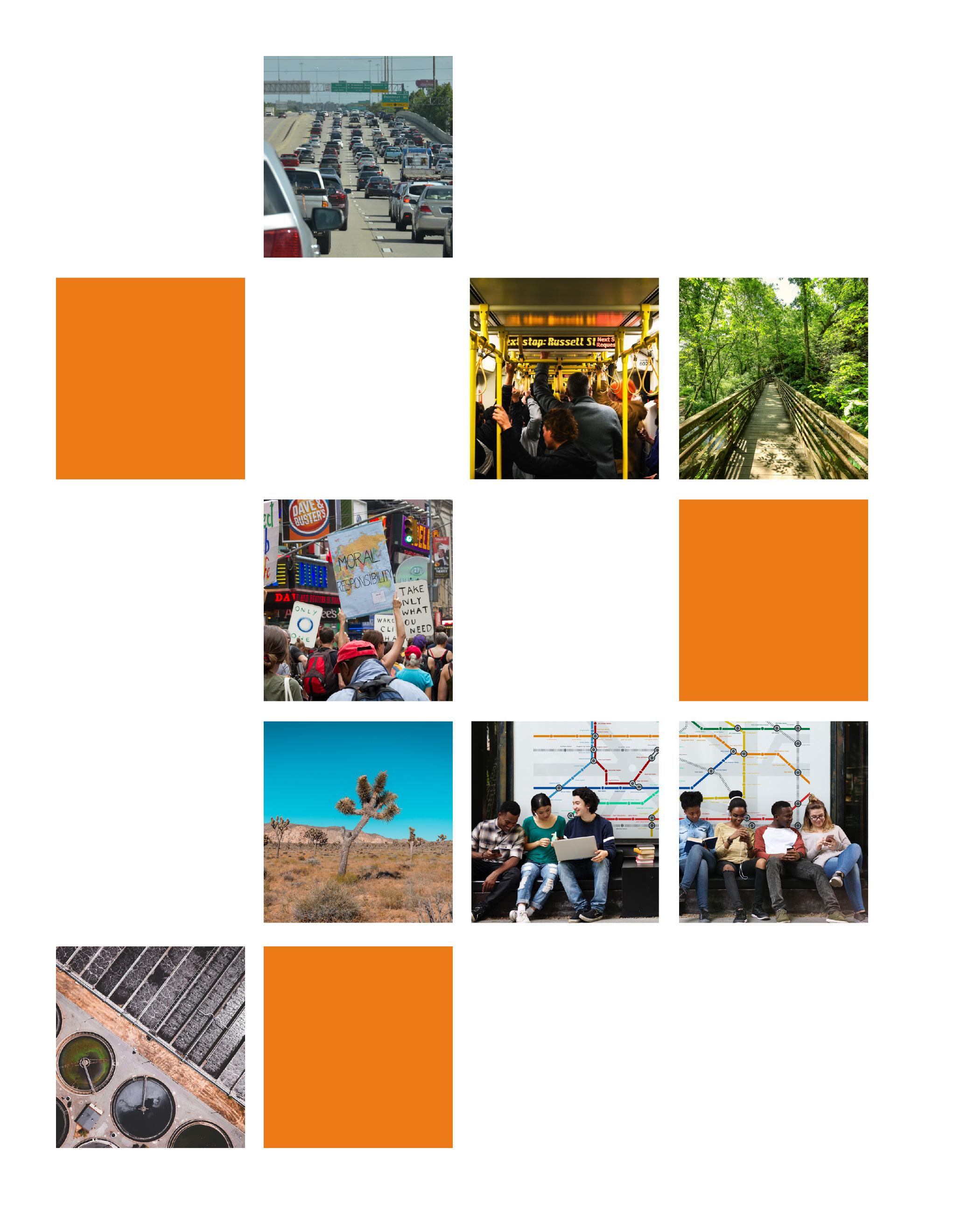



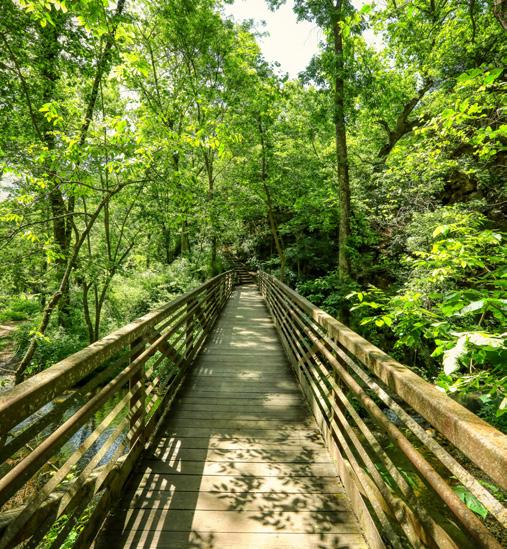
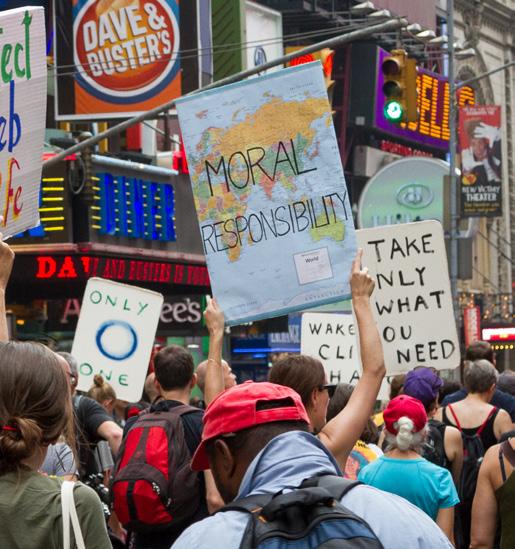






8 | APPENDIX AND NOTES
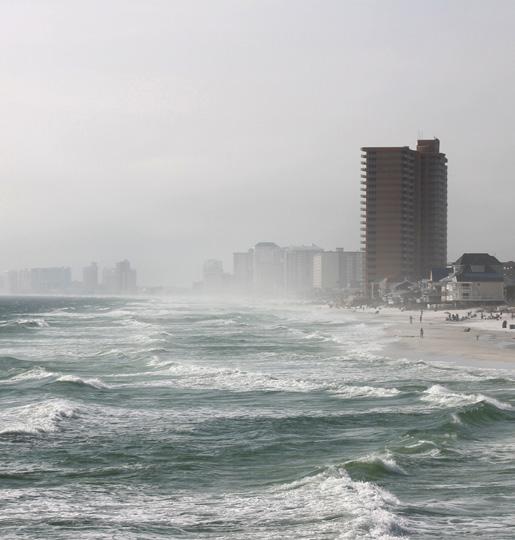
APPENDIX
PERSPECTIVES ON RESILIENCE
The integrated framework for understanding resilience offered in Chapter 4 draws from several academic disciplines and communities of practice—engineering, ecology, the social sciences, and the field of disaster risk reduction. Below, we offer a brief summary of key insights from each. While these disciplines offer necessary perspectives on resilience, none—on their own—are sufficient to address the challenges that now confront our communities. But taken together, they can help inform a holistic, interdisciplinary approach to resilience.
Engineering. Engineering resilience describes the capacity of materials like steel to bend without breaking under force and straighten out when the force is removed.1 This is the simplest conception of resilience, and it is largely synonymous with the dictionary definition of the word: to bounce back. This concept of resilience is useful but limited to preserving the status quo; it does not allow for adaptation and transformation.
Ecology. Resilience, in the ecological domain, has been defined as “the capacity of a system to absorb disturbance and reorganize while undergoing change so as to still retain essentially the same function, structure, identity, and feedbacks.”2 The goal of ecological resilience is to identify and avoid thresholds that will lead to undesirable “regime shifts” in natural systems: the ocean becomes acidic, the grassland becomes a desert.
Ecological resilience thinking is rooted in systems theory, which holds that nothing exists in isolation. While the prevailing Enlightenment worldview reduces systems to their component parts, systems thinkers endeavor to comprehend the integrated whole.3 Resilience thinkers see ecosystems and human society as complex adaptive systems (CAS): they are complex in that they are composed of multiple, interconnected elements; they are adaptive in that they have the capacity to change and self-organize.
While CAS are characteristically unpredictable, they typically move through adaptive cycles of growth, conservation, release, and regeneration. Systems in the growth phase adapt easily to change, but gradually resources are locked into arrangements that are ever more rigid, precipitating collapse. When the system collapses, resources are released, and the cycle begins anew.⁴
The concept of the adaptive cycle is, in effect, a theory of change; it can help identify tipping points or thresholds—moments when transformative change is possible or likely. Resilience thinking has also produced indicators to assess resilience. For example, resilient systems tend to be diverse, redundant, and modular, as described in Chapter 4.
Originally employed to analyze and manage ecosystems, the resilience thinking framework has evolved to include social-ecological systems (SES).⁵ This hybrid framework can guide understanding of the complex, nested systems that comprise human communities. And, in contrast to engineering resilience, which focuses on preserving the status quo, SES resilience embraces the transformational potential of change. Rather than simply surviving a disturbance, a resilient community may respond in creative ways that fundamentally transform the community, creating a
positive regime shift. Indeed, regime shifts in the social realm may be necessary to head off disastrous changes in the biosphere.
Social sciences. Resilience has been investigated across the social sciences, including psychology and sociology. While there is no single definition of social resilience, there is a considerable body of knowledge about the factors that enable individuals and communities to cope, adapt, and transform in response to change and adversity.
Psychologists have found that individual resilience rests on a foundation of social ties and communities that support human development.⁶ Sociologists have examined factors that make some social groups more vulnerable than others, such as structural racism, gender inequality, and other forms of social exclusion.⁷ They have also explored the social construction of disaster—the inequities and failures of governance that turn hazards into catastrophe.⁸ Additionally, this work sheds light on the social policies and practices that bolster resilience.
Other social scientists have called for greater attention to agency—the capacity to make choices and enact them in the world—as a component of resilience.⁹
This conceptualization closely aligns with the capabilities approach elaborated by Amartya Sen and Martha Nussbaum, which formed the basis for the UN’s Human Development Index.10 Sen and Nussbaum found that poverty stems not only from deprivation, but also from a lack of agency and self-determination. The capabilities approach calls for all people to have the means and power to live the lives they want. Essential capabilities include bodily health and integrity, freedom of affiliation, political participation, and control over one’s environment. Others have argued that these capabilities are central to climate adaptation.11
Disaster risk reduction. The field of disaster risk reduction (DRR) focuses on hazards, vulnerability, and resilience. In the DRR framework, disaster risk is often presented as a function of hazard plus vulnerability. In other words, hazards are inevitable; it takes vulnerability for a hazard to become a disaster.12
Vulnerability may be biophysical—for example, resulting from a community’s location on a geologic fault line—and/or it may socially constructed. Building resilience is one way to reduce disaster risk; another is to reduce or prevent vulnerability. DRR is, of necessity, holistic and interdisciplinary: it integrates the study of biophysical hazards and the built environment with attention to the social construction of risk.
At the same time, DRR—like other perspectives on resilience—has its limitations. For example, DRR practice has been criticized for paying insufficient attention to the underlying causes of vulnerability.13 Moreover, DRR is focused on what might be called “known unknowns”—disasters that are unpredictable, perhaps, but not entirely without precedent. As climate change unspools in an interconnected world, the future is not likely to resemble the past. In the 21st century, it is necessary to confront the exponentially more-difficult task of building resilience to “unknown unknowns.”
CHAPTER 4. DEFINING RESILIENCE
1See, for example, Biden-Harris Administration. (2023). National Climate Resilience Framework. national-climate-resilience-framework-2023-final.pdf. See also U.S. Global Change Research Program. (2023). Fifth National Climate Assessment. https://nca2023.globalchange.gov/. This included a chapter on social systems and justice (https://nca2023.globalchange.gov/chapter/20/).
2 U.S. Environmental Protection Agency. (2021, September 2). EPA report shows disproportionate impacts of climate change on socially vulnerable populations in the United States [Press release]. https://www.epa.gov/newsreleases/epa-reportshows-disproportionate-impacts-climate-change-socially-vulnerable
3 IPCC. (2022). Climate change 2022: Impacts, adaptation, and vulnerability. Contribution of Working Group II to the sixth assessment report of the Intergovernmental Panel on Climate Change (Annex II, pp. 2920–2921). Cambridge University Press. https://www.ipcc.ch/report/sixth-assessment-report-workinggroup-ii/
4 Green, K. P. (2009). Climate change: The resilience option. American Enterprise Institute. https://www.aei.org/research-products/report/climate-change-theresilience-option/
5 Human Energy Company. (2021). Climate change resilience: Advancing a lower carbon future. Chevron. https://www.chevron.com/-/media/chevron/sustainability/ documents/2021-climate-change-resilience-report.pdf; ExxonMobil (2024). Resiliency. https://corporate.exxonmobil.com/sustainability-and-reports/advancingclimate-solutions/resiliency
6 Climate Resilience Consulting. (2025). The tasks of now: Toward a new era in climate resilience building. https://www.climateresilienceconsulting.com/climateadaptation-field-status
7 Climate Resilience Consulting. (2025).
8 Chemaly, S. (2024). The resilience myth: New thinking on grit, strength, and growth after trauma. Atria/One Signal Publishers.
9 Lampe (n.d.). The state of resilience: Media, field, and opinion research. Water Hub. https://app-na1.hubspotdocuments.com/documents/46248880/ view/1113895510?accessId=4b5585
10 Telephone interview with Jeremy Hays, February 10, 2025.
11 Lampe (n.d.).
CHAPTER 5. PROGRESS AND PROSPECTS
1United Nations Environment Programme. (2024). Emissions gap report 2024: No more hot air … please! With a massive gap between rhetoric and reality, countries draft new climate commitments. https://doi.org/10.59117/20.500.11822/46404;
IPCC. (2023). Summary for policymakers. In core writing team, H. Lee & J. Romero (Eds.), Climate change 2023: Synthesis report. Contribution of Working Groups I, II and III to the sixth assessment report of the Intergovernmental Panel on Climate Change (pp. 1–34). IPCC. https://doi.org/10.59327/IPCC/AR6-9789291691647.001
2 Brovkin, V., Brook, E., Williams, J. W., et al. (2021). Past abrupt changes, tipping points and cascading impacts in the Earth system. Nature Geoscience, 14, 550–558. https://doi.org/10.1038/s41561-021-00790-5
3 Zhong, R., & Rojanasakul, M. (2024, August 11). How close are the planet’s climate tipping points? The New York Times. https://www.nytimes.com/ interactive/2024/08/11/climate/earth-warming-climate-tipping-points.html
4 Stockholm Resilience Centre. (n.d.). Planetary boundaries. https://www. stockholmresilience.org/research/planetary-boundaries.html
5 NOAA National Centers for Environmental Information (NCEI). (2025). U.S. billion-dollar weather and climate disasters. https://doi.org/10.25921/stkw-7w73
6 Smith, A. B., & Katz, R. W. (2013). US billion-dollar weather and climate disasters: Data sources, trends, accuracy and biases. Nature Hazards, 67, 387–410. https:// doi.org/10.1007/s11069-013-0566-5; Bardan, R. (2025, January 10). Temperatures rising: NASA confirms 2024 warmest year on record [Press release]. NASA. https:// www.nasa.gov/news-release/temperatures-rising-nasa-confirms-2024-warmestyear-on-record/
7 Telephone interview with Jeremy Hays, February 10, 2025.
8 Brennan, M., Brown, D., & Pope, L. (2023, August 8). Recent trends in tropical cyclone fatalities in the United States. The Front Page. https://blog.ametsoc. org/2023/08/08/recent-trends-in-tropical-cyclone-fatalities-in-the-united-states/
9 Gramling, C. (2021, July 13). Hurricanes may not be becoming more frequent, but they’re still more dangerous. Science News. https://www.sciencenews.org/article/ hurricanes-frequency-danger-climate-change-atlantic
10 Osaka, S., & Kaplan, S. (2024, October 1). Before the floods, Asheville was called a “climate haven”: Is anywhere safe? Washington Post. https://www.washingtonpost. com/climate-environment/2024/10/01/asheville-climate-haven-flooding-hurricane/
11 Singh, S., et. al. (2021). How an outbreak became a pandemic: A chronological analysis of crucial junctures and international obligations in the early months of the COVID-19 pandemic. Lancet, 398(10316), 2109–2124. https://doi.org/10.1016/ S0140-6736(21)01897-3
12 Boyle, J. (2024, November 18). Asheville potable water is back, city boil water notice lifted. Asheville Watchdog. https://avlwatchdog.org/asheville-potable-wateris-back-city-boil-water-notice-lifted/
13 Xu, Z., et. al. (2020). Impacts of COVID-19 on global supply chains: Facts and perspectives. IEEE Engineering Management Review, 48(3), 153–166. https://doi. org/10.1109/EMR.2020.3018420
14 Alexander, D., & Pescaroli, G. (2019). What are cascading disasters? UCL Open Environment, 1. https://doi.org/10.14324/111.444/ucloe.000003; Washington Post. (2024).The disaster no major U.S. City is prepared for. https://www.washingtonpost. com/climate-environment/interactive/2024/hurricanes-power-outages-heat-waverisk/?utm_source=alert&utm_medium=email&utm_campaign=wp_news_alert_ revere&location=alert
15 Cummings, M., Donnelly, E., Gregor, K., & Kreps, K. (2019). PostHurricane Maria power restoration: Disproportionate outcomes from power restoration. ArcGIS StoryMaps. https://storymaps.arcgis.com/ stories/038f2aaeb17643edbae10bc42b13f71b
16 Credit Suisse Research Institute (CSRI). (2023). Global Wealth Report 2023. Credit Suisse. https://acrobat.adobe.com/id/urn:aaid:sc:US:6936ad65-c935-4840bc88-d9720817b81d
17 Statistica. (2024, September). Wealth distribution in the United States in the second quarter of 2024. https://www.statista.com/statistics/203961/wealthdistribution-for-the-us/; Schaeffer, K. (2020, February 7). 6 facts about economic inequality in the U.S. Pew Research Center. https://www.pewresearch.org/shortreads/2020/02/07/6-facts-about-economic-inequality-in-the-u-s/
18 Schaeffer (2020, February 7); Perry, A. M., Stephens, H., & Donoghoe, M. (2024, January 9). Black wealth is increasing, but so is the racial wealth gap. Brookings. https://www.brookings.edu/articles/black-wealth-is-increasing-but-so-is-the-racialwealth-gap/
19 U.S. Environmental Protection Agency. (2021, September 2). EPA report shows disproportionate impacts of climate change on socially vulnerable populations in the United States [Press release]. https://www.epa.gov/newsreleases/epa-reportshows-disproportionate-impacts-climate-change-socially-vulnerable
20 U.S. Census Bureau. (2018, March 13). Older people projected to outnumber children for first time in U.S. history [Press release]. https://www.census. gov/newsroom/press-releases/2018/cb18-41-population-projections. html#:~:text=%E2%80%9CBy%202034%20(previously%202035),decade%20for%20 the%20U.S.%20population
21 Arigoni, D. (2023). Climate resilience for an aging nation. Island Press.
22 The White House. (n.d.) Chapter one: Katrina in perspective. https:// georgewbush-whitehouse.archives.gov/reports/katrina-lessons-learned/chapter1. html
23 Committee for a Responsible Federal Budget. (2022, September 7). CBO scores IRA with $238 billion of deficit reduction. The Bottom Line. https://www.crfb.org/ blogs/cbo-scores-ira-238-billion-deficit-reduction
24 What Trump promised oil CEOs as he asked them to steer $1 billion to his campaign. (2024, May 24). Washington Post. https://www.washingtonpost.com/ politics/2024/05/09/trump-oil-industry-campaign-money/
25 Doniger, D. (2025, February 26). Can Trump reverse the climate endangerment finding? Expert Blog, NRDC. https://www.nrdc.org/bio/david-doniger/cantrump-reverse-climate-endangerment-finding; Friedman, L., Brown, C., & Savage, C. (2025, March 4). Climate groups were counting on $20 billion. Trump won’t let them access it. The New York Times. https://www.nytimes.com/2025/03/04/ climate/green-bank-climate-trump-freeze.html; Storrow, B., & Chemnick, J. (2025, February 2). How Trump gutted climate policy in 30 days. POLITICO. https:// www.politico.com/news/2025/02/21/trump-gutted-climate-policy-across-federalgovernment-00204998
26 Guynn, J. (2025, March 4). DEI explained: What is DEI and why is it so divisive? What you need to know. USA Today. https://www.usatoday.com/story/ money/2025/03/04/trump-dei-backlash-explained/81170427007/
27 Blanchard, J. (2025, January 31). Don’t let Trump usurp the “power of the purse.” The Progressive. https://progressive.org/op-eds/dont-let-trump-usurp-the-powerof-the-purse-blanchard-20250131/; Huppke, R. (2025, March 18). Trump defies judge on deportations. We’re on the cusp of a constitutional crisis. Opinion. USA Today. https://www.usatoday.com/story/opinion/columnist/2025/03/18/trumpdeportation-venezuela-el-salvador-defy-judge/82498769007/
28 Lazar, N. C., & Wallace, J. (2025). Resisting the authoritarian temptation. Journal of Democracy, 36(1), 135–150. https://dx.doi.org/10.1353/jod.2025.a947889
29 Fussell, C. (2015, May 27). Why Special Ops stopped relying so much on topdown leadership. Harvard Business Review. https://hbr.org/2015/05/why-specialops-stopped-relying-so-much-on-top-down-leadership; Werfelman, L. (2011, June 13). Assert yourself. Flight Safety Foundation. https://flightsafety.org/asw-article/ assert-yourself/
30 The Editorial Board. (2025, February 28). The MAGA war on speech. The New York Times. https://www.nytimes.com/2025/02/28/opinion/free-speech-trumpmaga.html?smid=nytcore-ios-share&referringSource=articleShare
31 Mingle, J. (2025, March 17). DOGE is making it harder to track extreme weather. What could go wrong? Opinion. The New York Times. https://www.nytimes. com/2025/03/17/opinion/weather-service-doge-cuts.html
32 Marr, C., Jacoby, S., and Fenton, G. (updated 2024, June 13). The 2017 Trump tax law was skewed to the rich, expensive, and failed to deliver on its promises. A 2025 course correction is needed. Center on Budget and Policy Priorities. https://www. cbpp.org/research/federal-tax/the-2017-trump-tax-law-was-skewed-to-the-richexpensive-and-failed-to-deliver
33 Jansen, B., Garrison, J., & Beggin, R. (2025, March 29, updated April 14). How Elon Musk, the world’s richest man, has dominated Trump’s agenda. USA Today. https://www.usatoday.com/story/news/politics/2025/03/09/elon-musk-dogedonald-trump-spending-cuts/81748417007/
34 Telephone interview with Ann Kinzig January 6, 2025. See also Kish Bar-On, K., Dimant, E., Lelkes, Y., & Rand, D. G. (2024). Unraveling polarization: Insights into individual and collective dynamics. PNAS Nexus, 3(10), 426. https://doi. org/10.1093/pnasnexus/pgae426
35 Kim, S.R and Ibssa, L. (2023, November 13). Trump compares political opponents to ‘vermin’ who he will ‘root out,’ alarming historians. ABC News. https://abcnews. go.com/Politics/trump-compares-political-opponents-vermin-root-alarminghistorians/story?id=104847748; Cooper, J. (2024, October 26). Who does Trump see as ‘enemies from within’? Associated Press News. https://apnews.com/article/ donald-trump-enemies-from-within-5c4a34776469a55e71d3ba4d4e68cf62
CHAPTER 5.1. CLIMATE RESILIENCE
1 Committee for a Responsible Federal Budget (2022, September 7).
2 U.S. Department of the Treasury. (2025, January 15). Remarks by Secretary of the Treasury Janet L. Yellen reflecting on the Biden-Harris administration’s economic record [Press release]. https://home.treasury.gov/news/press-releases/jy2786#_ ftnref27
3 See: CDBG-MIT: Community Development Block Grant Mitigation FundsHUD Exchange; https://www.fema.gov/grants/mitigation/learn/building-resilientinfrastructure-communities
4 Federal Emergency Management Agency. (Last updated April 15, 2025). Safeguarding Tomorrow Revolving Loan Fund Program. https://www.fema.gov/ grants/mitigation/learn/storm-rlf
5 [Link removed from FEMA website.]
6 Kousky, C., French, K., Martín, C., & Donoghoe, M. (2023, September 13). As disasters become more costly, the US needs a better way to distribute the burden. Brookings Institution. https://www.brookings.edu/articles/as-disasters-becomemore-costly-the-us-needs-a-better-way-to-distribute-the-burden/
7 Flavelle, C. (2023, November 1). As climate shocks grow, lawmakers investigate insurers fleeing risky areas. The New York Times. https://www.nytimes. com/2023/11/01/climate/climate-insurance-disasters-senate.html
8 Strengthen Alabama Homes. (n.d.). https://www.strengthenalabamahomes.com/
9 Mazur, L. (2024, March 9). How climate resilience can curb a crisis in homeowners’ insurance. U.S. News & World Report. https://www.usnews.com/ news/health-news/articles/2024-03-09/climate-resilience-can-curb-a-crisis-inhomeowners-insurance
10 Telephone interview with Cate Mingoya-LaFortune January 7, 2025.
11 Miami-Dade County. (n.d.). Strengthening resilience in Miami-Dade County. Office of Environmental Risk and Resilience. https://www.miamidade.gov/global/ economy/resilience/home.page
12 Portland Clean Energy Fund. (n.d.). PCEF program dashboard. https://www. portland.gov/bps/cleanenergy/climate-investment-plan/dashboard
13 Council on Environmental Quality. (2021, July 21). What they are saying: Biden administration lays out path to reach Justice40 goal, earns praise from
administration officials, environmental justice leaders, advocates, and congressional leaders [Press Release]. The White House. https://bidenwhitehouse.archives.gov/ ceq/news-updates/2021/07/21/what-they-are-saying-biden-administration-laysout-path-to-reach-justice40-goal-earns-praise-from-administration-officialsenvironmental-justice-leaders-advocates-and-congressional-leaders/
14 Telephone interview with Cate Mingoya-LaFortune January 7, 2025.
15 Telephone interview with Lara Hansen November 4, 2024.
16 National Adaptation Forum. (n.d.). About the Forum. https:// nationaladaptationforum.org/about/
17 National Association of Climate Resilience Planners. (n.d.). https://www.nacrp. org/
18 Telephone interview with Susanne Moser January 6, 2025.
19 The White House. (2023, September). National Climate Resilience Framework. https://bidenwhitehouse.archives.gov/wp-content/uploads/2023/09/NationalClimate-Resilience-Framework-FINAL.pdf
20 Wasley, E., Dahl, T. A., Simpson, C. F., Fischer, L. W., Helgeson, J. F., Kenney, M. A., Parris, A., Siders, A. R., Tate, E., & Ulibarri, N. (2023). Ch. 31. Adaptation. In A. R. Crimmins, C. W. Avery, D. R. Easterling, K. E. Kunkel, B. C. Stewart, & T. K. Maycock (Eds.). Fifth National Climate Assessment. U.S. Global Change Research Program. https://doi.org/10.7930/NCA5.2023.CH31
21 Telephone interview with Lara Hansen November 4, 2024.
22 Telephone interview with Lara Hansen November 4, 2024.
23 Telephone interview with Lara Hansen November 4, 2024.
24 Metrics: see, for example, Welcome to Resilience Metrics! (n.d.). Resilience Metrics. https://resiliencemetrics.org/; Telephone interview with Susanne Moser January 6, 2025.
25 Telephone interview with Lara Hansen November 4, 2024; A morecomprehensive view of the adaptation field can be found in Moser, S., Coffee, J., & Macnee, R. (2024). The tasks of now: Toward a new era in climate resilience building. The David and Lucile Packard Foundation. https://acrobat.adobe.com/id/ urn:aaid:sc:US:0f71a9fe-31c2-4bf0-a83b-2b3d45b5a403
26 Telephone interview with Susanne Moser January 6, 2025.
27 United Nations Environment Programme (2024); Rapier, R. (2024). Why the U.S. leads the world in reducing carbon emissions. Forbes. https://www.forbes. com/sites/rrapier/2024/02/04/why-the-us-leads-the-world-in-reducing-carbonemissions/
28 IPCC (2023).
29 IEA (2025), Global Energy Review 2025. https://www.iea.org/reports/globalenergy-review-2025
30 Slaney, J. (2025, February 14). Trump administration’s plan intentionally eliminates ability to prepare for next flood. Environmental Defense Fund. https:// www.edf.org/media/trump-administrations-plan-intentionally-eliminates-abilityprepare-next-flood
31 Olano, M. V. (2024, April 12). Chart: Which US states generate the most solar and wind energy? Canary Media. https://www.canarymedia.com/articles/clean-energy/ chart-which-us-states-generate-the-most-solar-and-wind-energy
32 Turner, Amy. (2020, July 29). Municipal natural gas bans: Round 2 (the evolution of state preemption law). Climate Law, Sabin Center for Climate Change Law. https://blogs.law.columbia.edu/climatechange/2020/07/29/municipal-natural-gasbans-round-2-the-evolution-of-state-preemption-law/
33 Telephone interview with Lara Hansen November 4, 2024.
34 Telephone interview with Jeremy Hays February 10, 2025.
35 U.S. Environmental Protection Agency. (Last updated 2025, February 10). Greenhouse Gas Reduction Fund. https://www.epa.gov/greenhouse-gas-reductionfund
36 Telephone interview with Shamar Bibbins January 22, 2025.
37 McDowell, S. (n.d.). To defend, retreat or adapt? Design responses to the excess and disappearance of water. Association of Collegiate Schools of Architecture. https://www.acsa-arch.org/proceedings/Annual%20Meeting%20Proceedings/ ACSA.AM.104/ACSA.AM.104.85.pdf
38 Rich, N. (2024, November 30). New Orleans’ striking advantage in the age of climate change. Opinion. The New York Times. https://www. nytimes.com/2024/11/30/opinion/new-orleans-hurricanes-climate-change. html?smid=nytcore-ios-share&referringSource=articleShare
39 Telephone interview with Stephen Flynn December 23, 2024.
40 Federal Emergency Management Agency. (2020, November). Protecting communities and saving money: The case for adopting building codes. https://www. fema.gov/sites/default/files/2020-11/fema_building-codes-save_brochure.pdf
41 Mazur (2024, March 9).
42 National Institute of Building Sciences. (2019). Mitigation saves: Federal grants provide a $6 benefit for each $1 invested. https://www.nibs.org/files/pdfs/ms_v3_ federalgrants.pdf
43 Telephone interview with Ayana Elizabeth Johnson March 3, 2025.
44 Telephone interview with Susanne Moser January 6, 2025.
45 Telephone interview with Lois DeBacker January 23, 2025.
46 Telephone interview with Susanne Moser January 6, 2025.
47 Telephone interview with Lois DeBacker January 23, 2025.
48 Telephone interview with Lara Hansen November 4, 2024; Pacala, S., & Socolow, R. (2004). Stabilization wedges: Solving the climate problem for the next 50 years with current technologies. Science, 305, 968–972. https://doi.org/10.1126/ science.1100103
CHAPTER 5.2. EQUITY AND CLIMATE
1 Telephone interview with Shalanda Baker January 21, 2025.
2 American Cities Climate Challenge. (n.d.). Justice40 and equity considerations. https://cityrenewables.org/funding-guidance/understanding-available-funding/ justice40-and-equity-considerations/
3 Telephone interview with Jeremy Hays February 10, 2025.
4 Fang, C. C. (2024). Who are climate activists and what do they do? A study of diversity in the U.S. climate movement. Journal of Environmental Studies and Sciences, 14, 594–606. https://doi.org/10.1007/s13412-024-00911-7
5 Green 2.0. (2024). 2024 transparency report: Turning tides in the sector. https:// greentwopointzero.org/transparency-cards/green-2-0-2024-transparency-report/
6 Friedman, L. (2025, March 11, updated March 13). E.P.A. plans to close all environmental justice offices. The New York Times. https://www.nytimes. com/2025/03/11/climate/epa-closure-environmental-justice-offices.html?smid=urlshare; Tigue, K. (2025, February 14). After Trump administration closes DOJ’s Office of Environmental Justice, advocates worry about future enforcement. Inside Climate News. https://insideclimatenews.org/news/14022025/trumpadministration-closes-doj-environmental-justice-office/; Hassanein, N. (2025, April 14). Trump has cancelled environmental justice grants. Here’s what communities are losing. Stateline. https://stateline.org/2025/04/14/trump-has-canceledenvironmental-justice-grants-heres-what-communities-are-losing/; Climate Justice Alliance. (2025, February 13). EPA cancels Climate Justice Alliance grant [Press release]. https://climatejusticealliance.org/epa-cancels-climate-justice-alliancegrant/
7 Telephone interview with Jacqueline Patterson March 4, 2025.
8 Totenberg, N. (2023, June 29). Supreme Court guts affirmative action, effectively ending race-conscious admissions. NPR. https://www.npr. org/2023/06/29/1181138066/affirmative-action-supreme-court-decision
9 Erdenesanaa, D. (2023, July 20). Signature Biden program won’t fix racial gap in air quality, study suggests. The New York Times. https://www.nytimes. com/2023/07/20/climate/justice40-pollution-environmental-justice.html?smid=urlshare; American Lung Association. (2023, November 2). Disparities in the impact of air pollution. https://www.lung.org/clean-air/outdoors/who-is-at-risk/disparities
10 Patterson, J., Schaefer, A., & Sanchez, A. S. (2023, October 30). What the Supreme Court decision on affirmative action means for climate equity policy. Nonprofit Quarterly. https://nonprofitquarterly.org/what-the-supreme-court-decision-onaffirmative-action-means-for-climate-equity-policy/
11 Telephone interview with Lois DeBacker January 23, 2025.
12 Telephone interview with Shamar Bibbins January 22, 2025.
13 Telephone interview with Shamar Bibbins January 22, 2025.
14 Telephone interview with Jeremy Hays February 10, 2025.
15 Telephone interview with Lois DeBacker January 23, 2025.
16 McGee, H. (2021). The sum of us: What racism costs everyone and how we can prosper together. One World.
17 McGhee, H. C. (2021, February 13). The way out of America’s zero-sum thinking on race and wealth [Opinion]. The New York Times. https://www.nytimes. com/2021/02/13/opinion/race-economy-inequality-civil-rights.html
18 Telephone interview with Nathaniel Smith January 7, 2025.
19 Green 2.0 (2024).
CHAPTER 5.3. ENERGY
1 McKinsey & Company. (2022, October 24). The Inflation Reduction Act: Here’s what’s in it. https://www.mckinsey.com/industries/public-sector/our-insights/theinflation-reduction-act-heres-whats-in-it
2 Telephone interview with Seth Mullendore January 30, 2025.
3 Blatchford, L., & de Souza Briggs, X. (2025, February 10). Getting to effective government: Five lessons the DOGE should know about implementing innovative federal investments in communities. Brookings Institution. https://www.brookings. edu/articles/getting-to-effective-government/
4 Telephone interview with Seth Mullendore January 30, 2025.
5 Goldsmith, I., Whittemore, R., & Carroll, K. (2025, January 17). “Direct pay” tax credits bring clean energy and so much more to US communities. World Resources Institute. https://www.wri.org/insights/direct-pay-clean-energy-tax-credits-usbenefits
6 Kresge Foundation. (2024, February 13). Decarbonizing community facilities: Case studies. https://kresge.org/resource/decarbonizing-community-facilities-solarcase-studies/
7 Internal Revenue Service. (2025, February 11). Clean electricity low-income communities bonus credit amount program. https://www.irs.gov/creditsdeductions/clean-electricity-low-income-communities-bonus-credit-amount-
program; Adamsson, A. (2023, February 27). Investment tax credit fact sheets: Bonus credit program. Clean Energy Group. https://www.cleanegroup.org/ publication/investment-tax-credit-fact-sheets-bonus-credit-program/
8 Lee, T. (2024, September 4). Analysis of the first year of the Low-Income Communities Bonus Credit Program: Building an inclusive and affordable clean energy economy. U.S. Department of the Treasury. https://home.treasury.gov/news/ featured-stories/analysis-of-the-first-year-of-the-low-income-communities-bonuscredit-program-building-an-inclusive-and-affordable-clean-energy-economy
9 U.S. Department of the Treasury (2025, January 15).
10 Clean Economy Works. (2024, August 14). IRA two-year review. E2. https:// e2.org/reports/clean-economy-works-two-year-review-2024/
11 Olano (2024, April 12).
12 Warren, S. (2022, October 5). Ceremonial ribbon cutting marks the start of innovative geothermal research project. Inside OU. University of Oklahoma. https:// www.ou.edu/insideou/articles/2022/october/ceremonial-ribbon-cutting-marks-thestart-of-innovative-geothermal-research-project
13 Telephone interview with Seth Mullendore January 30, 2025.
14 Roser, M. (2020). Why did renewables become so cheap so fast? Our World in Data. https://ourworldindata.org/cheap-renewables-growth
15 Roser (2020).
16 U.S. Energy Information Administration. (2021, January 11). Renewables account for most new U.S. electricity generating capacity in 2021. Today in Energy. https:// www.eia.gov/todayinenergy/detail.php?id=46416
17 Lempriere, M. (2024, August 5). Wind and solar are “fastest-growing electricity sources in history.” Carbon Brief. https://www.carbonbrief.org/wind-and-solar-arefastest-growing-electricity-sources-in-history/
18 Our World in Data. (n.d.). Change in per capita CO₂ emissions and GDP, United States. https://ourworldindata.org/grapher/co2-emissions-and-gdp-percapita?time=2000..latest&country=~USA&itid=lk_inline_enhanced-template
19 Collier, R. (2021, November 2). Standing in line: How congested interconnection queues are slowing renewable build-out. Market Insights, LevelTen Energy. https:// www.leveltenenergy.com/post/interconnection-slowdown
20 Jenkins, J. D., Farbes, J., Jones, R., Patankar, N., & Schivley, G. (2022, September). Electricity transmission is key to unlock the full potential of the Inflation Reduction Act. REPEAT Project. https://doi.org/10.5281/zenodo.7106176
21 Meyer, R. (2023, May 24). What is permitting reform? Here’s a cheat sheet. Sustainable Energy and Environment Coalition (SEEC). https://seec.house.gov/ media/in-the-news/what-permitting-reform-heres-cheat-sheet
22 Johnson, L. (2025, January 29). Trump pauses renewable projects leasing on federal lands, waters. ESG Dive. https://www.esgdive.com/news/trumppauses-renewable-projects-leasing-on-federal-lands-waters-interior-executiveorder/738647/
23 Gelles, D. (2025, March 17). The Republicans pushing Trump to save Biden’s clean energy tax credits. The New York Times. https://www.nytimes.com/2025/03/17/ climate/biden-clean-energy-tax-credits-trump.html
24 Skibell, A. (2025, March 26). Trump’s clean energy policy: Pick favorites. POLITICO. https://www.politico.com/newsletters/power-switch/2025/03/26/ trumps-clean-energy-policy-pick-favorites-00251210
25 Telephone interview with Seth Mullendore January 30, 2025.
26 Telephone interview with Shalanda Baker January 21, 2025.
27 Brown, A. (2022, January 6). Natural gas bans are new front in effort to curb emissions. Stateline. https://stateline.org/2022/01/06/natural-gas-bans-are-newfront-in-effort-to-curb-emissions/
28 Miller, A. (2022, June 28). Natural gas used in homes contains hazardous air pollutants. Center for Climate, Health, and the Global Environment, Harvard. https://hsph.harvard.edu/climate-health-c-change/news/natural-gas-used-inhomes-contains-hazardous-air-pollutants/
29 Olano, M. V. (2023, February 10). Chart: Americans bought more heat pumps than gas furnaces last year. Canary Media. https://www.canarymedia.com/articles/ heat-pumps/chart-americans-bought-more-heat-pumps-than-gas-furnaces-lastyear
30 Rewiring America. (n.d.). Your guide to the Inflation Reduction Act. https://www. rewiringamerica.org/research/ira-guide
31 U.S. Environmental Protection Agency. (2025, March 19). Power plants and neighboring communities. https://www.epa.gov/power-sector/power-plants-andneighboring-communities
32 Telephone interview with Anne Evens March 11, 2025.
33 Collectrify. (n.d.). A frontline-led energy fund. https://www.collectrify.org/
34American Clean Power Association. (2025, March). U.S. national power demand study. https://cleanpower.org/resources/us-national-power-demand-study/
35 Halper, E. (2024, March 7). Amid record high energy demand, America is running out of power. Washington Post. https://www.washingtonpost.com/ business/2024/03/07/ai-data-centers-power/
36 Halper, E. (2024, October 12). A utility promised to stop burning coal. Then Google and Meta came to town. Washington Post. https://www.washingtonpost. com/business/2024/10/08/google-meta-omaha-data-centers/
37 Marshall, C. (2025, January 29). “Game changer”? What “DeepSeek” AI means for electricity. E&E News. https://www.eenews.net/articles/game-changer-whatdeepseek-ai-means-for-electricity/
38 Telephone interview with Seth Mullendore January 30, 2025.
39 U.S. Energy Information Administration. (n.d.). Electric power monthly. https:// www.eia.gov/electricity/monthly/epm_table_grapher.php?t=table_5_03
40 U.S. Energy Information Administration. (2022, April 11). In 2020, 27% of U.S. households had difficulty meeting their energy needs. Today in Energy. https:// www.eia.gov/todayinenergy/detail.php?id=51979
41 Arigoni, D. (2025, April 25) How we might reduce risks for older adults in a changing climate. Generations. https://generations.asaging.org/reducing-eldersrisks-changing-climate
42 Keeping the lights on in our neighborhoods during power outages. (2023, November 8). Grid Deployment Office, U.S. Department of Energy. https://www. energy.gov/gdo/articles/keeping-lights-our-neighborhoods-during-power-outages
43 Roberts, D. (2024, September 11). This new organization wants to remake PUCs for the energy transition. Volts. https://www.volts.wtf/p/this-new-organizationwants-to-remake
44 Telephone interview with Johanna Partin February 24, 2025.
45 Telephone interview with Seth Mullendore January 30, 2025.
46 Coltura. (n.d.). Do Republicans have more to gain from EVs? https://coltura.org/ do-republicans-have-more-to-gain-from-evs/
47 Telephone interview with Stephen Flynn December 23, 2024.
48 Plumer, B. (2023, August 28). There’s a vast source of clean energy beneath our feet. And a race to tap it. The New York Times. https://www.nytimes. com/2023/08/28/climate/geothermal-energy-projects.html?smid=url-share
49 Buzzerd, W. (2024, April 17). Geothermal heating warms up in Carbondale. Sopris Sun. https://soprissun.com/geothermal-heating-warms-up-in-carbondale/
50 McDermott, J. (2025, January 23). With Trump pivot back to pro-oil and gas policies, one renewable energy finds favor. AP. https://apnews.com/article/trumprenewable-wind-solar-geothermal-434334a2e312583ddd20a201afc8150c
51 Telephone interview with Anne Evens March 11, 2025.
52 Koch, W., & Doughty, K. (n.d.). Energy efficiency: The heart of a clean energy future. What Is Energy Efficiency, ACEEE. https://www.aceee.org/what-is-energyefficiency
53 American Council for an Energy-Efficient Economy (ACEEE). (2019, September 17). Energy efficiency can slash emissions and get US halfway to climate goals [Press Release]. https://www.aceee.org/press/2019/09/energy-efficiency-can-slash
54 Telephone interview with Denise Fairchild January 15, 2025; Ross. (2023, July 12). The Jevons paradox: When efficiency leads to increased consumption. Green Choices. https://www.greenchoices.org/news/blog-posts/the-jevons-paradox-whenefficiency-leads-to-increased-consumption
55 Telephone interview with Stephen Flynn December 23, 2024.
56 Fairchild, D., & Weinrub, A. (2017). Energy democracy: Advancing equity in clean energy solutions. Island Press.
57 Telephone interview with Shalanda Baker January 21, 2025.
CHAPTER 5.4. CLIMATE AND HEALTH
1 Romanello, M. (2021, October 30). The 2021 report of the Lancet Countdown on health and climate change: Code red for a healthy future. Lancet, 398(10311), 1619–1662. https://doi.org/10.1016/S0140-6736(21)01787-6
2 Mazur, L. (2020, August 26). Climate change: The other health crisis. U.S. News & World Report. https://www.usnews.com/news/healthiest-communities/ articles/2020-08-26/the-other-crisis-facing-our-health-care-system-climate-change
3 Lelieveld, J., et al. (2019). Effects of fossil fuel and total anthropogenic emission removal on public health and climate. Proceedings of the National Academy of Sciences of the United States of America, 116(15), 7192–7197. https://doi. org/10.1073/pnas.1819989116
4 Vohra, K., et al. (2021). Global mortality from outdoor fine particle pollution generated by fossil fuel combustion: Results from GEOS-Chem. Environmental Research, 195, 110754. https://doi.org/10.1016/j.envres.2021.110754
5 Telephone interview with Linda Rudolph December 16, 2024.
6 Executive Office of the President. (2021, January 27). Tackling the climate crisis at home and abroad. Federal Register. https://www.federalregister.gov/ documents/2021/02/01/2021-02177/tackling-the-climate-crisis-at-home-andabroad
7 Lawton, B. (n.d.). Law and policy considerations for workforce protections from extreme heat. Network for Public Health Law. https://www.networkforphl.org/ wp-content/uploads/2024/08/Law-and-Policy-Considerations-for-WorkforceProtections-from-Extreme-Heat-1-1.pdf
8 Shindell, D., Zhang, Y., Scott, M., Ru, M., Stark, K., & Ebi, K. L. (2020, April 1). The effects of heat exposure on human mortality throughout the United States. Geohealth, 4(4), e2019GH000234. https://doi.org/10.1029/2019GH000234
9 NOAA, National Weather Service. (n.d.). Weather related fatality and injury statistics. https://www.weather.gov/hazstat/
10 Seniors at risk: Heat and climate change. (2020, June 24). Climate Matters. https:// www.climatecentral.org/climate-matters/seniors-at-risk-heat-and-climate-change
11 Telephone interview with Cheryl Holder December 23, 2024.
12 Kristof, N. (2024, September 14). The climate peril we overlook [Opinion]. The New York Times. https://www.nytimes.com/2024/09/14/opinion/climate-changerecord-hot-summer.html?smid=url-share
13 Copernicus. (2025, March 14). OBSERVER: Copernicus Climate Change Service tracks record atmospheric moisture and sea surface temperatures in 2024. https:// www.copernicus.eu/en/news/news/observer-copernicus-climate-change-servicetracks-record-atmospheric-moisture-and-sea
14 Heywood, A. L. (2023, February 6). 11 conditions that disproportionately affect Black people. Healthline. https://www.healthline.com/health/health-disparities-inthe-black-community
15 Badger, E. (2017, August 24). How redlining’s racist effects lasted for decades. The New York Times. https://www.nytimes.com/2017/08/24/upshot/how-redliningsracist-effects-lasted-for-decades.html
16 Florida, R. (2019, March 19). The inequality of America’s parks and green space. Bloomberg. https://www.bloomberg.com/news/articles/2019-03-19/accessto-green-space-varies-by-class-race-in-the-u-s; Hoffman, J. S., Shandas, V., & Pendleton, N. (2020). The effects of historical housing policies on resident exposure to intra-urban heat: A study of 108 US urban areas. Climate, 8(1), 12. https://doi. org/10.3390/cli8010012; Katz, L. (2021, March 14, updated June 23). A racist past, a flooded future: Formerly redlined areas have $107 billion worth of homes facing high flood risk—25% more than non-redlined areas. Redfin. https://www.redfin. com/news/redlining-flood-risk
17 Vaidyanathan A, Malilay J, Schramm P, Saha S. (2020). Heat-Related Deaths — United States, 2004–2018. MMWR Morbidity and Mortality Weekly Report 2020;69:729–734. DOI: http://dx.doi.org/10.15585/mmwr.mm6924a1
18 U.S. Census Bureau. (2018, March 13). Older people projected to outnumber children for first time in U.S. history [Press release]. https://www.census. gov/newsroom/press-releases/2018/cb18-41-population-projections. html#:~:text=%E2%80%9CBy%202034%20(previously%202035),decade%20for%20 the%20U.S.%20population
19 Arigoni, D. (2023). Climate resilience for an aging nation. Island Press.; Seniors at risk: Heat and climate change. (2020, June 24). Climate Matters. https://www. climatecentral.org/climate-matters/seniors-at-risk-heat-and-climate-change
20 Arigoni, D. (2023, August 11). We’re not ready for rising temperatures in a rapidly aging nation. The Progressive. https://progressive.org/op-eds/were-not-readytemperatures-aging-nation-arigoni-230811/
21 Mazur, L. (2023, July 24). Opinion: Finding climate solutions in communities instead of labs. Environmental Health News. https://www.ehn.org/extreme-heatsolutions
22 Climate Change, Health & Equity (CCHE). (n.d.) The Kresge Foundation. https:// kresge.org/initiative/climate-change-health-and-equity-cche/
23 Miami area’s chief heat officer discusses her first-of-its-kind job. (2022, July 31). All Things Considered, NPR. https://www.npr.org/2022/07/31/1114796487/miamiareas-chief-heat-officer-discusses-her-first-of-its-kind-job
24 Visram, T. (2022, October 7). Meet the 7 chief heat officers who are making their cities more resilient. Fast Company. https://www.fastcompany.com/90793483/meetthe-7-chief-heat-officers-who-are-making-their-cities-more-resilient
25 Cummings, et al. (2019).
26 Oakford, S., Bellware, K., & Foster-Frau, S. (2024, November 7). The decisions that cost some lives and saved others during Helene’s wrath. Washington Post. https://www.washingtonpost.com/nation/2024/11/27/hurricane-helene-erwintennessee-impact-plastics/
27 Surging weather-related power outages. (2022, September 14). Climate Matters. https://www.climatecentral.org/climate-matters/surging-weather-related-poweroutages
28 Health Care Without Harm. (n.d.). Mitigation. https://us.noharm.org/mitigation
29 Karliner, J., Slotterback, S., Boyd, R., Ashby, B., & Steele, K. (2019, September). Health care’s climate footprint: How the health sector contributes to the global climate crisis and opportunities for action. Health Care Without Harm and Arup. https://global.noharm.org/sites/default/files/documents-files/5961/ HealthCaresClimateFootprint_092319.pdf
30 Telephone interview with Linda Rudolph December 16, 2024.
31 Telephone interview with Cheryl Holder December 23, 2024.
32 Telephone interview with Cheryl Holder December 23, 2024; Rivas, A. (2024, August 20). The next public health threat: Oropouche virus. The Invading Sea. https://www.theinvadingsea.com/2024/08/20/oropouche-virus-south-floridamosquitoes-midges-diseases-latin-america-climate-change/
33 Brindley, E. (2025, April 3). As Texas measles outbreak grows, some Republican leaders remain silent on vaccination. The Dallas Morning News. https://www. msn.com/en-us/health/other/as-texas-measles-outbreak-grows-some-republicanleaders-remain-silent-on-vaccination/ar-AA1CdTIH?ocid=BingNewsSerp
34 Telephone interview with Cheryl Holder December 23, 2024.
35 Sherer, J., Cohn, E., & Ahdoot, R. (2025, March 6). Updated EPI tracker shows more states obstructing progress on workers’ rights. Working Economics Blog, Economic Policy Institute. https://www.epi.org/blog/updated-epi-preemptiontracker/
36 Telephone interview with Danielle Arigoni December 20, 2024.
37 Telephone interview with Cate Mingoya-LaFortune January 7, 2025.
38 Vant-Hull, B., Ramamurthy, P., Havlik, B., Jusino, C., Corbin-Mark, C., Schuerman, M., Keefe, J., Drapkin, J. K., & Glenn, A. A. (2018). The Harlem Heat Project: A unique media–community collaboration to study indoor heat waves. Bulletin of the American Meteorological Society, 99(12), 2491–2506. https:// doi.org/10.1175/BAMS-D-16-0280.1
39 Mazur (2023, July 24).
40 Sriraman, S. (2024, July 2). New law protects Virginians from utility shutoffs during extreme weather. WRIC ABC 8News. https://www.wric.com/news/virginianews/new-law-protects-virginians-from-utility-shutoffs-during-extreme-weather/
41 Holder, H. (2025, February 11). Protect Floridians from deadly utility shutoffs. The Invading Sea. https://www.theinvadingsea.com/2025/02/11/utility-shutoffsextreme-heat-energy-bills-climate-change-heatstroke-sb-330-florida-legislature/
42 Telephone interview with Danielle Arigoni December 20, 2024.
43 Telephone interview with Cheryl Holder December 23, 2024.
44 Telephone interview with Danielle Arigoni December 20, 2024.
45 Healthcare Workforce Coalition. (n.d.) Gallup Poll: Healthcare Professions Most Trusted in U.S. https://healthcareworkforce.org/news/gallup-poll-healthcareprofessions-most-trusted-in-u-s/
46 Huffling, K. (2024, June 17). Op-ed: In a warming world, nurses heal people and the planet. The Daily Climate. https://www.dailyclimate.org/climate-change-andnursing-2668535447.html
47 Climate and Health Equity Fellowship (CHEF). (n.d.). We train doctors underrepresented in medicine to become leaders in advancing climate and health education, advocacy, and policy solutions. Medical Society Consortium on Climate and Health. https://medsocietiesforclimatehealth.org/climate-and-health-equityfellowship-chef/
48 See, for example, Crawford, G. (2023, May. 30). Guest opinion: Alabama should get on the (electric) school bus. Advance Local Media. https://www.al.com/ opinion/2023/05/guest-opinion-alabama-should-get-on-the-electric-school-bus. html
49 Interview with Carmen Cavezza September 19, 2024.
50 Climate Change, Health, and Equity (CCHE). (2025, January). Initiative final evaluation report 2018-2024. Executive summary. Kresge Foundation. https://kresge.org/wp-content/uploads/CCHE_EvaluationReport_ExecSum_ FINAL_1-30-25.pdf
51 Biggio, R., Cohen, G., & Ramiah, K. (2025, March 3). Essential hospitals can access funds for climate readiness — but they need to act now. Medium, Island Press. https://islandpress.medium.com/essential-hospitals-can-access-funds-forclimate-readiness-but-they-need-to-act-now-48a45f026129
52 Affordable energy for a community lifeline. (n.d.). Kresge Case Study: San Fernando Community Health Center. https://kresge.org/wp-content/uploads/20243-28-SFHC-case-study-Kresge.pdf
53 Keane, P. (2020, September 19). How the oil industry made us doubt climate change. BBC. https://www.bbc.com/news/stories-53640382
54 Brulle, R., & Downie, C. (2022, December 12). Following the money: Trade associations, political activity and climate change. Climatic Change, 175(11). https://doi.org/10.1007/s10584-022-03466-0
55 Telephone interview with Linda Rudolph December 16, 2024.
56 Telephone interview with Cheryl Holder December 23, 2024.
57 Sawin, E. (2024, November 5). Five “no-regrets” actions for tumultuous times. Resilience, Post Carbon Institute. https://www.resilience.org/stories/2024-11-05/ five-no-regrets-actions-for-tumultuous-times
CHAPTER 5.5. CITIES AND THE BUILT ENVIRONMENT
1 United Nations. (n.d.). 2018 revision of world urbanization prospects. https:// www.un.org/en/desa/2018-revision-world-urbanization-prospects
2 O’Neill, A. (2024, July 4). Degree of urbanization in the United States from 1790 to 2020, and with projections until 2050. Statistica. https://www.statista.com/ statistics/269967/urbanization-in-the-united-states/
3 Dawson, R. J., Khan, M. S. A., Gornitz, V., et al. (2018). Urban areas in coastal zones. In C. Rosenzweig, W. D. Solecki, P. Romero-Lankao, S. Mehrotra, S. Dhakal, & S. Ali Ibrahim (Eds.), Climate change and cities: Second assessment report of the Urban Climate Change Research Network (319–362). Cambridge University Press.
4 Urban Ocean Lab. (2025, April). By the numbers: Definition, demographics, and climate risks of U.S. coastal cities. https://urbanoceanlab.org/resource/coastal-cities
5 Climate Central. (2021, March 3). Climate change impacts seniors living near the coast. https://www.climatecentral.org/climate-matters/climate-change-impactsseniors-living-near-the-coast
6 Koop, A. (2023, March 9). Mapped: The largest 15 U.S. cities by GDP. Visual Capitalist. https://www.visualcapitalist.com/us-cities-by-gdp-map/
7 Climate action plans in the 50 largest cities. (n.d.). Ballotpedia. https://ballotpedia. org/Climate_action_plans_in_the_50_largest_cities; Cohen, M., Baker, M., Bush, M., et al. (2025). A review of U.S. city climate action plans. Climatic Change, 178, 61. https://doi.org/10.1007/s10584-025-03887-7
8 C40. (n.d.). C40 is a global network of mayors of the world’s leading cities that are united in action to confront the climate crisis. https://www.c40.org/
9 American Cities Climate Challenge. (2021, October). Over two years, 25 cities and their mayors demonstrate major climate wins and emissions reductions are possible. Bloomberg Philanthropies. https://assets.bbhub.io/dotorg/ sites/64/2021/10/ACCC-Program-Impact-Report-October-2021.pdf; Bloomberg American Sustainable Cities. (n.d.). Bloomberg Philanthropies. https://www. bloomberg.org/environment/supporting-sustainable-cities/bloomberg-americansustainable-cities/
10 Smart Growth America. (n.d.). What is smart growth? https:// smartgrowthamerica.org/what-is-smart-growth/
11 Telephone interview with Heather Boyer March 12, 2025.
12 Institute for Market Transformation. (n.d.). Building performance standards. https://imt.org/public-policy/building-performance-standards/
13 Building performance standards: NYC Local Law 97 guide & impact. (n.d.). KODE Labs. https://kodelabs.com/resources/building-performance-standards-nyclocal-law-97-guide-impact/
14 Burton, J. (2025, March 20). 2025 Building policies outlook: More and smaller cities still passing building performance standards. Institute for Market Transformation. https://imt.org/news/2025-building-policies-outlook-more-andsmaller-cities-still-passing-building-performance-standards/
15 Earth Economics and Water Wise Gulf South, Healthy Community Services, Greater Tremé Consortium, Bunny Friend Neighborhood Association, & Dana Brown & Associates. (2021, March 26). The benefits of community-driven green infrastructure. https://acrobat.adobe.com/id/urn:aaid:sc:US:b290ba65-8296-4b4bbdb1-c1afb5013545
16 Climate Resilient and Equitable Water Systems (CREWS). (n.d.). https://kresge. org/initiative/climate-resilient-and-equitable-water-systems-crews/
17 American Society of Civil Engineers. (2025). 2025 Report Card for America’s Infrastructure. https://infrastructurereportcard.org/cat-item/stormwaterinfrastructure/
18 American Society of Landscape Architects. (n.d.). Professional practice: Green infrastructure: Cities. https://www.asla.org/ContentDetail.aspx?id=43535
19 Telephone interview with Mami Hara January 8, 2025.
20 American Society of Civil Engineers (2025).
21 Telephone interview with Mami Hara January 8, 2025.
22 Value of Water Campaign. (2025). 2025 Value of Water Index. U.S. Water Alliance. https://acrobat.adobe.com/id/urn:aaid:sc:US:8f6370c1-1f1e-42e9-bf811fd51ee0218f
23 Lampe (n.d.).
24 Florida (2019, March 19); Hoffman, Shandas, & Pendleton (2020); Katz (2021); Badger (2017, August 24).
25 McGahey, R. (2021, June 30). Zoning, housing regulation, and America’s racial inequality. Forbes. https://www.forbes.com/sites/richardmcgahey/2021/06/30/ zoning-housing-regulation-and-americas-racial-inequality/
26 Reft, R. (2023, January 19). We mythologize highways, but they’ve damaged communities of color. Washington Post. https://www.washingtonpost.com/madeby-history/2023/01/19/interstate-highways-black-neighborhoods/
27 Cebul, B. (2020, July 22). Tearing down Black America. Boston Review. https:// www.bostonreview.net/articles/brent-cebul-tearing-down-black-america/
28 U.S. Department of Transportation. (n.d.). Reconnecting Communities Pilot (RCP) Grant Program. https://www.transportation.gov/reconnecting
29 ReConnect Rondo. (n.d.). https://reconnectrondo.com/
30 Zillow. (2024, June 18). The U.S. is now short 4.5 million homes as the housing deficit grows [Press release]. https://zillow.mediaroom.com/2024-06-18-The-U-S-isnow-short-4-5-million-homes-as-the-housing-deficit-grows
31 Arigoni, D., & Parolek, D. (2024, September 19). Missing middle housing opponents are missing important facts. Here’s what they need to know. Next City. https://nextcity.org/urbanist-news/missing-middle-housing-opponents-aremissing-important-facts.-heres-what-th
32 Harvard University Joint Center for Housing Studies. (2023). Housing America’s older adults. https://www.jchs.harvard.edu./sites/default/files/reports/files/Harvard_ JCHS_Housing_Americas_Older_Adults_2023_Revised_040424.pdf
33 Badger, E., & Bui, Q. (2019, June 18). Cities start to question an American ideal: A house with a yard on every lot. The New York Times. https://www.nytimes.com/ interactive/2019/06/18/upshot/cities-across-america-question-single-family-zoning. html
34 Taiebat, M., & Xu, M. (2019, September 21). 5 charts show how your household drives up global greenhouse gas emissions. PBS News. https://www.pbs.org/ newshour/science/5-charts-show-how-your-household-drives-up-globalgreenhouse-gas-emissions
35 Zhu, L., & Zinn, A. (2025, March 12). America’s housing market is failing older adults. Urban Wire. https://www.urban.org/urban-wire/americas-housing-marketfailing-older-adults
36 HNTB. (2016, May 3). Fact sheet: Growing support for transit-oriented development. TOD Technical Assistance Initiative, Federal Transit Administration. https://todresources.org/resources/fact-sheet-growing-support-for-transit-orienteddevelopment/
37 The Transport Politic. (n.d.). https://www.thetransportpolitic.com/
38 Stephenson, C. (2024, November 11). Nashville among wave of successful 2024 transit votes nationwide. Tennessee Lookout. https://tennesseelookout. com/2024/11/11/nashville-among-wave-of-successful-2024-transit-votesnationwide/
39 Anderson, R. (2025, April 8). Trump moves to end NYC congestion pricing. Here’s a timeline of the controversial toll. CBS News Network. https://www.cbsnews.com/ newyork/news/nyc-congestion-pricing-timeline/
40 Kuntzman, G. (2025, January 23). Congestion relief zone is also a CRASH relief zone: Data. Streetsblog NYC. https://nyc.streetsblog.org/2025/01/23/ congestion-relief-zone-is-also-a-crash-relief-zone-data; New York Department of Transportation. (2025, January 29 Update). Congestion relief zone tolling. https:// acrobat.adobe.com/id/urn:aaid:sc:US:68c1d4df-0f94-42bf-9378-cd0c136e034a
41 Pazmino, G. (2025, February 22). Trump administration moves to kill New York City’s congestion pricing. CNN. https://www.cnn.com/2025/02/19/business/trumpkills-congestion-pricing-nyc/index.html
42 See also Spieler, C. (2018). Trains, buses, people: An opinionated atlas of US transit. Island Press.
43 Congressional Budget Office. (2022, March). Federal financial support for public transportation. https://acrobat.adobe.com/id/urn:aaid:sc:US:1f1f6b8b-758b-4ff1840f-05ad99e8c743]
44 Telephone interview with Christof Spieler December 17, 2024.
45 Ngo, M., & DePillis, L. (2025, February 6). Trump administration prioritizes highbirthrate areas for transportation funds. The New York Times. https://www.nytimes. com/2025/02/06/us/politics/trump-transportation-birth-rates.html?smid=nytcoreios-share&referringSource=articleShare
46 Telephone interview with Christof Spieler December 17, 2024.
47 Federal Transit Administration. (2024, August). Effects of the COVID-19 pandemic on transit ridership and accessibility. https://www.transit.dot.gov/about/ research-innovation
48 Federal Transit Administration (2024, August).
49 Fitzpatrick, A., & Beheraj, K. (2023, December 14). Where public transit is recovering — and where it’s not. Axios. https://www.axios.com/2023/12/14/publictrasnportation-transit-america-recovery-pandemic-covid
50 Telephone interview with Christof Spieler December 17, 2024.
51 Telephone interview with Ayana Elizabeth Johnson March 3, 2025.
52 Telephone interview with Heather Boyer March 12, 2025.
53 Telephone interview with Mami Hara January 8, 2025.
54 Shape Our Water. (n.d.). Seattle Public Utilities. https://www.shapeourwater.org/
55 National Association of REALTORS. (n.d.). NAR community and transportation preferences surveys. https://www.nar.realtor/reports/nar-community-andtransportation-preferences-surveys
56 Parolek, D. G. (2020). Missing middle housing: Thinking big and building small to respond to today’s housing crisis. Island Press.
57 Parolek, D. (2020, July 15). Why “middle neighborhoods” are the sweet spot between the city and the suburbs. U.S. News & World Report. https://www.usnews. com/news/cities/articles/2020-07-15/meet-middle-neighborhoods-the-sweet-spotbetween-the-city-and-the-suburbs
58 Spewak, D. (2023, September 17). City appeals ruling halting “Minneapolis 2040” zoning plan. KARE11 News. https://www.kare11.com/article/news/local/cityappeals-ruling-stopping-minneapolis-2040-zoning-plan/89-36ecdf17-5e5d-4e9ca27e-3b6feadada51
59 Arigoni & Parolek (2024, September 19).
60 Telephone interview with Danielle Arigoni December 20, 2024.
61 Telephone interview with Laurel Blatchford March 10, 2025.
62 Telephone interview with Heather Boyer March 12, 2025.
63 Telephone interview with Christof Spieler December 17, 2024; Yuen, C. (2018, April 19). Why does ridership rise or fall? Lessons from Canada. Human Transit. https://humantransit.org/2018/04/why-does-ridership-rise-or-fall-lessons-fromcanada.html
64 Telephone interview with Christof Spieler December 17, 2024.
65 Ogbu, L. (2022, February 15). Reckoning and repair in America’s cities. U.S. News & World Report. https://www.usnews.com/news/healthiest-communities/ articles/2022-02-15/reckoning-and-repair-in-cities-divided-by-racism-andexclusion
CHAPTER 6. REALIZING RESILIENCE
1 Telephone interview with Nathaniel Smith January 7, 2025.
2 Hastings, D. (2021, April 5). “Abandoned by everyone else,” neighbors are banding together during the pandemic. PBS NewsHour. https://www.pbs.org/newshour/ nation/how-mutual-aid-networks-came-together-in-a-year-of-crisis
3 Telephone interview with Denise Fairchild January 15, 2025.
4 Climate Leadership and Community Protection Act (2019). (2022). NY Renews. https://www.nyrenews.org/clcpa
5 Environmental Justice and Cumulative Impact Ordinance. (Adopted July 7, 2016). File # 16-0803, Version 1. Title 41, Zoning & Land Use Regulations. City of Newark, New Jersey. https://newark.legistar.com/ LegislationDetail.aspx?ID=2770971&GUID=D0C566D0-463A-482D-A4AC78884351DA79&FullText=1
6 Coleman, L. W. (2021, June 3). Cumulative impact ordinances address environmental justice. EHS Daily Advisor. https://ehsdailyadvisor.com/2021/06/ cumulative-impact-ordinances-address-environmental-justice/
7 Tishman Environment and Design Center. (2020). Environmental Justice and Philanthropy. https://static1.squarespace.com/ static/5d14dab43967cc000179f3d2/t/5e5e7781cccebf576948d365/1583249295033/ EJ+and+Philanthropy+Alignment+MW+and+GS_3.3.20_final.pdf
8 See the flyer, Four pathways to move money to the grassroots. https://acrobat. adobe.com/id/urn:aaid:sc:US:1b3ffc94-24c2-46f4-86e3-f87000b6db3a
9 Frontline-serving intermediaries: An underutilized tool for philanthropy. (2022, December 28). Candid. Issue Lab. https://search.issuelab.org/resource/frontlineserving-intermediaries-an-underutilized-tool-for-philanthropy.html
10 Telephone interview with Shamar Bibbins January 22, 2025.
11 Telephone interview with Lois DeBacker January 23, 2025.
12 See, for example, Freshwater Future. (n.d.). Ensuring the healthy future of our waters in the Great Lakes region. https://freshwaterfuture.org/
13 Telephone interview with Lois DeBacker January 23, 2025.
14 Telephone interview with Ayana Elizabeth Johnson March 3, 2025.
15 Bhojwani, S. (2024, February 27). Women leaders of color are exhausted. Philanthropy needs to step up. Opinion. Chronicle of Philanthropy. https://www. philanthropy.com/article/women-leaders-of-color-are-exhausted-philanthropyneeds-to-step-up
16 Telephone interview with Jacqueline Patterson March 4, 2025.
17 See, for example, the Fellowship for Liberated Futures, About page. Retrieved April 17, 2025. https://www.liberatedfuture.org/about; TCLP launches the Shirley Chisholm Black Femme Leader Wellness Sistership. (2024, November 26). The Chisholm Legacy Project. https://thechisholmlegacyproject.org/tclp-launches-theshirley-chisholm-black-femme-leader-wellness-sistership/
18 Telephone interview with Shamar Bibbins January 22, 2025.
19 Astor, M. (2020, October 9, updated November 3). Kamala Harris and the “double bind” of racism and sexism. The New York Times. https://www.nytimes. com/2020/10/09/us/politics/kamala-harris-racism-sexism.html
20 We All Deserve Safety and Peace. (2023, August 7). Black women are under attack: Here’s how to protect our sisters in the movement. The Real News Network. https:// therealnews.com/author/we-all-deserve-safety-and-peace
21 These include the Kresge Foundation, the Hive Fund for Climate and Gender Justice, the Unicorn Fund, the Solidaire Network, and Equation Campaign.
22 Telephone interview with Jacqueline Patterson March 4, 2025.
23 Trust-Based Philanthropy Project. (n.d.). What is trust-based philanthropy? https://www.trustbasedphilanthropy.org/what-is-tbp
24 Telephone interview with Shamar Bibbins January 22, 2025.
25 Telephone interview with Elizabeth Sawin October 8, 2024.
26 Multisolving Institute. (n.d.). Multisolving: One action, many benefits. https:// www.multisolving.org/; Sawin, E. (2024). Multisolving: Creating systems change in a fractured world. Island Press.
27 Telephone interview with Nathaniel Smith January 7, 2025.
28 Telephone interview with Ann Kinzig January 6, 2025.
29 Telephone interview with Anne Evens March 11, 2025.
30 Telephone interview with Shalanda Baker January 21, 2025.
31 Macy, J. (2009, June 29). The great turning. Center for Ecoliteracy. https://www. ecoliteracy.org/article/great-turning
32 Telephone interview with Denise Fairchild January 15, 2025.
33 Telephone interview with Zelalem Adefris January 13, 2025.
34 Telephone interview with Nathaniel Smith January 7, 2025.
35 Telephone interview with Liz Ogbu February 3, 2025.
36 Telephone interview with Zelalem Adefris January 13, 2025.
37 Macy (2009, June 29).
38 Quoted in: Posner, S. (2023, July 14). Islands of coherence. Garrison Institute. https://www.garrisoninstitute.org/islands-of-coherence/
39 Meyers, N. (2025, March 11). Trump’s DOGE campaign accelerates 50-year trend of government privatization. The Conversation. https://theconversation. com/trumps-doge-campaign-accelerates-50-year-trend-of-governmentprivatization-249439
40 Telephone interview with Cate Mingoya-LaFortune January 7, 2025.
41 Telephone interview with Nathaniel Smith January 7, 2025.
42 Telephone interview with Ayana Elizabeth Johnson March 3, 2025.
43 Telephone interview with Ayana Elizabeth Johnson March 3, 2025.
44 Farhi, P. (2024, January 30). Is American journalism headed toward an “extinction-level event”? The Atlantic. https://www.theatlantic.com/ideas/ archive/2024/01/media-layoffs-la-times/677285/
45 Telephone interview with Ayana Elizabeth Johnson March 3, 2025.
46 Yale Program on Climate Change Communication. (2025). Global warming’s six Americas. https://climatecommunication.yale.edu/about/projects/global-warmingssix-americas/
47 Winters, J. (2024, November 7). The 5 states where environmental ballot initiatives triumphed. Grist. https://grist.org/politics/environment-conservationclimate-resilience-ballot-initaitives-election/
48 Leiserowitz, A., Maibach, E., Rosenthal, S., Kotcher, J., Goddard, E., Carman, J., Ballew, M., Verner, M., Myers, T., Marlon, J., Lee, S., Goldberg, M., Badullovich, N., & Thier, K. (2024). Climate change in the American mind: Politics & policy, spring 2024. Yale University and George Mason University. Yale Program on Climate Change Communication. https://climatecommunication.yale.edu/wp-content/ uploads/2024/08/climate-change-american-mind-politics-policy-spring-2024c.pdf
49 Fenton, D. (2025, January 30). How to stop Trump’s climate pollution: Donald Trump is waging war on Earth and its people — but the people mostly don’t know it. FrameLab. https://www.theframelab.org/how-to-stop-trumps-climatepollution-2/
50 Telephone interview with Cate Mingoya-LaFortune January 7, 2025.
51 Mingoya-LaFortune, C. (2024). Climate action for busy people. Island Press.
52 Telephone interview with Shalanda Baker January 21, 2025.
53 Telephone interview with Lois DeBacker January 23, 2025.
54 Telephone interview with Stephen Flynn December 23, 2024.
55 Lampe (n.d.).
56 Telephone interview with anonymous February 21, 2025.
57 Guynn (2025, March 4).
58 Salazar-Miranda, A., Conzelmann, C., Phan, T., et al. (2024). Long-term effects of redlining on climate risk exposure. Nature Cities, 1, 436–444. https://doi. org/10.1038/s44284-024-00076-y
59 Carman, J., et al. (2025). Americans’ support for climate justice. Environmental Science & Policy, 163, 103976. https://doi.org/10.1016/j.envsci.2024.103976
60 Telephone interview with Nathaniel Smith January 7, 2025.
61 Telephone interview with Denise Fairchild January 15, 2025.
62 Telephone interview with Shamar Bibbins January 22, 2025.
63 Telephone interview with Nicole Lampe January 22, 2025.
64 Telephone interview with Ayana Elizabeth Johnson March 3, 2025.
65 Telephone interview with Jeremy Hays February 10, 2025.
CHAPTER 7. REASONS FOR HOPE
1 Telephone interview with Susanne Moser January 6, 2025.
2 Telephone interview with Cate Mingoya-LaFortune January 7, 2025.
3 Fairchild, D. (2016, August 30). What can the abolitionists teach us about climate change? Trim Tab, Living Future. https://trimtab.living-future.org/trim-tab/whatcan-the-abolitionists-teach-us-about-climate-change/
4 Telephone interview with Lara Hansen November 4, 2024.
5 Telephone interview with Jacqueline Patterson March 4, 2025.
6 Telephone interview with Ayana Elizabeth Johnson March 3, 2025.
7 Telephone interview with Lois DeBacker January 23, 2025.
8 Telephone interview with Denise Fairchild January 15, 2025.
APPENDIX. PERSPECTIVES ON RESILIENCE
1 Martin-Breen, P., & Anderies, J. M. (2011). Resilience: A literature review. Institute of Development Studies and Partner Organisations. https://hdl.handle. net/20.500.12413/3692
2 Walker, B., et. al. (2004). Resilience, adaptability and transformability in socialecological systems. Ecology and Society, 9,(2). http://www.ecologyandsociety.org/ vol9/iss2/art5/
3 See, for example, Meadows, D. (2008). Thinking in systems II. Chelsea Green.
4 Walker, B., & Salt, S. (2006). Resilience thinking: Sustaining ecosystems and people in a changing world. Island Press.
5 Gunderson, L.H. & Holling, C.S. (2002). Panarchy: Understanding transformations in human and natural systems. Island Press.
6 Masten, A. (2022, January 9). Ordinary magic. This Emotional Life, PBS. http:// www.pbs.org/thisemotionallife/blogs/ordinary-magic
7 See, for example, Pelling, M. (2003). The vulnerability of cities: Natural disasters and social resilience. Earthscan.
8 See, for example, Steinberg, T. (2006). Acts of God: The unnatural history of natural disaster in America (2nd ed.). Oxford University Press; Davis, M. (1998). Ecology of fear: Los Angeles and the imagination of disaster. Metropolitan Books; and Egan, T. (2006). The worst hard time: The untold story of those who survived the great American dust bowl Houghton Mifflin Harcourt.
9 See, for example, Brown, K., & Westaway, E. (2011). Agency, capacity, and resilience to environmental change: Lessons from human development, well-being, and disasters. Annual Review of Environment and Resources, 36, 321–342; Bohle, H.-G., Etzold, B., & Keck, M. (2009). Resilience as agency. IHDP Update, 2.
10 Sen, A. (1999). Commodities and capabilities. Oxford University Press; Sen, A. (2009). The idea of justice. Harvard University Press; Nussbaum, M. (2011). Creating capabilities: The human development approach. Harvard University Press; United Nations Development Programme. (2025). Human Development Index [Data set]. UNDP Human Development Reports. http://hdr.undp.org/en/statistics/ hdi
11 Schlosberg, D. (2013). Climate justice and capabilities: A framework for adaptation policy. Ethics and International Affairs. http://www. ethicsandinternationalaffairs.org/2013/climate-justice-and-capabilities-aframework-for-adaptation-policy/; Roy, M., & Venema, H. D. (2009). Reducing risk and vulnerability to climate change in India: The capabilities approach. In G. Terry (Ed.), Climate change and gender justice. Practical Action Publishing/Oxfam.
12 Smith, M. (2013). The chimera of resilience: A brief look at selected concepts in theory and practice. Island Press. Smith draws on the following sources: Wisner, B., Blaikie, P., Cannon, T., & Davis, I. (2004). At risk: Natural hazards, people’s vulnerability, and disasters (2nd ed.). Routledge; Wisner, B., Gaillard, J. C., & Kelman, I. (Eds.). (2011). Handbook of hazards and disaster risk. Routledge; Lewis, J., & Kelman, I. (2010). Places, people and perpetuity: Community capacities in ecologies of catastrophe. ACME: An International E-Journal for Critical Geographies, 9(2). http://www.acme-journal.org/volume9-2.html
13 Lewis & Kelman (2010).
